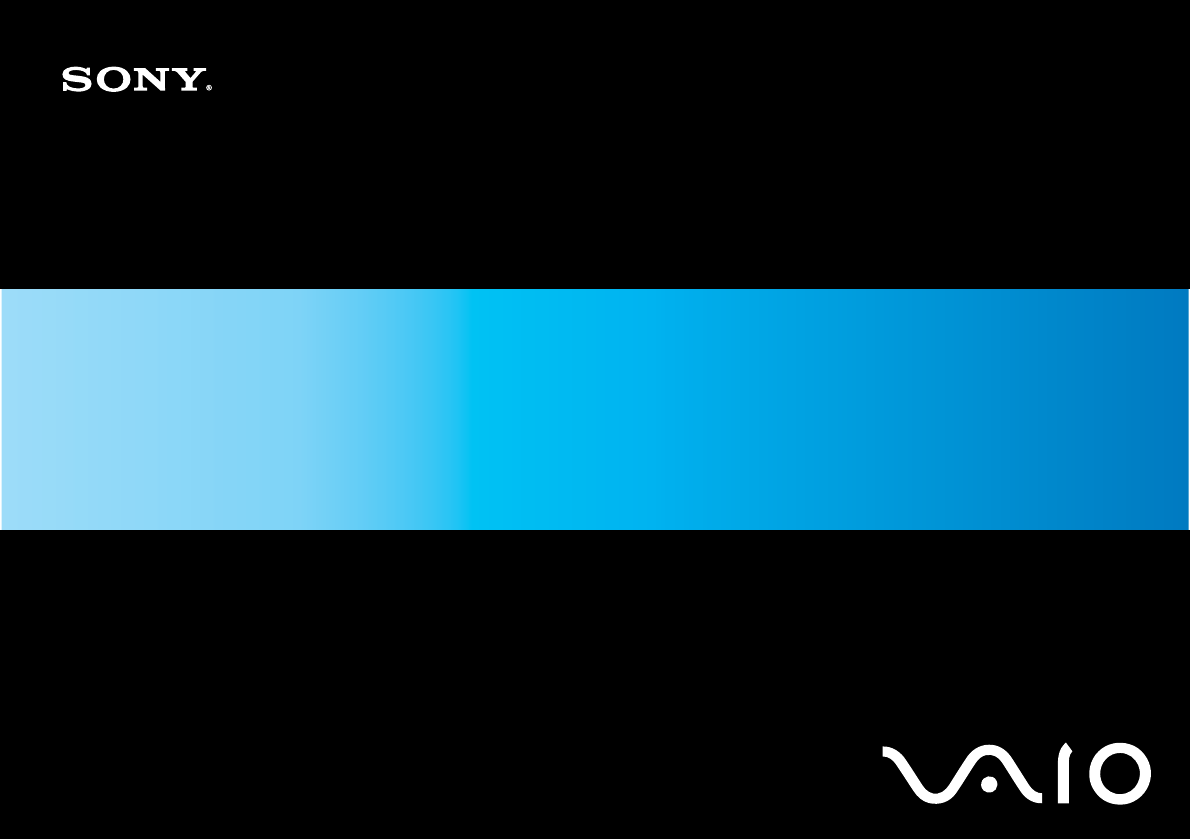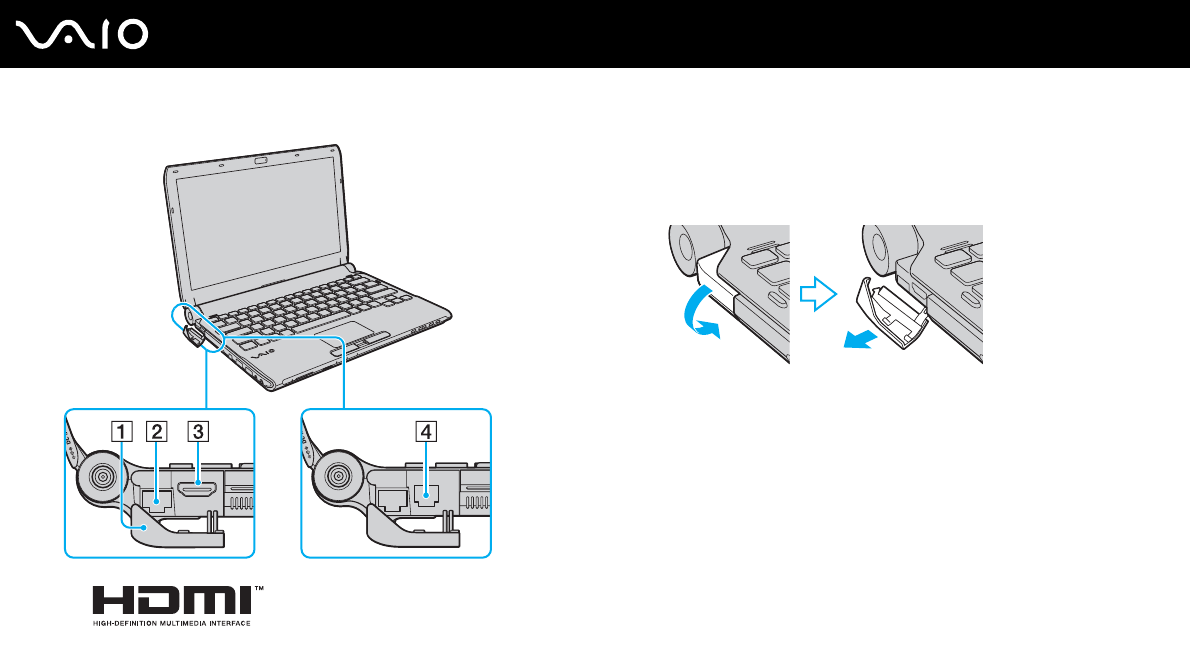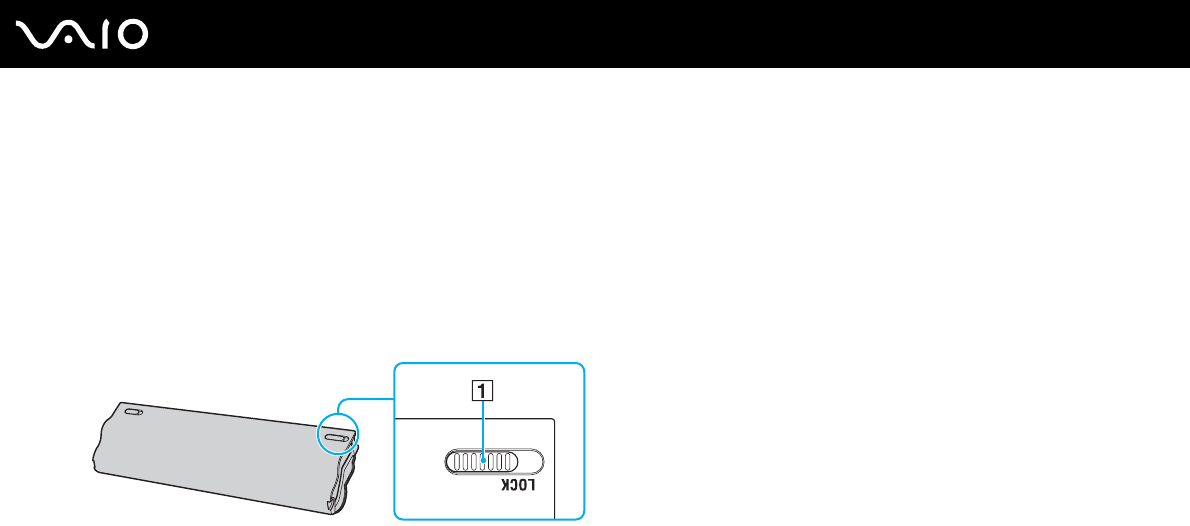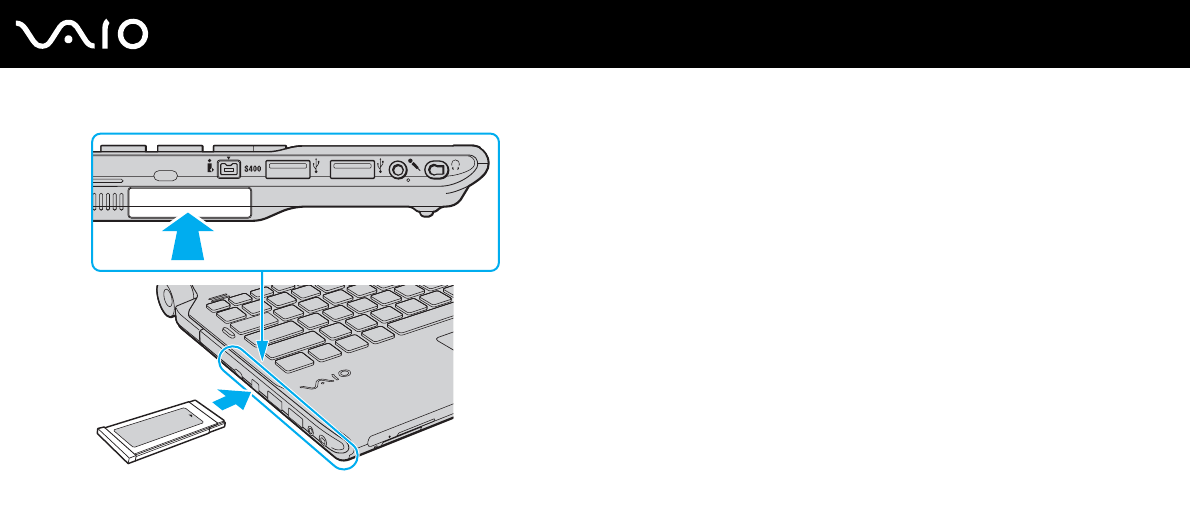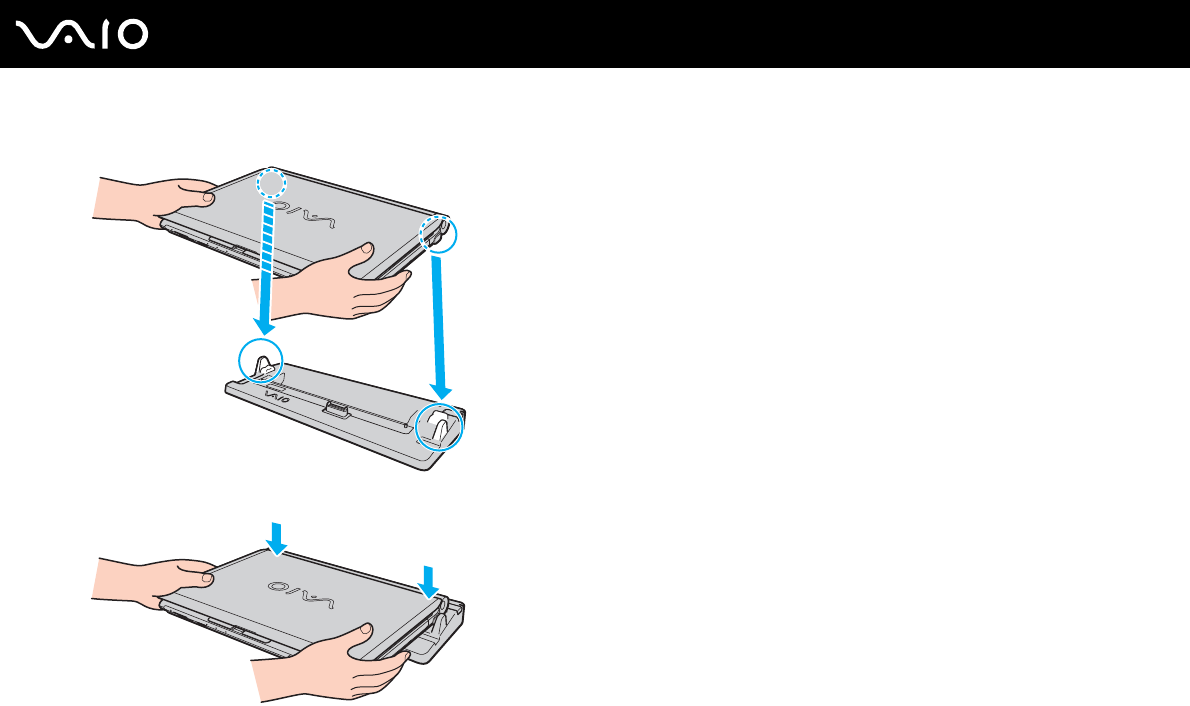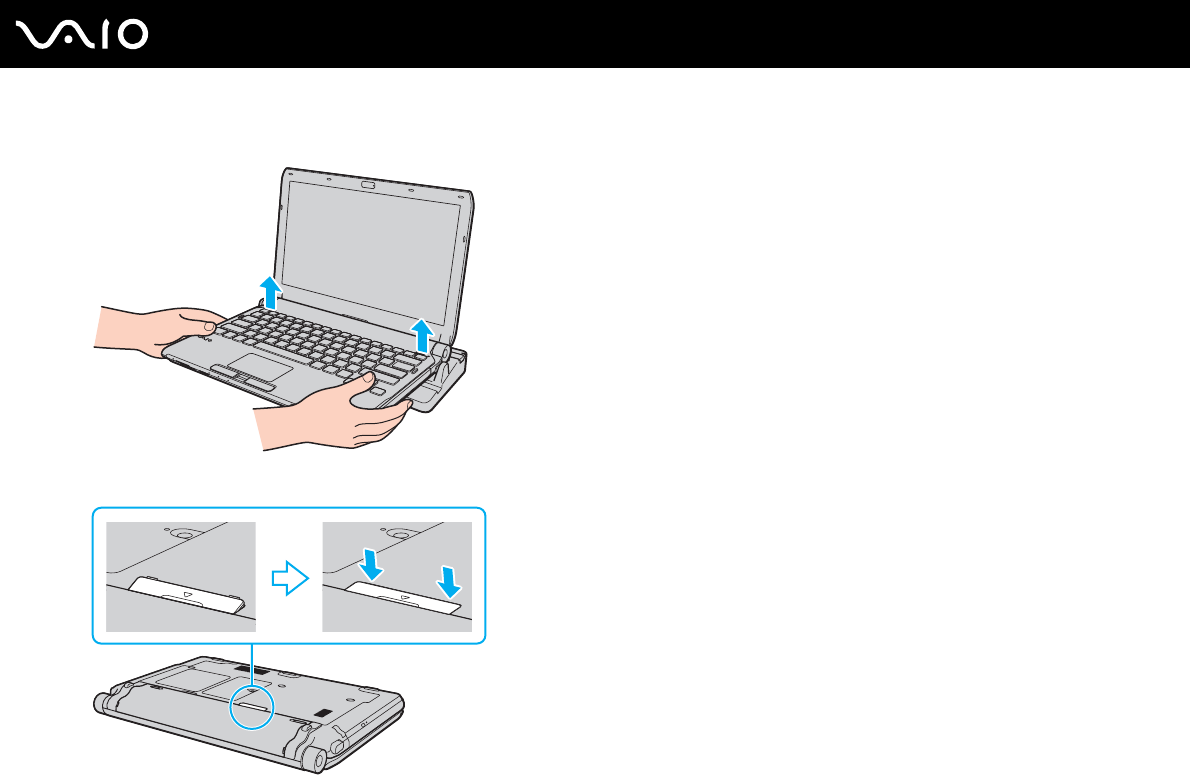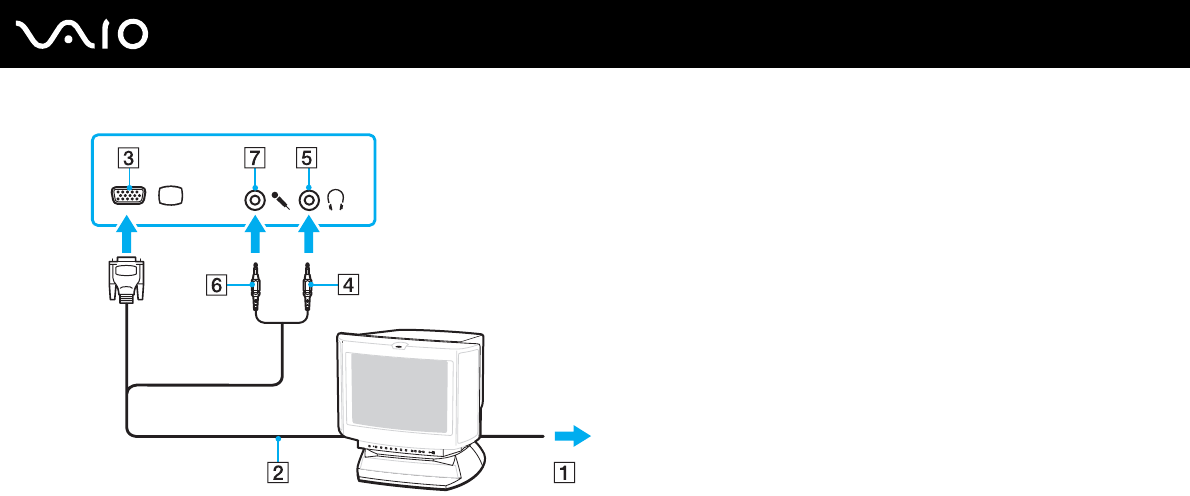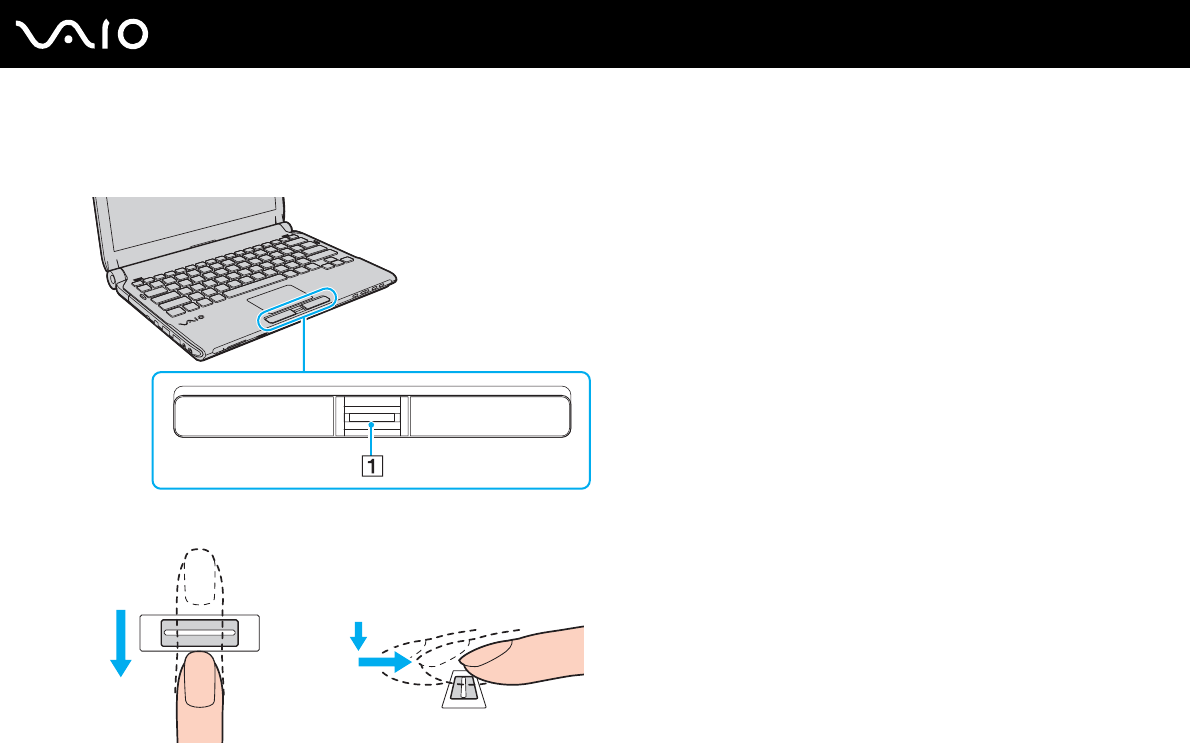Sony Group PCG4R1L Notebook PC User Manual VGN TT200 Series
Sony Corporation Notebook PC VGN TT200 Series
Contents
- 1. User Manual
- 2. Safety Manual
User Manual

2
nN
Contents
Before Use .........................................................................................................................................................................6
Notice...........................................................................................................................................................................7
ENERGY STAR ...............................................................................................................................................................8
Documentation.............................................................................................................................................................9
Ergonomic Considerations.........................................................................................................................................13
Getting Started .................................................................................................................................................................15
Locating Controls and Ports.......................................................................................................................................16
About the Indicator Lights ..........................................................................................................................................23
Connecting a Power Source ......................................................................................................................................24
Using the Battery Pack ..............................................................................................................................................25
Shutting Down Your Computer Safely .......................................................................................................................33
Using Your VAIO Computer .............................................................................................................................................34
Using the Keyboard ...................................................................................................................................................35
Using the Touch Pad .................................................................................................................................................36
Using Special-function Buttons ..................................................................................................................................37
Using the Built-in MOTION EYE Camera...................................................................................................................38
Using the Optical Disc Drive ......................................................................................................................................41
Using the ExpressCard Module .................................................................................................................................51
Using the Memory Stick .............................................................................................................................................55
Using the SD Memory Card .......................................................................................................................................61
Using the Internet.......................................................................................................................................................64

3
nN
Using the Network (LAN) ...........................................................................................................................................66
Using the Wireless LAN (WLAN) ...............................................................................................................................68
Using the Bluetooth Function .....................................................................................................................................71
Using Peripheral Devices.................................................................................................................................................76
Using the Noise Canceling Headphones ...................................................................................................................77
Connecting a Docking Station....................................................................................................................................83
Connecting an Optical Disc Drive ..............................................................................................................................91
Connecting External Speakers ..................................................................................................................................93
Connecting an External Display.................................................................................................................................94
Selecting Display Modes..........................................................................................................................................102
Using the Multiple Monitors Function.......................................................................................................................103
Connecting an External Microphone........................................................................................................................105
Connecting a Universal Serial Bus (USB) Device....................................................................................................106
Connecting a Printer ................................................................................................................................................109
Connecting an i.LINK Device ...................................................................................................................................110
Customizing Your VAIO Computer ................................................................................................................................112
Setting the Password ...............................................................................................................................................113
Using Fingerprint Authentication..............................................................................................................................125
Using the Trusted Platform Module (TPM)...............................................................................................................133
Setting Up Your Computer with the VAIO Control Center........................................................................................143
Using the Power Saving Modes...............................................................................................................................144
Managing Power with the VAIO Power Management ..............................................................................................149
Protecting the Hard Disk ..........................................................................................................................................151

4
nN
Upgrading Your VAIO Computer....................................................................................................................................152
Adding and Removing Memory................................................................................................................................153
Precautions ....................................................................................................................................................................160
Handling the LCD Screen ........................................................................................................................................161
Using the Power Source ..........................................................................................................................................162
Handling Your Computer .........................................................................................................................................163
Handling the Built-in MOTION EYE Camera............................................................................................................166
Handling Floppy Disks .............................................................................................................................................167
Handling Discs .........................................................................................................................................................168
Using the Battery Pack ............................................................................................................................................169
Using Headphones ..................................................................................................................................................171
Handling the Memory Stick ......................................................................................................................................172
Handling the Hard Disk ............................................................................................................................................173
Updating Your Computer .........................................................................................................................................174
Troubleshooting .............................................................................................................................................................175
Computer .................................................................................................................................................................177
System Security .......................................................................................................................................................185
Battery......................................................................................................................................................................186
Built-in MOTION EYE Camera.................................................................................................................................188
Internet.....................................................................................................................................................................190
Networking ...............................................................................................................................................................192
Bluetooth Technology ..............................................................................................................................................195
Optical Discs ............................................................................................................................................................199
Display .....................................................................................................................................................................204

5
nN
Printing.....................................................................................................................................................................208
Microphone ..............................................................................................................................................................209
Mouse ......................................................................................................................................................................210
Speakers..................................................................................................................................................................211
Touch Pad................................................................................................................................................................213
Keyboard..................................................................................................................................................................214
Floppy Disks ............................................................................................................................................................215
Audio/Video..............................................................................................................................................................216
Memory Stick ...........................................................................................................................................................220
Peripherals...............................................................................................................................................................221
Docking Station........................................................................................................................................................222
Support Options .............................................................................................................................................................223
Sony Support Information ........................................................................................................................................223
Trademarks ....................................................................................................................................................................227

6
nN
Before Use
Before Use
Congratulations on your purchase of this Sony VAIO® computer, and welcome to the on-screen User Guide. Sony has
combined leading-edge technology in audio, video, computing, and communications to provide state-of-the-art personal
computing experience.
!
External views illustrated in this manual may look slightly different from those of your computer.
Information in the supplied manuals including this User Guide is intended for users of the VAIO computers with the Microsoft® Windows Vista®
32-bit operating system. You may find differences in the information when your computer comes preinstalled with the 64-bit operating system.

7
nN
Before Use
Notice
© 2009 Sony Corporation. All rights reserved.
This manual and the software described herein, in whole or in part, may not be reproduced, translated, or reduced to any
machine-readable form without prior written approval.
Sony Corporation provides no warranty with regard to this manual, the software, or other information contained herein and
hereby expressly disclaims any implied warranties or merchantability or fitness for any particular purpose with regard to this
manual, the software, or such other information. In no event shall Sony Corporation be liable for any incidental, consequential,
or special damages, whether based on tort, contract, or otherwise, arising out of or in connection with this manual, the
software, or other information contained herein or the use thereof.
In the manual, the ™ or ® marks are not specified.
Sony Corporation reserves the right to make any modification to this manual or the information contained herein at any time
without notice. The software described herein is governed by the terms of a separate user license agreement.
Sony Corporation is not liable and will not compensate for any lost recordings made to your computer, external recording
media, or recording devices or any relevant losses, including when recordings are not made due to reasons including your
computer failure, or when the contents of a recording are lost or damaged as a result of your computer failure or repair
undertaken to your computer. Sony Corporation will not restore, recover, or replicate the recorded contents made to your
computer, external recording media, or recording devices under any circumstances.

8
nN
Before Use
ENERGY STAR
As an ENERGY STAR Partner, Sony has determined that this product meets the ENERGY STAR guidelines for energy
efficiency.
The International ENERGY STAR Office Equipment Program is an international program that promotes energy saving
through the use of computers and office equipment. The program backs the development and dissemination of products with
functions that effectively reduce energy consumption.
For detailed information on the ENERGY STAR Program, visit the following web sites:
❑http://www.energystar.gov (USA)
❑http://www.eu-energystar.org (Europe)
This computer is designed in compliance with the ENERGY STAR standards and delivered with the following power saving
settings:
❑The LCD backlight is turned off automatically after about 15 minutes of inactivity.
❑The computer enters Sleep mode automatically after about 30 minutes of inactivity.
Press any key to bring the computer back into Normal mode.
For detailed information on power saving modes, see Using the Power Saving Modes (page 144).

9
nN
Before Use
Documentation
Your documentation includes printed information and user guides to read on your VAIO computer.
Printed Documentation
❑Quick Start Guide — Contains an overview of components connection, set-up information, etc.
❑Safety Information — Contains safety guidelines and owner information.

10
nN
Before Use
Non-printed Documentation
❑User Guide (this manual) — Explains features of your computer. It also includes information on solving common
problems.
✍
To go to web sites described in this manual by clicking their respective URLs beginning with http://, your computer must be connected to the Internet.
❑Specifications — The online specifications describe the hardware and software configurations of your VAIO computer.
To view the online specifications:
1Connect to the Internet.
2Go to the Sony online support web site at the following URLs:
http://esupport.sony.com/EN/VAIO/ for customers in USA
http://www.sony.ca/support/ for customers in Canada
http://esupport.sony.com/LA/ for customers in Spanish-speaking Latin American countries or areas
http://esupport.sony.com/BR/ for customers in Brazil
❑VAIO Recovery Center User Guide — Provides information about restoring individual software programs, hardware
drivers, and drive partition(s) or your entire built-in storage device to the original factory settings.
To access this on-screen guide:
1Click Start and Help and Support.
2Click Use my VAIO.
3Click VAIO Recovery Center User Guide.

11
nN
Before Use
❑SmartWi™ Connection Utility Help (Selected models only) — Provides information about setting up Bluetooth®*,
wireless LAN, GPS*, and wireless WAN* functions.
To access this on-screen guide:
1Click Start, All Programs, and SmartWi Connection Utility.
2Click SmartWi Connection Utility Help.
* Available on selected models only. See the online specifications to find out whether your model supports the Bluetooth and wireless WAN functions.
❑RAID Guide (Selected models only) — Provides information about using RAID systems.
To access this on-screen guide:
1Click Start and Help and Support.
2Click Use my VAIO.
3Click Other Documents.

12
nN
Before Use
Help and Support
Help and Support is easy to access and provides a single location for general information and technical assistance for your
VAIO computer. Choose from the following categories to find the answers you need.
To access Help and Support, click Start and Help and Support.
❑Get started with my VAIO
Get help with Internet and wireless setup, security setup, personalizing your VAIO computer, and creating recovery DVDs
and more.
❑Use my VAIO
Access your VAIO user guide, interactive help in the form of VAIO tutorials, how-to articles, the VAIO technology page,
specifications, and system and software information.
❑Troubleshoot my VAIO
Maintain and troubleshoot your VAIO computer with VAIO Care, system restore, backup and recovery, and contact Sony
support.
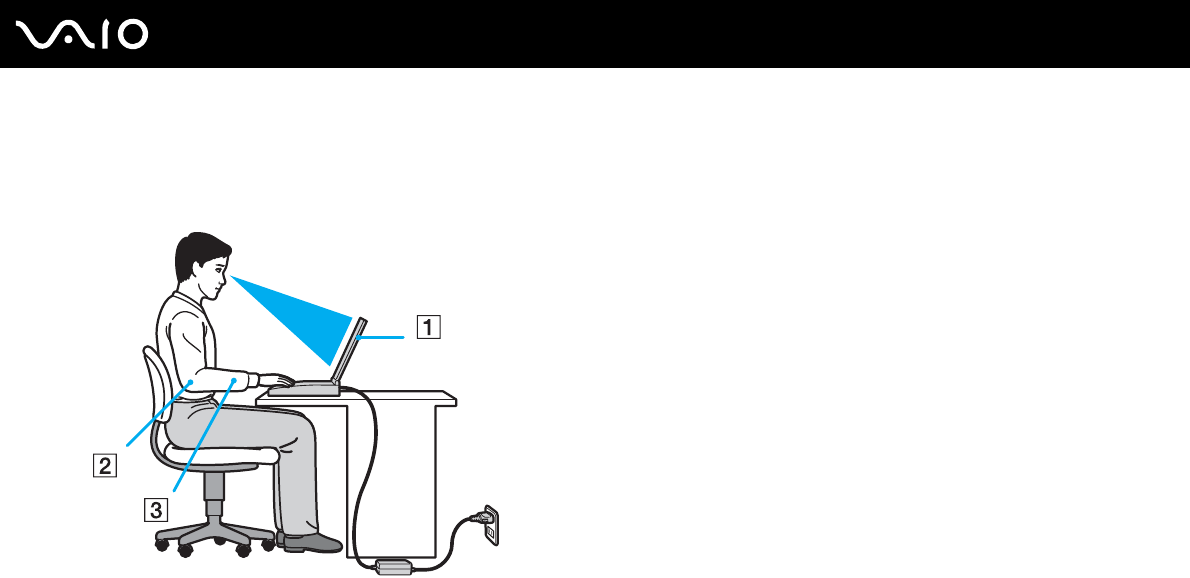
13
nN
Before Use
Ergonomic Considerations
You will be using your computer as a portable device in a variety of environments. Whenever possible, you should attempt
to take account of the following ergonomic considerations for both stationary and portable environments:
❑Position of your computer – Place the computer directly in front of you (1). Keep your forearms horizontal (2), with your
wrists in a neutral, comfortable position (3) while using the keyboard, touch pad, or external mouse. Let your upper arms
hang naturally at your sides. Take frequent breaks while using your computer. Excessive use of the computer may strain
eyes, muscles, or tendons.
❑Furniture and posture – Sit in a chair with good back support. Adjust the level of the chair so your feet are flat on the
floor. A footrest may make you more comfortable. Sit in a relaxed, upright posture and avoid slouching forward or leaning
far backwards.

14
nN
Before Use
❑Viewing angle of the computer's display – Use the display's tilting feature to find the best position. You can reduce eye
strain and muscle fatigue by adjusting the tilt of the display to the proper position. Adjust the brightness level of the display
as well.
❑Lighting – Choose a location where windows and lights do not cause glare and reflection on the display. Use indirect
lighting to avoid bright spots on the display. Proper lighting adds to your comfort and work efficiency.
❑Positioning an external display – When using an external display, set the display at a comfortable viewing distance.
Make sure the display screen is at eye level or slightly lower when you are sitting in front of the monitor.

15
nN
Getting Started
Getting Started
This section describes how to get started with using your VAIO computer.
!
Before starting your computer for the first time, do not connect any other hardware that did not originally come with your computer. Be sure to start
up your computer with only the supplied accessories connected and set up your system. Upon completion, connect one device (for example, a printer,
an external hard disk drive, a scanner, and so on) at a time, following the manufacturers' instructions.
❑Locating Controls and Ports (page 16)
❑About the Indicator Lights (page 23)
❑Connecting a Power Source (page 24)
❑Using the Battery Pack (page 25)
❑Shutting Down Your Computer Safely (page 33)
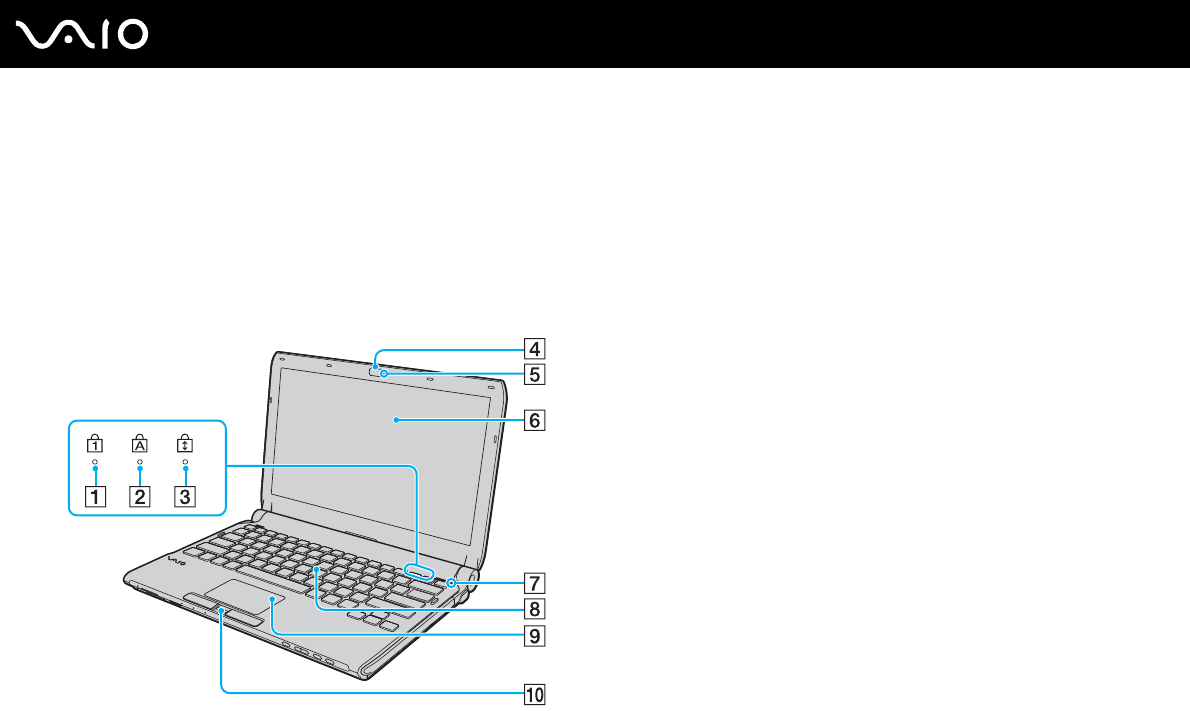
16
nN
Getting Started
Locating Controls and Ports
Take a moment to identify the controls and ports shown on the following pages.
!
The appearance of your computer may be different from those illustrated in this manual due to variations in specifications. It may also vary in some
countries or areas.
Front
ANum lock indicator (page 23)
BCaps lock indicator (page 23)
CScroll lock indicator (page 23)
DBuilt-in MOTION EYE camera* (page 38)
EBuilt-in MOTION EYE camera indicator* (page 23)
FLCD screen (page 161)
GAmbient light sensor (page 205)
Measures ambient light intensity for automatically adjusting the
LCD brightness to the optimum level.
HKeyboard (page 35)
ITouch pad (page 36)
JFingerprint sensor* (page 125)
* On selected models only.
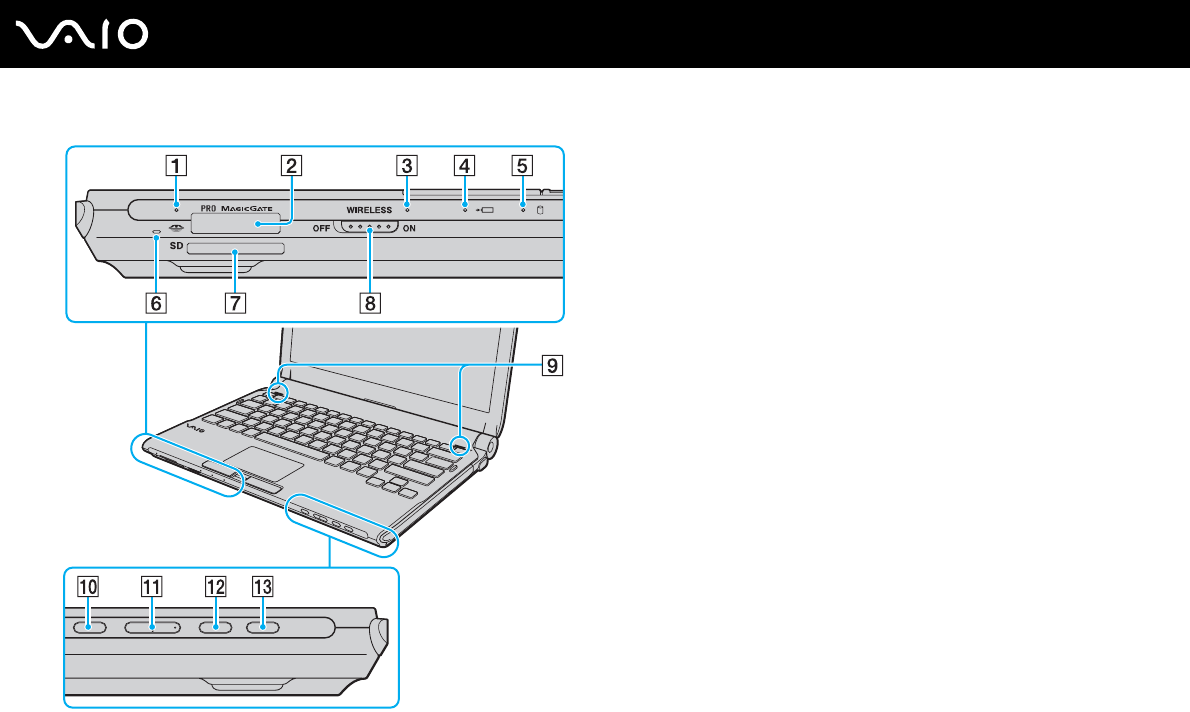
17
nN
Getting Started
AMedia Access indicator (page 23)
BMemory Stick slot*1 (page 55)
CWIRELESS indicator (page 23)
DCharge indicator (page 23)
EHard disk drive*2/Optical disc drive*3 indicator (page 23)
FBuilt-in microphone (monaural)
GSD memory card slot (page 61)
HWIRELESS switch (page 68)
IBuilt-in speakers (stereo)
JMuting button (page 37)
KVolume control buttons (page 37)
LS1 button (page 37)
MDrive eject button*3 (page 37), (page 41)/S2 button*4 (page 37)
*1 Your computer supports both the standard-size Memory Stick and the Duo-
size Memory Stick.
*2 The storage device configuration of your computer may include a built-in
flash memory storage drive depending on the model you purchased. See the
online specifications to find out about your configuration.
*3 On models with a built-in optical disc drive.
*4 On models without a built-in optical disc drive.
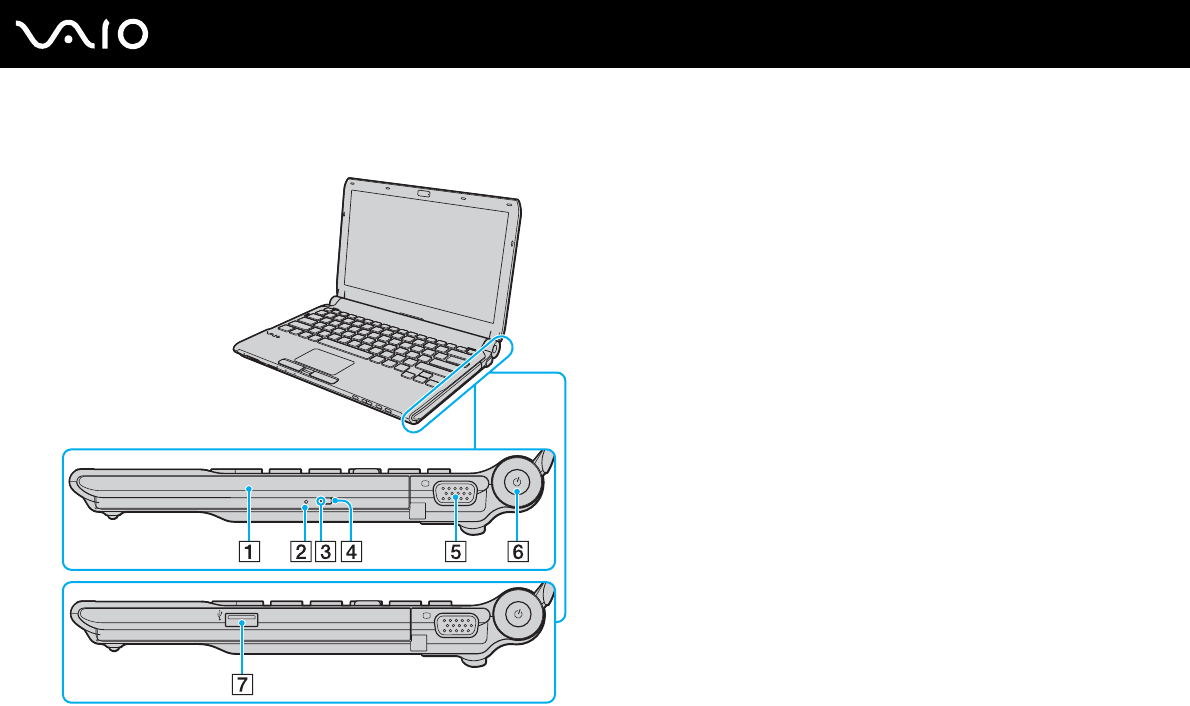
19
nN
Getting Started
Right
AOptical disc drive*1 (page 41)
BManual eject hole*2 (page 199)
COptical disc drive indicator*2 (page 23)
DSubstitute drive eject button*2 (page 41)
EMonitor port (page 95)
FPower button/Power indicator (page 23)
GHi-Speed USB (USB 2.0) port*3 *4 (page 106)
*1 On selected models only.
*2 On models with a built-in optical disc drive.
*3 Supports high-/full-/low- speeds.
*4 On models without a built-in optical disc drive.
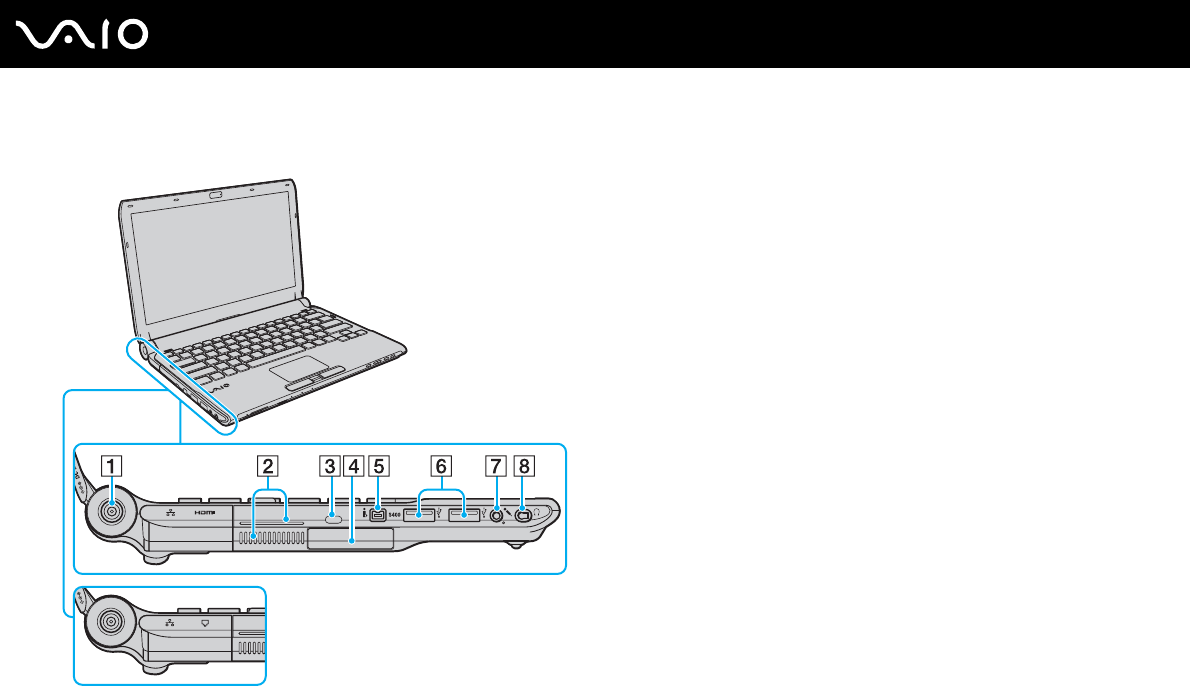
20
nN
Getting Started
Left
ADC IN port (page 24)
BAir vents
CSecurity slot
DExpressCard/34 slot (page 51)
Ei.LINK 4-pin (S400) port (page 110)
FHi-Speed USB (USB 2.0) ports*1 (page 106)
GMicrophone jack (page 105)
HHeadphones jack*2 (page 93), (page 77)
*1 Support high-/full-/low- speeds.
*2 The headphones jack in this shape is equipped on models with the noise
canceling headphones supplied. Otherwise, the ordinary round-shaped jack
is equipped. Although you can connect headphones or speakers with a
stereo mini-plug to the jack in this shape, it is recommended that you
connect the supplied noise canceling headphones to take full advantage of
the built-in noise canceling function.

23
nN
Getting Started
About the Indicator Lights
Your computer is equipped with the following indicator lights:
Indicator Functions
Power 1Illuminates in green when the computer is on, blinks slowly in orange while the computer is in Sleep mode, and
turns off when the computer is off or in Hibernate mode.
Charge Illuminates while the battery pack is charging. See Charging the Battery Pack (page 28) for more information.
Built-in MOTION EYE camera*1 Illuminates while the built-in MOTION EYE camera is in use.
Media Access Illuminates while data is being read from or written to a memory card. (Do not place the computer into Sleep
mode or turn it off when this indicator is lit.) When the indicator is unlit, the memory card is not in use.
Optical disc drive*1 Illuminates while the drive is reading or writing data. When the indicator is unlit, the optical disc media is not in
use.
Hard disk drive*2
/Optical disc drive*1
Illuminates while the drive is reading or writing data. Do not place the computer into Sleep mode or turn it off
when this indicator is lit.
Num lock Press the Num Lk key to activate the numeric keypad. Press it a second time to deactivate the numeric keypad.
The numeric keypad is not active when the indicator is unlit.
Caps lock Press the Caps Lock key to type letters in uppercase. Letters appear in lowercase if you press the Shift key
while the indicator is lit. Press the key a second time to turn off the indicator. Normal typing resumes when the
Caps lock indicator is unlit.
Scroll lock Press the Fn+Scr Lk keys to change how you scroll the display. Normal scrolling resumes when the Scroll lock
indicator is unlit. The Scr Lk key functions differently depending on the program you are using and does not
work with all programs.
WIRELESS Illuminates when the WIRELESS switch is turned on.
*1 On selected models only.
*2 The storage device configuration of your computer may include a built-in flash memory storage drive depending on the model you purchased. See the online
specifications to find out about your configuration.
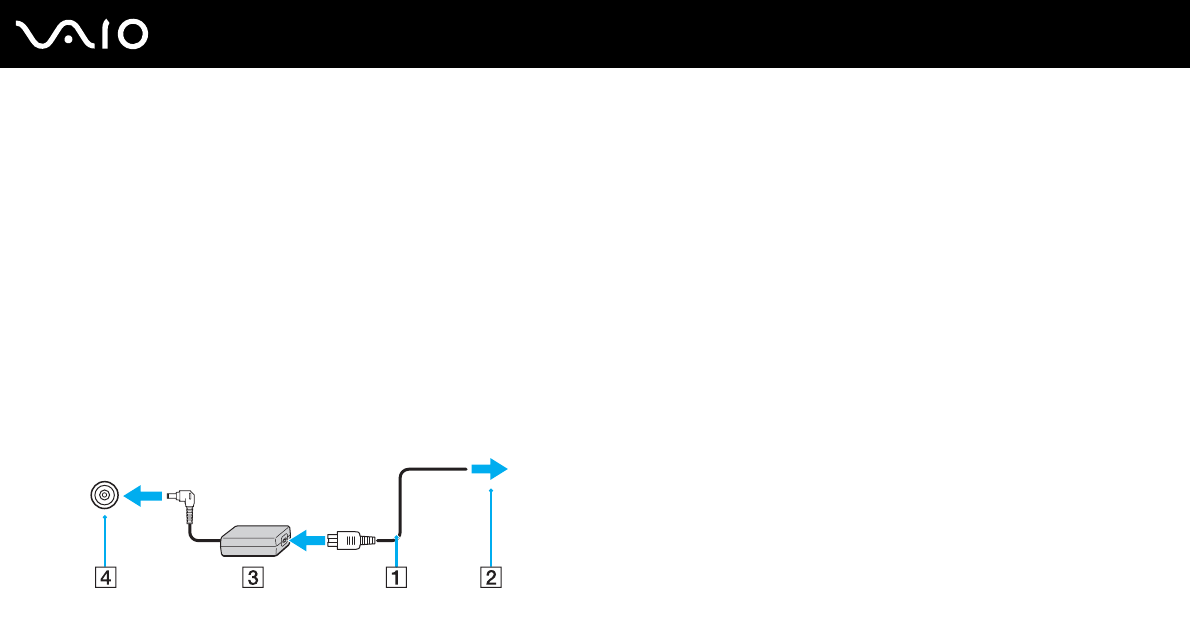
24
nN
Getting Started
Connecting a Power Source
You can use either an AC adapter or a rechargeable battery pack for supplying power to your computer.
Using the AC Adapter
✍
Use only the supplied AC adapter for your computer.
To use the AC adapter
1Plug one end of the power cord (1) into the AC adapter (3).
2Plug the other end of the power cord into an AC outlet (2).
3Plug the cable connected to the AC adapter (3) into the DC IN port (4) on the computer or on the optional docking station.
✍
To disconnect your computer completely from AC power, unplug the AC adapter.
Make sure that the AC outlet is easily accessible.
If you do not intend to use your computer for a long period of time, place the computer into Hibernate mode. See Using Hibernate Mode (page 147).
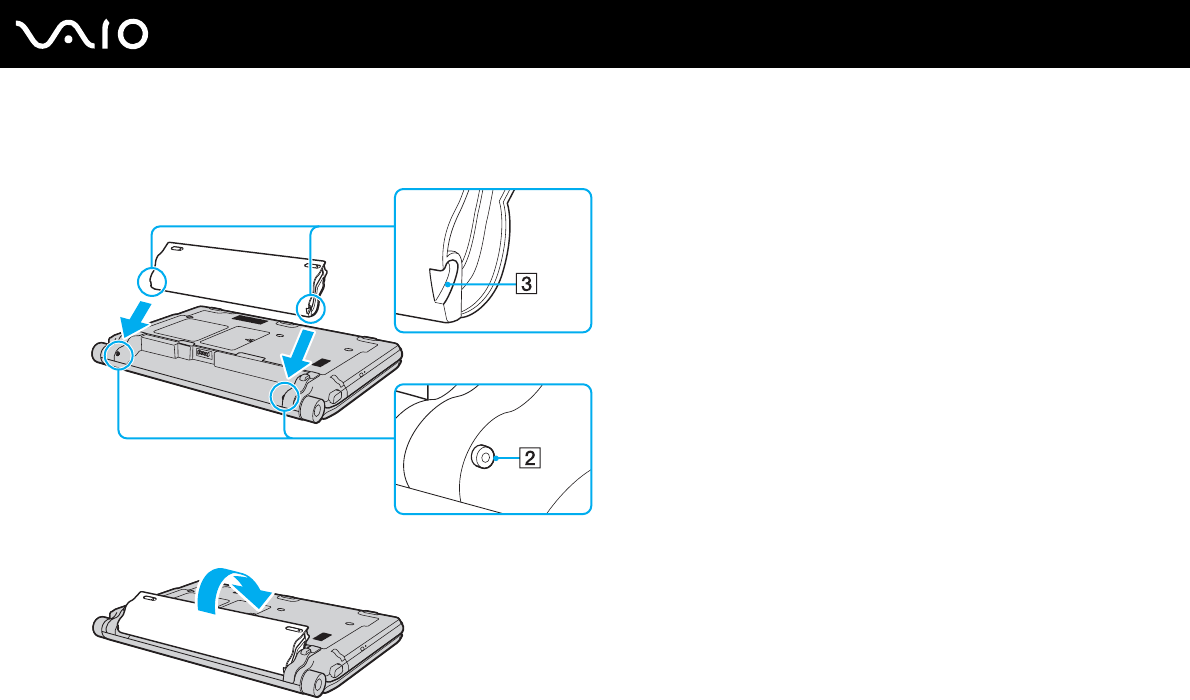
26
nN
Getting Started
3Slide the battery pack diagonally into the battery compartment until the projections (2) on either side of the battery
compartment fit into the U-shaped cuts (3) on either side of the battery pack.
4Push the battery pack down into the compartment until it clicks into place.
5Slide the battery LOCK switch outward to secure the battery pack on the computer.

28
nN
Getting Started
Charging the Battery Pack
The battery pack supplied with your computer is not fully charged at the time of delivery.
To charge the battery pack
1Install the battery pack.
2Connect the computer to a power source with the AC adapter.
The charge indicator light turns on while the battery pack is charging. When the battery pack charges close to the
maximum charge level you selected with the battery charge functions, the charge indicator turns off. To select your desired
maximum charge level, see Using the Battery Charge Functions (page 30).
!
Charge the battery pack as described in this manual from your first battery charge.
Charge indicator status Meaning
Lit in orange The battery pack is charging.
Blinks along with the green power
indicator
The battery pack is running out of power. (Normal
mode)
Blinks along with the orange power
indicator
The battery pack is running out of power. (Sleep mode)
Blinks fast in orange A battery error has occurred due to a failed battery
pack or an unlocked battery pack.

29
nN
Getting Started
✍
Keep the battery pack in your computer while it is directly connected to AC power. The battery pack continues to charge while you are using the
computer.
If the battery charge level falls below 10%, you should either connect the AC adapter to recharge the battery pack or shut down your computer and
install a fully charged battery pack.
Your computer is supplied with a lithium ion battery pack and can be recharged any time. Charging a partially discharged battery pack does not affect
the life of battery.
While some software applications or peripheral devices are in use, your computer may not enter Hibernate mode even when the remaining battery life
is short. To avoid loss of data when using battery power, you should save your data frequently and manually activate a power management mode, such
as Sleep or Hibernate.
If the battery pack wears out when the computer enters Sleep mode, you will lose all unsaved data. Going back to the previous work state is impossible.
To avoid loss of data, you should save your data frequently.
When your computer is directly connected to AC power and has a battery pack installed, it uses power from the AC outlet.

30
nN
Getting Started
Using the Battery Charge Functions
You can customize the current battery charging method using the Battery Charge Functions: the battery care function and
the quick charge function. The battery care function makes the life of battery longer, and the quick charge function allows you
to charge your battery pack quickly.
To enable the battery care function and the quick charge function
1Click Start, All Programs, and VAIO Control Center.
2Click Power Management and then Battery Charge Functions.
3Click to select the Enable Quick Charge Function check box in the right pane and click Apply.
4Click Advanced.
5Click to select the Enable Battery Care Function check box.
6Select the desired maximum charge level.
7Click OK.
✍
Alternatively, you can press the S1 button to launch the VAIO Power Management Viewer and enable the functions.
To check the battery charge capacity
Follow steps 1 and 2 in To enable the battery care function and the quick charge function above, click Advanced, and
check detailed information. If the battery charge capacity is low, replace the battery pack with a new genuine Sony battery
pack.

31
nN
Getting Started
Using the Battery Life Conserving Wallpaper
You can conserve your battery life just by setting the specific wallpaper as your desktop background.
To set the battery life conserving wallpaper
1Click Start, All Programs, and VAIO Control Center.
2Click Display and then Long Battery Life Wallpaper Setting.
3Click Set Long Battery Life Wallpaper.
At the confirmation prompt, click OK.
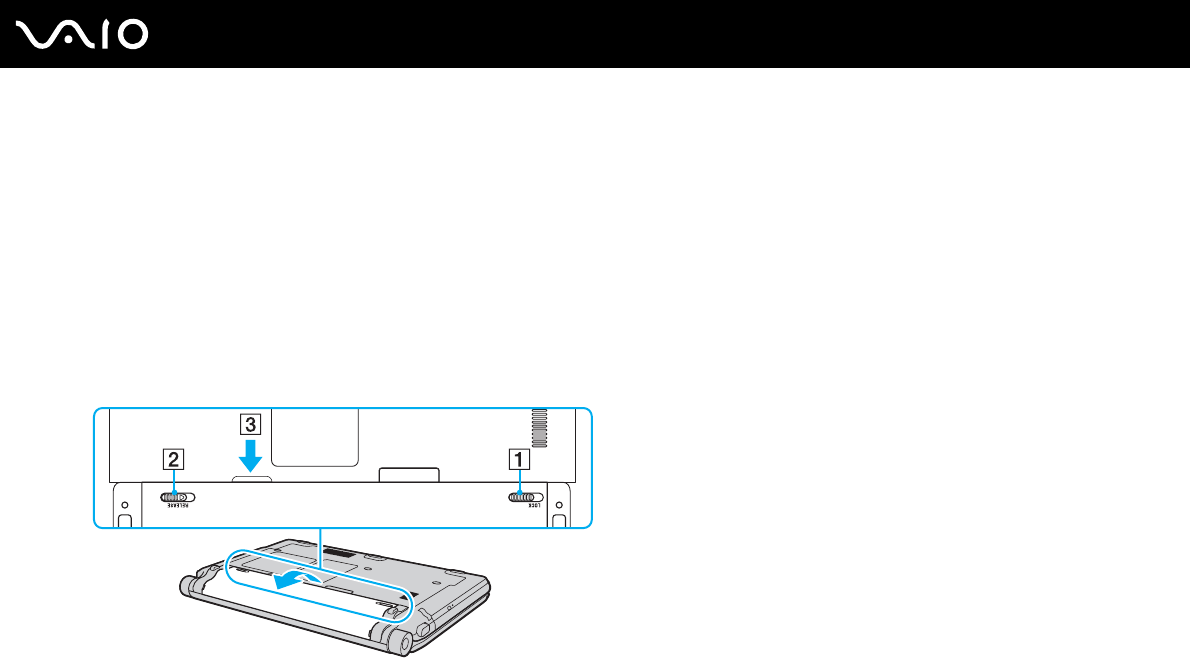
32
nN
Getting Started
Removing the Battery Pack
!
You may lose data if you remove the battery pack while your computer is on and not connected to the AC adapter or if you remove the battery pack
while the computer is in Sleep mode.
To remove the battery pack
1Turn off the computer and close the LCD screen lid.
2Slide the battery LOCK switch (1) inward.
3Slide and hold the battery RELEASE latch (2) inward, put your fingertip underneath the tab (3) on the battery pack, and
lift the battery pack in the direction of the arrow, and then slide it away from the computer.

33
nN
Getting Started
Shutting Down Your Computer Safely
To avoid losing unsaved data, be sure to shut down your computer properly, as described below.
To shut down your computer
1Turn off any peripherals connected to the computer.
2Click Start, the arrow next to the Lock button, and then Shut Down.
3Respond to any prompts warning you to save documents or to consider other users and wait for the computer to turn off
automatically.
The power indicator light turns off.

34
nN
Using Your VAIO Computer
Using Your VAIO Computer
This section describes how to get the most out of using your VAIO computer.
❑Using the Keyboard (page 35)
❑Using the Touch Pad (page 36)
❑Using Special-function Buttons (page 37)
❑Using the Built-in MOTION EYE Camera (page 38)
❑Using the Optical Disc Drive (page 41)
❑Using the ExpressCard Module (page 51)
❑Using the Memory Stick (page 55)
❑Using the SD Memory Card (page 61)
❑Using the Internet (page 64)
❑Using the Network (LAN) (page 66)
❑Using the Wireless LAN (WLAN) (page 68)
❑Using the Bluetooth Function (page 71)
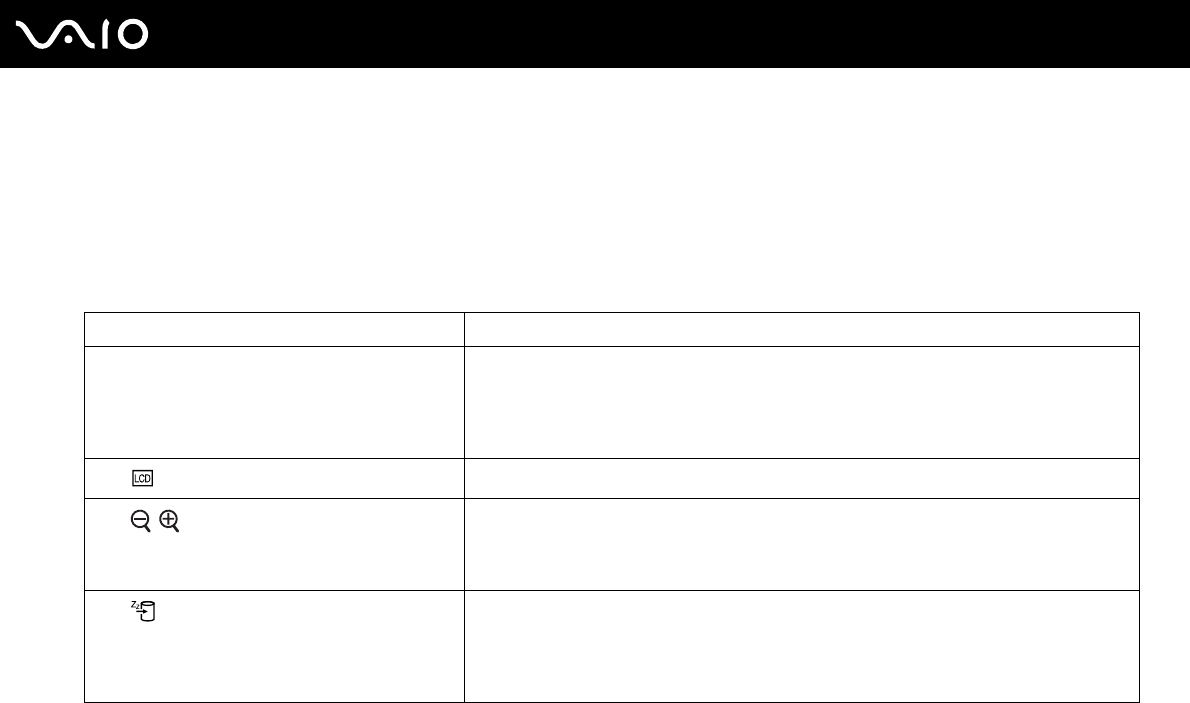
35
nN
Using Your VAIO Computer
Using the Keyboard
Your keyboard is very similar to a desktop computer keyboard, but has additional keys that perform model-specific tasks.
Combinations and Functions with the Fn Key
✍
Some keyboard functions can be used only after the operating system is finished launching.
Combinations/Feature Functions
Fn + 8 (F5/F6): brightness control Changes the LCD brightness of your computer screen.
To increase lighting intensity, keep pressing the Fn+F6 keys or press the Fn+F6 keys and then
the M or , key.
To decrease lighting intensity, keep pressing the Fn+F5 keys or press the Fn+F5 keys and then
the m or < key.
Fn + /T (F7): display output Toggles among your computer screen, an external display, and simultaneous output to both.
Fn + / (F9/F10): zoom Changes the size of an image or a document displayed on some software.
To make the view look smaller and further away (zoom out), press the Fn+F9 keys.
To make the view look bigger and closer (zoom in), press the Fn+F10 keys.
See the help file included with the VAIO Control Center for more information.
Fn + (F12): hibernate Provides the lowest level of power consumption. When you execute this command, the states
of the system and the connected peripheral devices are saved to the built-in storage device and
the system power is turned off. To return the system to its original state, use the power button
to turn on the power.
For details on power management, see Using the Power Saving Modes (page 144).
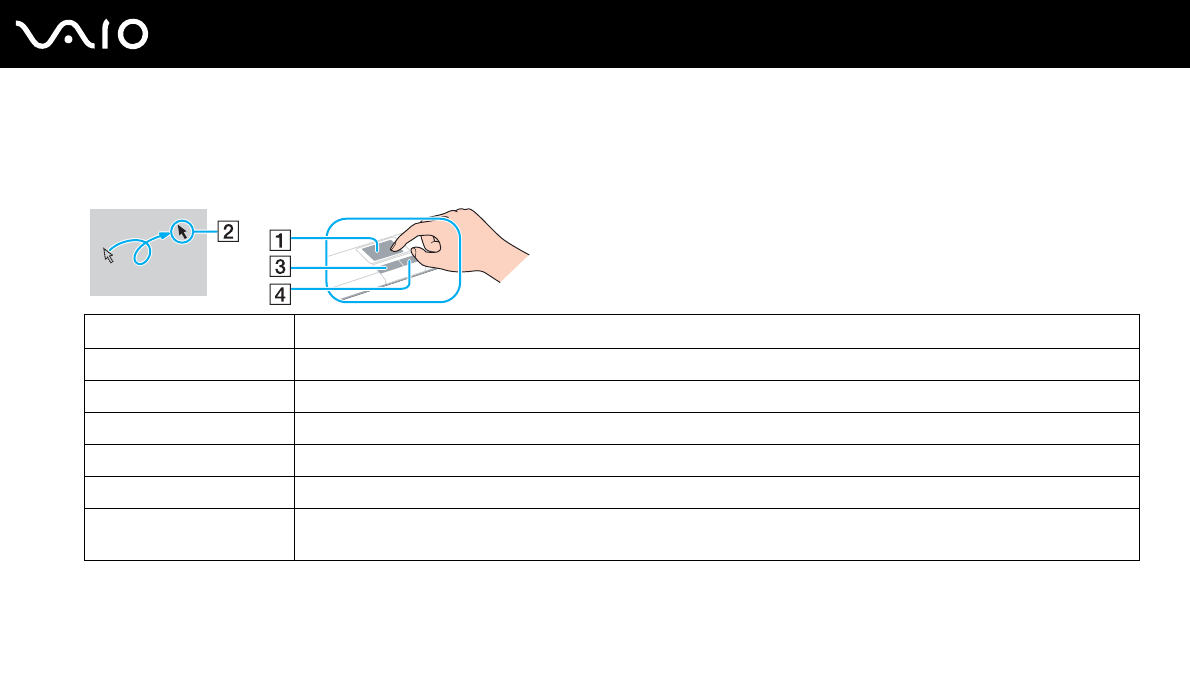
36
nN
Using Your VAIO Computer
Using the Touch Pad
You can point to, select, drag, and scroll objects on the screen using the touch pad.
✍
You can disable/enable the touch pad while a mouse is connected to your computer. To change the touch pad settings, click Start, All Programs, VAIO
Control Center, Keyboard and Mouse and Pointing Device.
!
Be sure to connect a mouse before disabling the touch pad. If you disable the touch pad before connecting a mouse, you will be able to use only the
keyboard for pointer operations.
Action Description
Point Slide your finger on the touch pad (1) to place the pointer (2) on an item or object.
Click Press the left button (3) once.
Double-click Press the left button twice.
Right-click Press the right button (4) once. In many applications, this action displays a shortcut menu.
Drag Slide your finger on the touch pad while pressing the left button.
Scroll Slide your finger along the right edge of the touch pad to scroll vertically. Slide your finger along the bottom edge to scroll
horizontally (the scroll function is available only with applications that support a touch pad scroll feature).

37
nN
Using Your VAIO Computer
Using Special-function Buttons
Your computer is equipped with special buttons to help you use specific functions of the computer.
Special-function button Functions
% Muting button Turns the volume on and off.
- 2 + Volume control buttons Decrease (-) and increase (+) the volume.
S1 button By default, the S1 button launches the VAIO Power Management Viewer.
✍
The default button assignment may be different from the above. To change the S1 button assignment, press and hold the
button or launch and navigate through the VAIO Control Center to display the setup window. See the help file included with
the VAIO Control Center for the S1 button assignment.
Z Drive eject button*1 Ejects the optical disc drive tray.
If this button does not work, try the substitute drive eject button on the optical disc drive.
S2 button*2 By default, the S2 button displays the VAIO Presentation Support window to select the display method in
Presentation mode between Mirror and Extend Desktop. Selecting any display method places your
computer into Presentation mode. In Presentation mode, some functions of the computer that may disturb a
presentation are disabled, such as a screen saver, the power saving modes, and system message
generation. In addition, you can use handy functions for the presentation, for example, displaying a document
for quick reference and the mirror image of the external display simultaneously on the computer. To bring the
computer back into Normal mode, press this button once again.
✍
The default button assignment may be different from the above. To change the S2 button assignment, press and hold the
button or launch and navigate through the VAIO Control Center to display the setup window. See the help file included with
the VAIO Control Center for the S2 button assignment.
To change the Presentation mode settings, click Start, Control Panel, Mobile PC, and Adjust settings before giving a
presentation under Windows Mobility Center, and change the settings in the Presentation Settings window.
*1 On models with a built-in optical disc drive.
*2 On models without a built-in optical disc drive.

38
nN
Using Your VAIO Computer
Using the Built-in MOTION EYE Camera
Your computer may be equipped with a built-in MOTION EYE camera. See the online specifications to find out whether your
model is equipped with the built-in MOTION EYE camera.
The built-in MOTION EYE camera adds video functionality to instant messaging software and video editing software and
enables you to capture still images and movies with the preinstalled image capture software.
Turning on the computer activates the built-in MOTION EYE camera. Video conference is possible with the appropriate
software.
Launching or exiting your instant messaging or video editing software does not activate or deactivate the built-in MOTION
EYE camera.
✍
The built-in MOTION EYE camera cannot be shared by more than one software application. If another software application is using the camera, exit the
application before using the built-in MOTION EYE camera with your desired application.
!
The viewer window may show some noise, for example horizontal streaks, if you view a rapid-moving object. This is normal and does not indicate a
malfunction.
You cannot operate the built-in MOTION EYE camera with the Microsoft Windows Movie Maker software.

39
nN
Using Your VAIO Computer
Capturing Still Images
To capture a still image
1Click Start, All Programs, ArcSoft WebCam Companion 2, and WebCam Companion 2 to launch the WebCam
Companion 2.
2Click the Capture icon in the main window.
3Frame your subject in the viewfinder.
4Click the Capture button below the displayed image.
The current image in the viewfinder is captured and its thumbnail image is added as a thumbnail in the left pane of the
main window.
✍
When capturing an image in a dark place, click the WebCam Settings icon after step 2 and select the low light or low light compensation option in the
properties window.
The WebCam Companion 2 provides many more features. See the help file included with the software for more information.

40
nN
Using Your VAIO Computer
Capturing Movies
To capture a movie
1Click Start, All Programs, ArcSoft WebCam Companion 2, and WebCam Companion 2 to launch the WebCam
Companion 2.
2Click the Record icon in the main window.
3Frame your subject in the viewfinder.
4Click the Record Video button below the displayed image to start movie recording.
5When finished, click the Record Video button once again to stop movie recording.
The first scene of the captured movie is added as a thumbnail in the left pane of the main window.
✍
When capturing a movie in a dark place, click the WebCam Settings icon after step 2 and select the low light or low light compensation option in the
properties window.
The WebCam Companion 2 provides many more features. See the help file included with the software for more information.

41
nN
Using Your VAIO Computer
Using the Optical Disc Drive
Your computer may be equipped with a built-in optical disc drive. See the online specifications to find out whether your model
is equipped with the optical disc drive.
To insert a disc
1Turn on the computer.
2Press the drive eject button (1) to open the drive.
The drive tray slides out.
✍
If the drive eject button does not work, try the substitute drive eject button on the optical disc drive.
If the power supply to the optical disc drive is disabled by the VAIO Power Management, it will take a while to eject the drive tray. The substitute drive
eject button is disabled when the optical disc drive is not powered.
When recovering your system, turn on your computer and press the substitute drive eject button on the optical disc drive. Insert your recovery disc
into the optical disc drive, turn off the computer, and then turn on the computer again to start the recovery process.
3Place a disc in the middle of the drive tray with the label side facing upward and gently push it down until the disc clicks
into place.
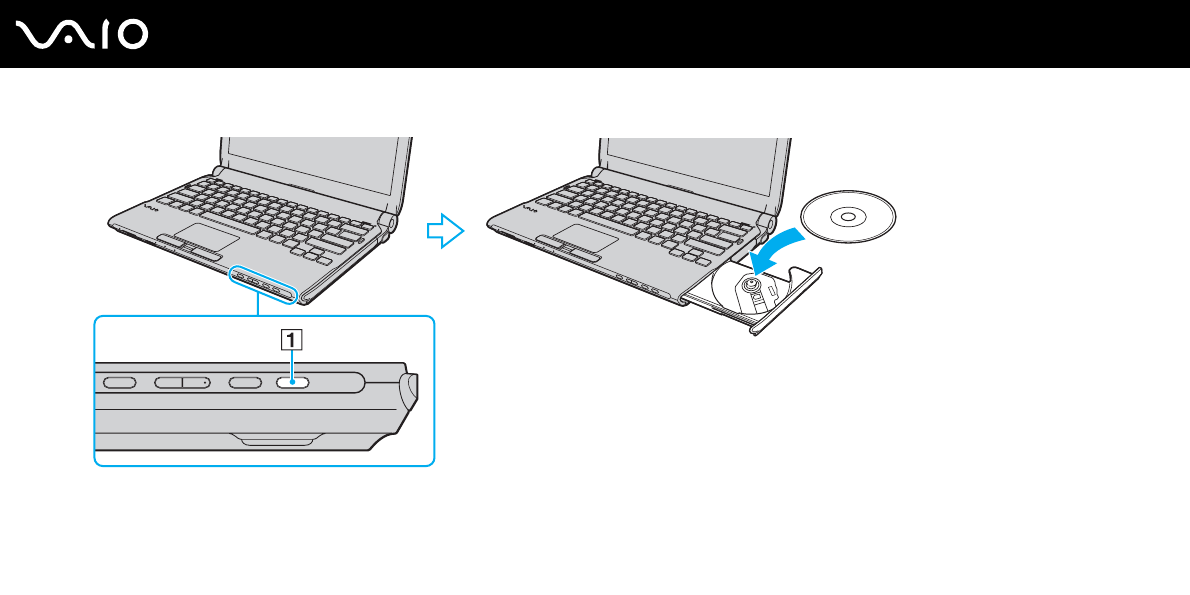
42
nN
Using Your VAIO Computer
4Close the drive tray by pushing it in gently.
!
Do not remove the optical disc when your computer is in a power saving mode (Sleep or Hibernate). Doing so may cause the computer to malfunction.
✍
If you use an external optical disc drive, connect the drive before you launch any preinstalled disc operation program.

43
nN
Using Your VAIO Computer
Reading and Writing Optical Discs
Your computer plays and records CDs, DVDs, and Blu-ray Disc™ media, depending on the model you purchased. Check your
specifications for the type of optical disc drive installed on your model.
Use the table below to see which types of media your optical disc drive supports.

44
nN
Using Your VAIO Computer
PR: playable and recordable
P: playable but not recordable
–: not playable or recordable
CD-
ROM
Video
CD
Music
CD
CD
Extra
CD-R/
RW
DVD-
ROM
DVD-
Video
BD-
ROM
DVD-R/
RW
DVD+R/
RW
DVD+R
DL
DVD-R
DL
DVD-
RAM
BD-R*8/RE*9
DVD±RW/
±R DL/RAM
PPPPPRPP–PR*1 *2 PR PR*5 PR*6 PR*3 *4 –
Blu-ray Disc
Combo
PPPPPRPPPPR*1 *2 PR PR*5 PR*6 PR*3 *4 P
Blu-ray DiscPPPPPRPPPPR*1 *2 PR P P PR*3 *4 PR*7 *10
*1 Supports writing data to DVD-R discs compliant with DVD-R for General Version 2.0/2.1.
*2 Supports writing data to DVD-RW discs compliant with DVD-RW Version 1.1/1.2.
*3 The DVD±RW/RAM disc drive on your computer does not support the DVD-RAM cartridge. Use non-cartridge discs or discs with a removable cartridge.
*4 Writing data to single-sided DVD-RAM discs (2.6 GB) compliant with DVD-RAM Version 1.0 is not supported.
DVD-RAM Version 2.2/12X-SPEED DVD-RAM Revision 5.0 disc is not supported.
*5 Writing data to DVD+R DL (Double Layer) discs is available only on discs supporting DVD+R DL (Double Layer) recording.
*6 Writing data to DVD-R DL (Dual Layer) discs is available only on discs supporting DVD-R DL (Dual Layer) recording.
*7 Supports writing data to BD-R Version 1.1 discs (single-layer discs with the capacity of 25 GB, dual-layer discs with the capacity of 50 GB) and BD-RE Version 2.1
discs (single-layer discs with the capacity of 25 GB, dual-layer discs with the capacity of 50 GB).
*8 BD-R stands for Blu-ray Disc-Recordable in Version 1.1 format.
*9 BD-RE stands for Blu-ray Disc-Rewritable in Version 2.1 format.
*10 The Blu-ray Disc drive on your computer does not support BD-RE Disc media in Version 1.0 format and Blu-ray Disc media with a cartridge.

45
nN
Using Your VAIO Computer
!
This product is designed to play back discs that conform to the Compact Disc Digital Audio standard specifications (CD Standard). A DualDisc is a two
sided disc product with a DVD recorded layer on one side and a digital audio layer on the other side. Be aware that the audio side (non-DVD side) of a
DualDisc may not play on this product because it does not conform to the CD Standard.
When you buy pre-recorded or blank discs for use with your VAIO computer, be sure to read the notices on the disc package carefully to check both
playback and recording compatibility with your computer's optical disc drives. Sony does NOT guarantee the compatibility of VAIO optical disc drives
with discs that are not compliant with the official "CD," "DVD," or "Blu-ray Disc" standard. USING NON-COMPLIANT DISCS CAN CAUSE FATAL DAMAGE
TO YOUR VAIO PC OR CREATE SOFTWARE CONFLICTS AND CAUSE SYSTEM HANGING.
For inquiries about disc formats, contact the individual publisher of the pre-recorded disc or the manufacturer of the recordable disc.
✍
8 cm disc writing is not supported.
!
To play copyright protected Blu-ray Disc media continuously, update the AACS key. The AACS key update requires Internet access.
As with other optical media devices, circumstances may limit compatibility or prevent Blu-ray Disc media playback. VAIO computers may not support
movie playback on packaged media recorded in AVC or VC1 format at high bit rates.
Region settings are required for some contents on DVDs and BD-ROM Disc media. If the region setting on the optical disc drive does not match the
region coding on the disc, playback is not possible.
Unless your external display is compliant with the High-bandwidth Digital Content Protection (HDCP) standard, you cannot play or view the contents
on copyright protected Blu-ray Disc media.
Some contents may restrict video output to standard definition or prohibit analog video output. It is strongly recommended that a digital HDCP-
compliant environment be implemented for optimum compatibility and viewing quality.
Do not use memory-resident utility software while the optical disc drive is playing a disc or writing data to a disc. This may cause your computer to
malfunction.

46
nN
Using Your VAIO Computer
Notes on writing data to a disc
❑Only use circular discs. Do not use discs in any other shape (star, heart, card, etc.), as this may damage the optical disc
drive.
❑Do not strike or shake your computer while the optical disc drive is writing data to a disc.
❑Do not plug or unplug the AC adapter while the optical disc drive is writing data to a disc.
❑Do not attach or disconnect your computer to or from the docking station (optional) while the optical disc drive is writing
data to a disc.
Notes on playing discs
To achieve optimum performance when playing discs, you should follow these recommendations.
❑Some CD players and computer optical disc drives may not be able to play audio CDs created with the CD-R or CD-RW
media.
❑Some DVD players and computer optical disc drives may not be able to play DVDs created with the DVD+R DL, DVD-R
DL, DVD+R, DVD+RW, DVD-R, DVD-RW, or DVD-RAM media.
❑You may not be able to play some of Blu-ray Disc contents on your computer, or the computer may become unstable
during Blu-ray Disc playback. To play such contents normally, download and install the latest updates for the WinDVD BD
using the VAIO Update.
To download and install the updates on the computer, it must be connected to the Internet. For information on how to
connect the computer to the Internet, see Using the Internet (page 64).
!
The Blu-ray Disc playback function is available on selected models only. See the online specifications to find out the type of your optical disc drive, and
then Reading and Writing Optical Discs (page 43) to find out about the supported disc media.
❑Video playback may be interrupted, depending on the type or bit rate of the video.
❑Depending on system environment, you may find sound interruptions and/or dropped frames during AVC HD playback.

47
nN
Using Your VAIO Computer
❑Do not place your computer into either of the power saving modes while your computer is playing a disc.
❑Region code indicators are labeled on the discs or packages to indicate in which region and on what type of player you
can play the disc. If the region code indicates "all," you can play this disc in most regions of the world. If the region code
for your residence area is different from the label, you cannot play the disc on your computer.

48
nN
Using Your VAIO Computer
Playing CDs
To play an audio CD
1Insert a disc into the optical disc drive.
2If nothing appears on the desktop, click Start, All Programs, and the desired CD software to play the CD.
If the Audio CD window appears, click to select an option.
Copying Files to CDs
To copy files to a disc
1Insert a recordable disc into the optical disc drive.
If the AutoPlay window appears, click Burn files to disc and follow the on-screen instructions until the empty disc folder
appears.
2Open the folder that contains the file(s) you want to copy and drag them to the empty disc folder.
3Close the disc folder.

49
nN
Using Your VAIO Computer
Playing DVDs
To play a DVD
1Close all running software applications.
2Insert a DVD into the optical disc drive.
3If nothing appears on the desktop, click Start, All Programs, and the desired DVD software to play the DVD.
For instructions on how to use the software, see the help file included with your DVD software.
Copying Files to DVDs
To copy files to a disc
1Connect the AC adapter to the computer.
2Close all running software applications.
3Insert a recordable disc into the optical disc drive.
4If nothing appears on the desktop, click Start, All Programs, and the desired DVD burning software to copy files to the
disc.
For instructions on how to use the software, see the help file included with your DVD burning software.

50
nN
Using Your VAIO Computer
Playing Blu-ray Disc Media
!
The Blu-ray Disc playback function is available on selected models only. See the online specifications to find out the type of your optical disc drive, and
then Reading and Writing Optical Discs (page 43) to find out about the supported disc media.
Video playback may be interrupted, depending on the type or bit rate of the video.
To play a Blu-ray Disc media
1Close all running software applications.
2Insert a Blu-ray Disc media into the optical disc drive.
3If nothing appears on the desktop, click Start, All Programs, and the desired Blu-ray Disc software to play the disc.
For instructions on how to use the software, see the help file included with your software.
Copying Files to Blu-ray Disc Media
!
The Blu-ray Disc writing function is available on selected models only. See the online specifications to find out the type of your optical disc drive, and
then Reading and Writing Optical Discs (page 43) to find out about the supported disc media.
To copy files to a Blu-ray Disc media
1Connect the AC adapter to the computer.
2Close all running software applications.
3Insert a recordable Blu-ray Disc media into the optical disc drive.
4If nothing appears on the desktop, click Start, All Programs, and the desired Blu-ray Disc burning software to copy files
to the disc.
For instructions on how to use the software, see the help file included with your Blu-ray Disc burning software.

51
nN
Using Your VAIO Computer
Using the ExpressCard Module
Your computer is equipped with an ExpressCard/34 slot* for transferring data among digital cameras, camcorders, music
players, and other audio/video devices. This slot can only accommodate an ExpressCard/34 (34 mm wide) module*.
* Referred to as the ExpressCard slot and the ExpressCard module in this manual.

52
nN
Using Your VAIO Computer
Inserting an ExpressCard Module
!
Your computer is supplied with a slot protector in the ExpressCard slot. Remove the slot protector before you use the slot.
Use care when inserting or removing the ExpressCard module from the slot. Do not force it in or out of the slot.
✍
You do not need to shut down your computer before inserting or removing the ExpressCard module.
To insert an ExpressCard module
1Locate the ExpressCard slot.
2Push the ExpressCard slot protector so that the protector pops out.
3Gently take hold of the ExpressCard slot protector and pull it out of the slot.
4Hold the ExpressCard module with the arrow facing upward and pointing toward the slot.
5Carefully slide the ExpressCard module into the slot until it clicks into place.
Do not force it into the slot.

54
nN
Using Your VAIO Computer
Removing an ExpressCard Module
!
Insert the ExpressCard slot protector to block any particles from entering the slot when not using an ExpressCard module. Before moving your
computer, be sure to insert the ExpressCard slot protector into the slot.
Follow the steps below to remove the ExpressCard module while your computer is on. If it is not removed properly, your
system may not work properly.
To remove an ExpressCard module
✍
To remove an ExpressCard module when your computer is off, skip steps 1 to 4.
1Double-click the Safely Remove Hardware icon on the taskbar.
2Select the hardware you want to unplug.
3Click Stop.
4Follow the on-screen instructions to remove the ExpressCard module.
5Push in the ExpressCard module toward the computer so that the module pops out.
6Gently take hold of the ExpressCard module and pull it out of the slot.

55
nN
Using Your VAIO Computer
Using the Memory Stick
The Memory Stick is a compact, portable, and versatile IC recording media especially designed for exchanging and sharing
digital data with compatible products, such as digital cameras, mobile phones, and other devices. Because it is removable,
it can be used for external data storage.

56
nN
Using Your VAIO Computer
Before You Use the Memory Stick
The Memory Stick slot on your computer can accommodate both standard- and Duo-size media and supports Memory Stick
PRO, Memory Stick PRO Duo, and Memory Stick PRO-HG Duo with high-speed data transfer and large data capacity
capabilities.
✍
You can insert a Duo-size Memory Stick directly into the Memory Stick slot without using a Memory Stick Duo adaptor.
!
Before using a Memory Stick Micro (M2), be sure to insert it into an M2 Standard-size adaptor or M2 Duo adaptor. If you insert the media directly into
the Memory Stick slot without the adaptor, you may not be able to remove it from the slot.
For the latest information about the Memory Stick, visit the Memory Stick web site at http://www.memorystick.com/en/.
!
Your computer has been tested and found compatible with Sony branded Memory Stick with capacity of up to 16 GB that are available as of September
2008. However, not all the Memory Stick that meet the same specifications as the compatible media are guaranteed of compatibility.
Inserting a Memory Stick with multiple conversion adaptors is not guaranteed of compatibility.
MagicGate is the general name of the copyright protection technology developed by Sony. Use a Memory Stick with the MagicGate logo to use this
feature.
Except for your personal use, it is against the copyright law to use any audio and/or image data you recorded without prior consent from the respective
copyright holders. Accordingly, the Memory Stick with such copyrighted data can be used only within the law.
The Memory Stick slot on your computer does not support 8-bit parallel data transfer (high-speed data transfer).
The Memory Stick Micro in an M2 Duo adaptor may not operate properly if it is additionally inserted into a Memory Stick Duo adaptor.
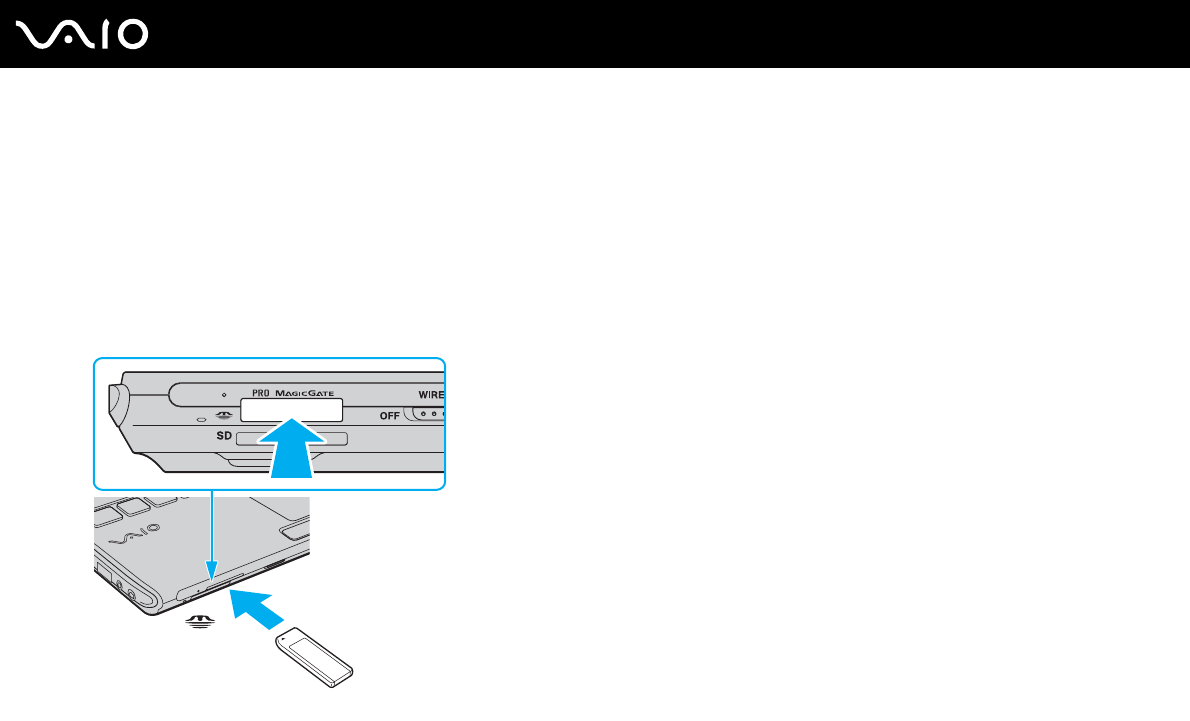
57
nN
Using Your VAIO Computer
Inserting a Memory Stick
To insert a Memory Stick
1Locate the Memory Stick slot.
2Hold the Memory Stick with the arrow facing upward and pointing toward the slot.
3Carefully slide the Memory Stick into the slot until it clicks into place.
The Memory Stick is automatically detected by your system and the contents on the Memory Stick are displayed. If
nothing appears on the desktop, click Start, Computer, and double-click the Memory Stick icon.
!
Be sure to hold the Memory Stick with the arrow pointing in the correct direction as you insert it into the slot. To avoid damaging your computer or the
media, do not force the Memory Stick into the slot if you cannot insert it smoothly.
Do not insert more than one Memory Stick into the slot. Improper insertion of the media may damage both your computer and the media.

58
nN
Using Your VAIO Computer
To view the contents on the Memory Stick
1Click Start and Computer to open the Computer window.
2Double-click the Memory Stick icon to view the list of data files saved in the Memory Stick.
To format a Memory Stick
The Memory Stick has been formatted in the factory default setting and is ready for use.
If you want to reformat the media with your computer, follow these steps.
!
Be sure to use the device that is designed to format the media and supports the Memory Stick when formatting the media.
Formatting the Memory Stick erases the entire data on the media. Before formatting the media, make sure that it does not contain your valuable data.
Do not remove the Memory Stick from the slot while formatting. This could cause a malfunction.
1Carefully slide the Memory Stick into the slot until it clicks into place.
2Click Start and Computer to open the Computer window.
3Right-click the Memory Stick icon and select Format.
4Click Restore device defaults.
!
The size of the allocation unit and file system may change.
Do not select NTFS from the File system drop-down list as it may cause a malfunction.
✍
The formatting process will be completed more quickly if you select Quick Format in Format options.

60
nN
Using Your VAIO Computer
Removing a Memory Stick
!
Do not remove the Memory Stick while the Media Access indicator light is lit. If you do, you may lose data. Large volumes of data may take time to
load, so make sure the indicator is unlit before removing the Memory Stick.
To remove a Memory Stick
1Check that the Media Access indicator light is unlit.
2Push in the Memory Stick toward the computer and release.
The Memory Stick ejects.
3Pull the Memory Stick out of the slot.
!
Always remove the Memory Stick gently, or it may pop out unexpectedly.

61
nN
Using Your VAIO Computer
Using the SD Memory Card
Your computer is equipped with an SD memory card slot. You can use this slot to transfer data among digital cameras,
camcorders, music players, and other audio/video devices.
Before You Use the SD Memory Card
The SD memory card slot on your computer supports the following memory cards:
❑SD memory card
❑SDHC memory card
❑MultiMediaCard (MMC)
For the latest information on compatible memory cards, see Sony Support Information (page 223) to visit the appropriate
support web site.
!
Your computer has been tested and found compatible only with major memory cards available as of September 2008. However, not all memory cards
that meet the same specifications as the compatible media are guaranteed of compatibility.
Always insert the correct memory card into the SD memory card slot.
SD memory cards with capacity of up to 2 GB and SDHC memory cards with capacity of up to 32 GB have been tested and found compatible with your
computer.
The SD memory card slot on your computer does not support the high-speed data transfer feature of the SD memory card and the SDHC memory card.
Do not attempt to insert an SD memory card or SD memory card adaptor of a different type into the SD memory card slot. An incompatible memory
card or memory card adaptor may cause difficulty in removing from the slot and can cause damage to your computer.
Use care when inserting or removing an SD memory card from the SD memory card slot. Do not force the SD memory card in or out of the slot.
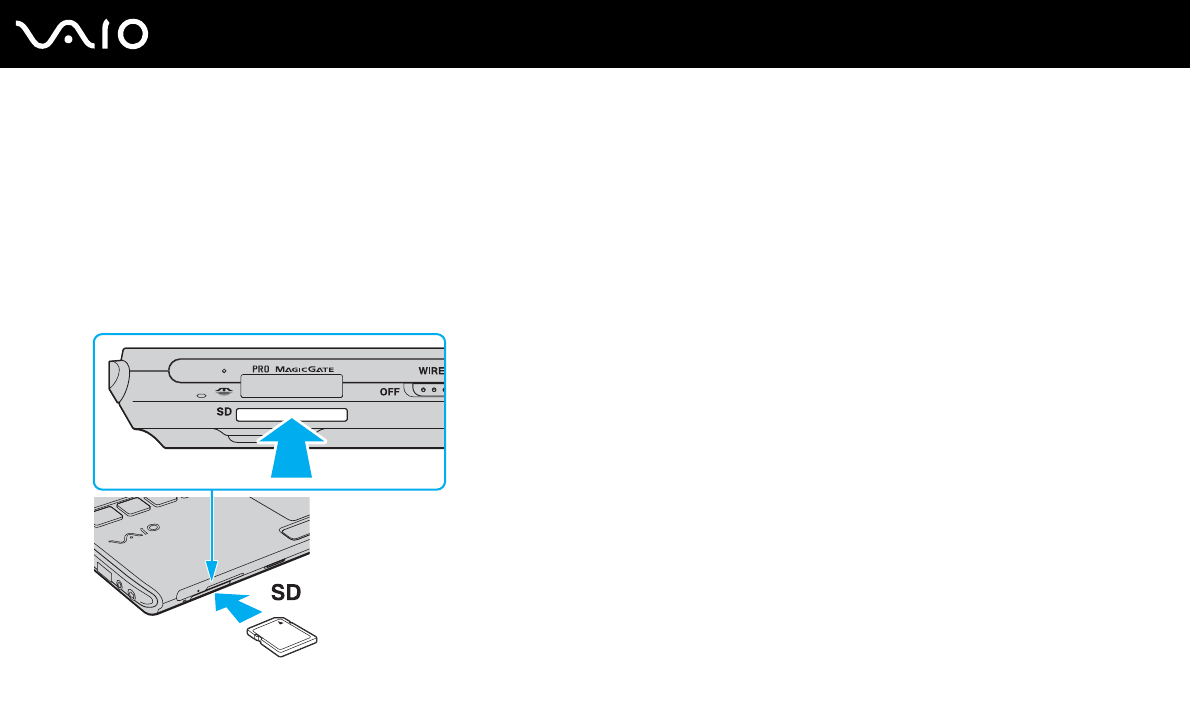
62
nN
Using Your VAIO Computer
Inserting an SD Memory Card
To insert an SD memory card
1Locate the SD memory card slot.
2Hold the SD memory card with the arrow facing upward and pointing toward the slot.
3Carefully slide the SD memory card into the slot until it clicks into place.
Do not force the card into the slot.
✍
If the SD memory card does not go into the slot easily, remove it gently and verify you are inserting it in the proper direction.

63
nN
Using Your VAIO Computer
Removing an SD Memory Card
!
Do not remove an SD memory card while the Media Access indicator light is lit. If you do, the card or its data may become damaged.
To remove an SD memory card
1Check that the Media Access indicator light is unlit.
2Push in the SD memory card toward the computer and release.
The SD memory card ejects.
3Pull the SD memory card out of the slot.

64
nN
Using Your VAIO Computer
Using the Internet
Before using the Internet, you need to sign up with an Internet Service Provider (ISP) and set up devices required for
connecting your computer to the Internet.
The following types of Internet connection services may be available from your ISP:
❑Fiber to the Home (FTTH)
❑Digital Subscriber Line (DSL)
❑Cable modem
❑Satellite
❑Dial-up
For detailed information on devices required for the Internet and how to connect your computer to the Internet, ask your ISP.
✍
To connect your computer to the Internet using the wireless LAN function, you need to set up the wireless LAN network. See Using the Wireless LAN
(WLAN) (page 68) for more information.
!
When you connect your computer to the Internet, be sure to take appropriate security measures to protect the computer against online threats.
If your computer is not equipped with a built-in modem, you may need to connect an external modem device, for example a USB telephone modem, a
DSL modem, or a cable modem, to your computer. For the detailed instructions on connection setups and modem configuration, see the manual that
came with your modem. To find out whether your computer is equipped with a built-in modem, see the online specifications.
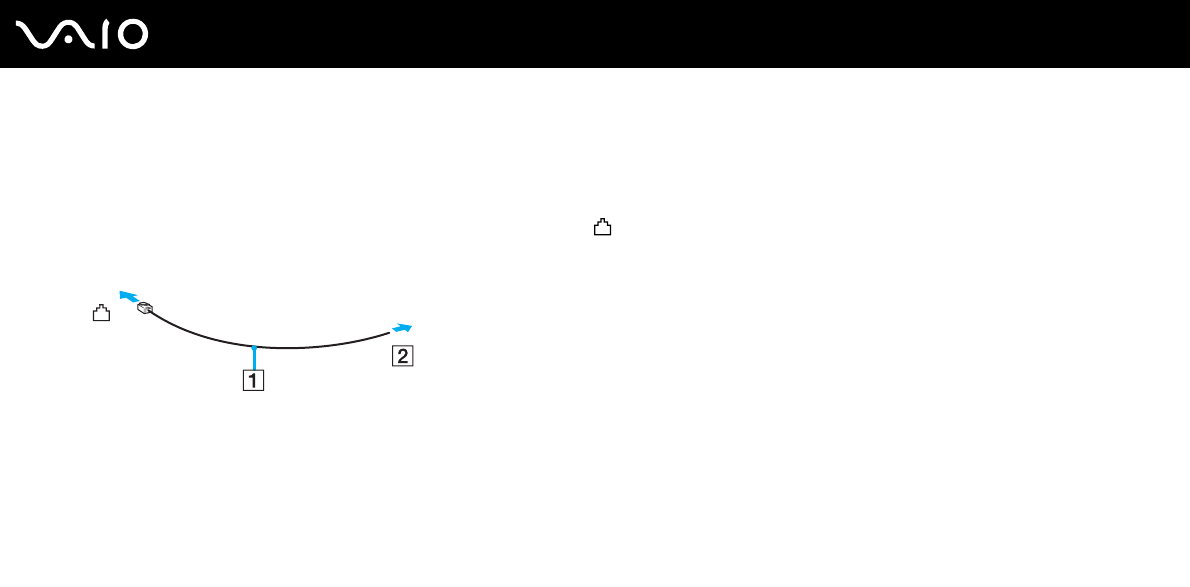
65
nN
Using Your VAIO Computer
To connect a telephone cable
!
The following procedure applies to models with a built-in modem only.
1Plug one end of the phone cable (1) into the modem port on the computer.
2Plug the other end into the wall jack (2).
✍
Your computer does not work with party lines, cannot be connected to a coin-operated telephone, and may not work with multiple telephone lines or a
private branch exchange (PBX). Some of these connections may result in excess electrical current and could cause a malfunction in the built-in modem.
If you connect a telephone cable coming through a splitter, the modem or connected device may not work properly.
To set up a dial-up connection to the Internet
!
The following procedure applies to models with a built-in modem only.
1Click Start and Control Panel.
2Click Connect to the Internet under Network and Internet.
The Connect to the Internet window appears.
3Click Dial-up.
4Follow the on-screen instructions.
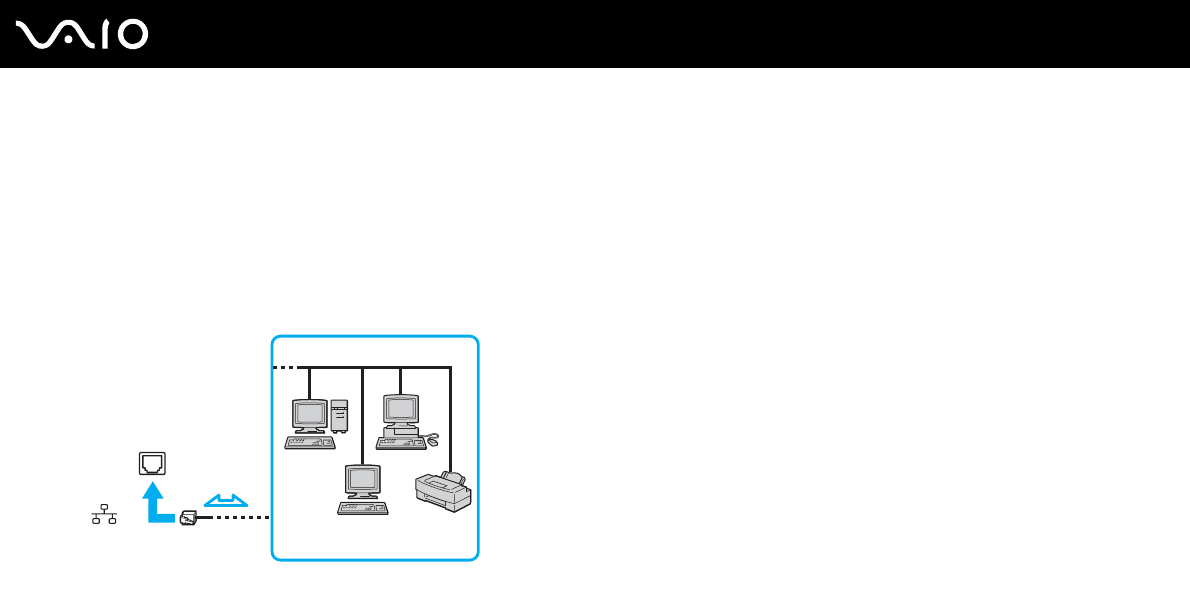
66
nN
Using Your VAIO Computer
Using the Network (LAN)
You can connect your computer to 1000BASE-T/100BASE-TX/10BASE-T type networks with an Ethernet network cable.
Connect one end of a network cable (not supplied) to the network (Ethernet) port on the computer or the optional docking
station and the other end to your network. For detailed settings and devices needed to connect to the network, ask your
network administrator.
!
The network (Ethernet) port on your computer is disabled when the computer is attached to the docking station.
✍
Your computer can be connected to the network with the default settings.

67
nN
Using Your VAIO Computer
!
Do not plug a telephone cable into the network (Ethernet) port on your computer.
If the network (Ethernet) port is connected to one of the telephone lines mentioned below, high electric current to the port may cause damage,
overheating, or fire.
- Home (intercom speakerphone) or business-use telephone lines (multi-line business telephone)
- Public telephone subscriber line
- PBX (private branch exchange)

68
nN
Using Your VAIO Computer
Using the Wireless LAN (WLAN)
Using the Wireless LAN (WLAN), all your digital devices with the built-in WLAN function communicate freely with each other
through a network. A WLAN is a network in which a user can connect to a Local Area Network (LAN) through a wireless (radio)
connection. This eliminates the need to pull cables or wires through walls and ceilings.
The WLAN supports all normal Ethernet connectivity, but with the added benefits of mobility and roaming. You can still access
information, Internet/intranet and network resources, even in the middle of a meeting, or as you move from one place to
another.
You can communicate without an access point, which means that you can communicate with a limited number of computers
(ad-hoc). Or you can communicate through an access point, which allows you to create a full infrastructure network.
To use the wireless LAN function
To use the wireless LAN function, you first need to set up the wireless LAN function.
❑For models with the wireless WAN function
Use the SmartWi Connection Utility to set up the wireless LAN function. See the SmartWi Connection Utility Help for
more information.
To access this on-screen guide:
1Click Start, All Programs, and SmartWi Connection Utility.
2Click SmartWi Connection Utility Help.
!
Be sure to turn on the WIRELESS switch before starting the wireless LAN function.
You cannot select the 5 GHz band, which is used for the IEEE 802.11a standard, on ad-hoc networks.
The IEEE 802.11n draft standard, using the 2.4 GHz or 5 GHz band, is not available on ad-hoc networks.

69
nN
Using Your VAIO Computer
❑For models without the wireless WAN function
Search for wireless LAN information using Windows Help and Support to set up and use the wireless LAN function. To
open Windows Help and Support, click Start and Help and Support.
!
Be sure to turn on the WIRELESS switch before starting the wireless LAN function.
You cannot select the 5 GHz band, which is used for the IEEE 802.11a standard, on ad-hoc networks.
The IEEE 802.11n draft standard, using the 2.4 GHz or 5 GHz band, is not available on ad-hoc networks.
✍
In some countries, using WLAN products may be restricted by the local regulations (e.g. limited number of channels). Therefore, before activating the
WLAN function, read the Safety Information carefully.
WLAN uses the IEEE 802.11a*/b/g standard or the IEEE 802.11n* draft standard, which specifies the used technology. The standard includes the
encryption methods: Wired Equivalent Privacy (WEP), which is a security protocol, Wi-Fi Protected Access 2 (WPA2), and Wi-Fi Protected Access
(WPA). Proposed jointly by the IEEE and Wi-Fi Alliance, both WPA2 and WPA are specifications of standards based on interoperable security
enhancements that increase the level of data protection and access control for existing Wi-Fi networks. WPA has been designed to be forward
compatible with the IEEE 802.11i specification. It utilizes the enhanced data encryption TKIP (Temporal Key Integrity Protocol) in addition to user
authentication using 802.1X and EAP (Extensible Authentication Protocol). Data encryption protects the vulnerable wireless link between clients and
access points. Besides that, there are other typical LAN security mechanisms to ensure privacy, such as: password protection, end-to-end encryption,
virtual private networks, and authentication. WPA2, the second generation of WPA, provides stronger data protection and network access control and
is also designed to secure all versions of 802.11 devices, including 802.11b, 802.11a, 802.11g, and 802.11n draft standard, multi-band and multi-
mode. In addition, based on the ratified IEEE 802.11i standard, WPA2 provides government grade security by implementing the National Institute of
Standards and Technology (NIST) FIPS 140-2 compliant AES encryption algorithm and 802.1X-based authentication. WPA2 is backward compatible
with WPA.
* See the online specifications to find out whether your model supports the IEEE 802.11a standard and/or the IEEE 802.11n draft standard.
The IEEE 802.11b/g standard is a wireless LAN standard, using the 2.4 GHz band. The IEEE 802.11g standard provides high-speed communications,
faster than the IEEE 802.11b standard.

70
nN
Using Your VAIO Computer
The IEEE 802.11a standard is a wireless LAN standard, using the 5 GHz band.
The IEEE 802.11n draft standard is a wireless LAN standard, using the 2.4 GHz or 5 GHz band.
Wireless LAN devices using the 2.4 GHz band cannot communicate with devices using the 5 GHz band because the frequencies are different.
The 2.4 GHz band used by wireless LAN compatible devices is also used by other various devices. Although technologies to minimize interference from
other devices that use the same band are employed on wireless LAN compatible devices, such interference may cause lower communication speed,
narrower communication range, or broken wireless connections.
The communication speed varies depending on the distance between communication devices, existence of obstacles between such devices, the device
configuration, the radio conditions, and the software in use. In addition, communications may be cut off depending on the radio conditions.
The communication range varies depending on the actual distance between communication devices, existence of obstacles between such devices, the
radio conditions, the ambient environment that includes existence of walls and materials of such walls, and the software in use.
Actual communication speed may not be as fast as the one displayed on your computer.
Deploying IEEE 802.11b and IEEE 802.11g products on the same wireless network may reduce the communication speed due to radio interference.
Taking this into consideration, the IEEE 802.11g products are designed to reduce the communication speed to ensure communications with
IEEE 802.11b products. When the communication speed is not as fast as expected, changing the wireless channel on the access point may increase
the communication speed.

71
nN
Using Your VAIO Computer
Using the Bluetooth Function
You can establish wireless communications between your computer and other Bluetooth devices such as another computer
or a mobile phone. You can transfer data between these devices without cables at a range of up to 33 feet (10 meters) in an
open area.
To use the Bluetooth function
To use the Bluetooth function, you first need to set up the Bluetooth function.
❑For models with the wireless WAN function
Use the SmartWi Connection Utility to set up the Bluetooth function. See the SmartWi Connection Utility Help for
more information.
To access this on-screen guide:
1Click Start, All Programs, and SmartWi Connection Utility.
2Click SmartWi Connection Utility Help.
!
Be sure to turn on the WIRELESS switch before starting the Bluetooth function.
❑For models without the wireless WAN function
Search for Bluetooth information using Windows Help and Support to set up and use the Bluetooth function. To open
Windows Help and Support, click Start and Help and Support.
!
Be sure to turn on the WIRELESS switch before starting the Bluetooth function.

72
nN
Using Your VAIO Computer
Notes on using the Bluetooth function
❑The data transfer rate varies, depending on the following conditions:
❑Obstacles, such as walls, located between devices
❑Distance between devices
❑Material used in walls
❑Proximity to microwaves and cordless telephones
❑Radio frequency interference and other environmental conditions
❑Device configuration
❑Type of software application
❑Type of operating system
❑Use of both wireless LAN and Bluetooth functions at the same time on your computer
❑Size of file being exchanged
❑Large files may occasionally be corrupted during continuous transfer due to limitations of the Bluetooth standard and
electromagnetic interference in the environment.
❑All Bluetooth devices must be certified to make sure that the applicable standard requirements are maintained. Even if
standards are met, individual device performance, specifications, and operation procedures can vary. Data exchange may
not be possible in all situations.
❑Video and audio may not be synchronized if you play videos on your computer with audio output from a connected
Bluetooth device. This is a frequent occurrence with Bluetooth technology and is not a malfunction.

73
nN
Using Your VAIO Computer
❑The 2.4 GHz band, with which Bluetooth devices or wireless LAN devices work, is used by various devices. Bluetooth
devices use the technology to minimize the interference from other devices that use the same wave length. Simultaneous
use of the Bluetooth function and wireless communication devices, however, may cause radio interference and result in
reduced communication speeds and distances than the standard values.
❑The Bluetooth function may not work with other devices, depending on the manufacturer or the software version employed
by the manufacturer.
❑Connecting multiple Bluetooth devices to your computer may cause channel congestion, resulting in poor performance
of the devices. This is normal with Bluetooth technology and is not a malfunction.

74
nN
Using Your VAIO Computer
Bluetooth Security
The Bluetooth wireless technology has an authentication function, which allows you to determine with whom you choose to
communicate. With the authentication function, you can prevent any anonymous Bluetooth devices from accessing your
computer.
The first time two Bluetooth devices communicate, a common passkey (a password required for authentication) should be
determined for both devices to be registered. Once a device is registered, there is no need to re-enter the passkey.
✍
The passkey can be different each time, but must be the same at both ends.
For certain devices, such as a mouse, no passkey can be entered.
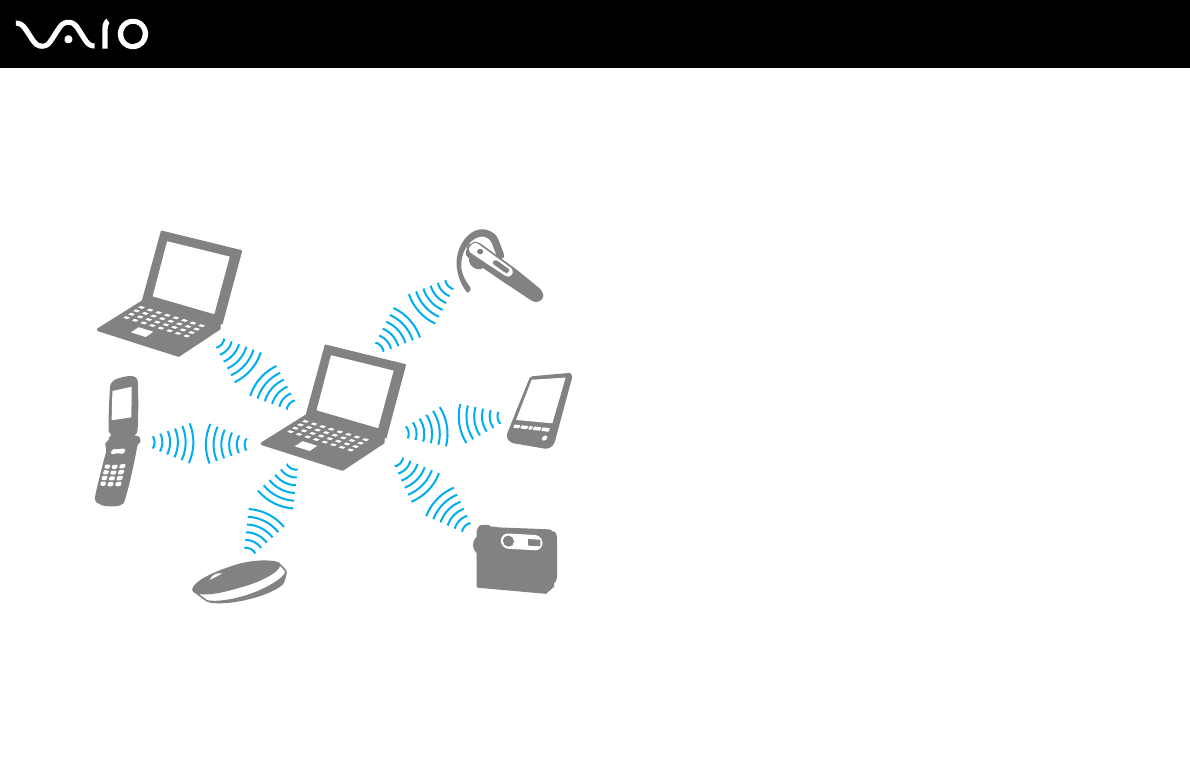
75
nN
Using Your VAIO Computer
Communicating with Another Bluetooth Device
You can connect your computer to a Bluetooth device such as another computer, a mobile phone, a PDA, a headset, a
mouse, or a digital camera without the use of any cables.
To communicate with another Bluetooth device
To communicate with another Bluetooth device, you first need to set up the Bluetooth function. For setting up and using the
Bluetooth function, search for Bluetooth information using Windows Help and Support. To open Windows Help and
Support, click Start and Help and Support.
!
Be sure to turn on the WIRELESS switch before starting the Bluetooth function.

76
nN
Using Peripheral Devices
Using Peripheral Devices
You can add functionality to your VAIO computer by using the various ports on the computer.
❑Using the Noise Canceling Headphones (page 77)
❑Connecting a Docking Station (page 83)
❑Connecting an Optical Disc Drive (page 91)
❑Connecting External Speakers (page 93)
❑Connecting an External Display (page 94)
❑Selecting Display Modes (page 102)
❑Using the Multiple Monitors Function (page 103)
❑Connecting an External Microphone (page 105)
❑Connecting a Universal Serial Bus (USB) Device (page 106)
❑Connecting a Printer (page 109)
❑Connecting an i.LINK Device (page 110)

77
nN
Using Peripheral Devices
Using the Noise Canceling Headphones
A pair of noise canceling headphones may be supplied with your computer depending on the model you purchased.
The noise canceling headphones are equipped with a built-in microphone that catches ambient noise and outputs an
antiphase sound to reduce the noise.
See the online specifications to find out whether the noise canceling headphones are supplied with your computer.
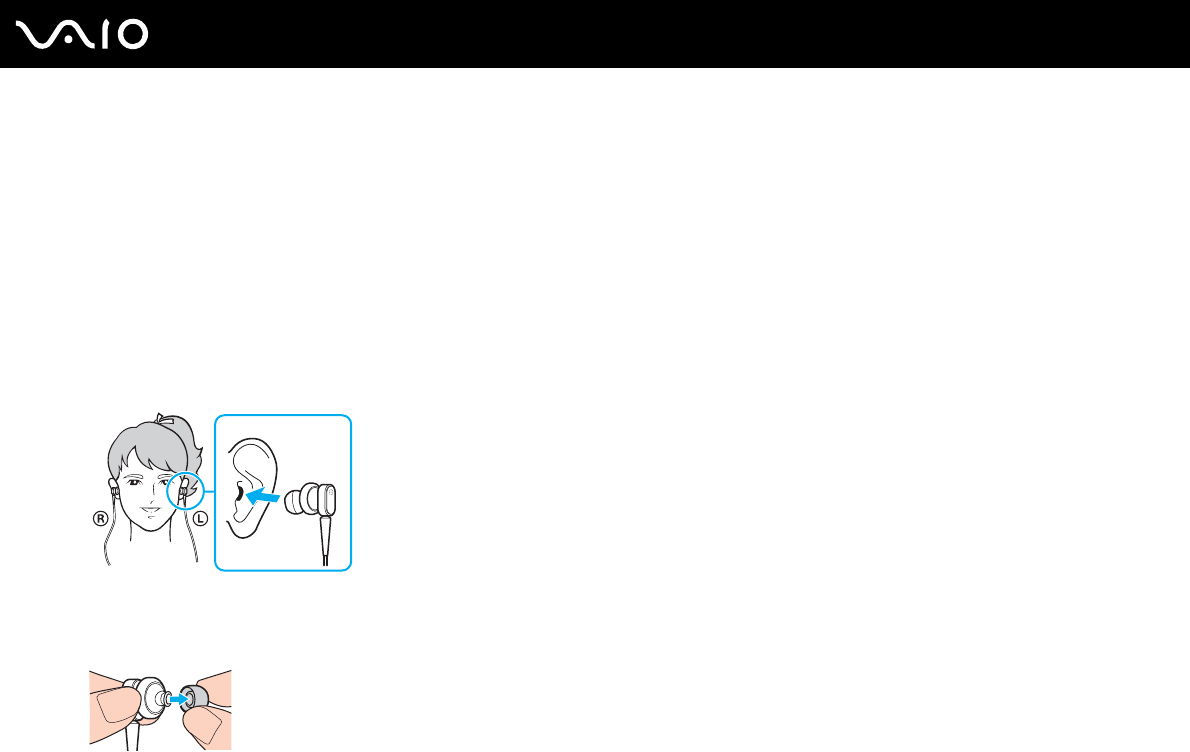
78
nN
Using Peripheral Devices
Before You Use the Noise Canceling Headphones
❑You can enable the noise canceling function only when the supplied noise canceling headphones are connected to the
headphones jack that supports this function.
❑The noise canceling function does not work on sound output with the following devices:
❑External speakers
❑Headphones without the noise canceling function
❑Sound output devices connected to your computer via a Bluetooth connection
❑The noise canceling function cannot be fully in effect unless you properly wear the headphones. Be sure to fit earpieces
of the headphones tightly into your ears.
If you feel that the noise canceling function has little effect, adjust the earbud position in the earpieces of the noise
canceling headphones or replace the earbuds with a pair in another size. A pair of medium-size earbuds is attached to
the earpieces by default and there should be an extra pair in each small and large sizes supplied with the headphones.

79
nN
Using Peripheral Devices
❑The noise canceling function is to reduce low-frequency noise in the ambient environment but not high-frequency noise.
Nor is it to implement a 100% noise-free audio environment.
❑When the noise canceling function does not seem to be working, unplug the supplied noise canceling headphones
completely and then plug them back again.
❑Keep the built-in microphone (1) of the noise canceling headphones unblocked to ensure that the noise canceling function
can be fully in effect.
❑You may hear a soft hissing noise while the noise canceling function is enabled. This is just operational noise that the
function generates and does not indicate a malfunction.
❑You may feel that the noise canceling function has little effect or ambient noise seems even louder, depending on the type
of noise or the degree of quietness in your environment. In such a case, disable the noise canceling function.
❑Use of a mobile phone may cause radio interference with the noise canceling headphones. When using the headphones,
keep mobile phones away from the headphones.
❑Plugging or unplugging the noise canceling headphones generates noise. This is normal and does not indicate a
malfunction. Be sure to take off the headphones from your ears before plugging or unplugging the headphones.
❑Enabling/disabling the noise canceling function or enabling/disabling sound with the Windows volume controls generates
noise. This is caused by switching the noise canceling circuit and does not indicate a malfunction.
❑Be sure to use the supplied noise canceling headphones. You can plug the headphones supplied with a Walkman® to
your computer but the noise canceling function of the computer will not work well with such headphones.
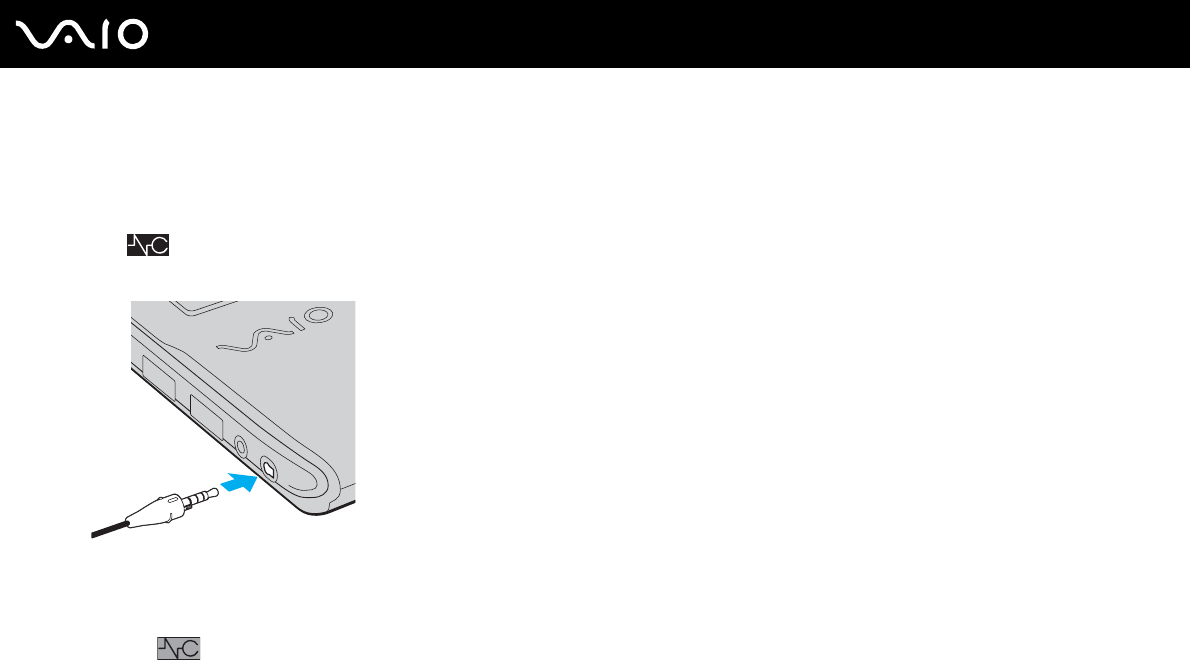
80
nN
Using Peripheral Devices
Connecting the Noise Canceling Headphones
To connect the noise canceling headphones
1Plug the headphones cable into the headphones jack i.
The icon appears on the taskbar to indicate that the noise canceling function is enabled and a balloon message
pops up from the icon.
!
Before plugging the headphones cable to the headphones jack, make sure that the embossed marking on the plug faces upward.
✍
When the icon is on the taskbar, the noise canceling function is disabled. Right-click the icon and select Enable Noise Canceling Function from
the menu.
If no icon is on the taskbar, see What to do if the icon and the balloon do not appear (page 82) to change the settings.

81
nN
Using Peripheral Devices
Adjusting the Effect of the Noise Canceling Function
The noise canceling headphones supplied with your computer is configured to yield the optimum effect by default.
If you feel that the noise canceling function is not fully in effect, you may be able to adjust the effect with the Noise Canceling
Control slider on the Noise Canceling Headphones window.
To adjust the effect of the noise canceling function
1Right-click the icon on the taskbar and select Settings.
The Noise Canceling Headphones window appears.
✍
If no icon is on the taskbar, see What to do if the icon and the balloon do not appear (page 82) to change the settings.
2Drag the Noise Canceling Control slider toward Mic+ or Mic- to select your desired noise canceling level.
✍
The slider should be at the center of the range to yield the optimum level. Dragging the slider all the way to Mic+ does not bring the noise canceling
function fully into effect.
3Click Apply.
4Confirm that the noise canceling effect is satisfactory and then click OK.

82
nN
Using Peripheral Devices
What to do if the icon and the balloon do not appear
When the noise canceling function icon ( / ) is not on the taskbar and the balloon message does not pop up from
the icon, change the noise canceling function settings.
To display the balloon message and the icon
1Click Start and Control Panel.
2Click Hardware and Sound.
3Click Manage audio devices under Sound.
4On the Playback tab, double-click the speakers or headphones icon.
5Click the Enhancements tab.
6Click to select the Noise Canceling Function check box and click Modify Settings.
✍
If the Disable all enhancements check box is selected, click to cancel the check box.
7Click to select the Display an icon for the noise canceling headphones in the task tray or Display a message when
noise canceling headphones are connected check box.
8Click OK.
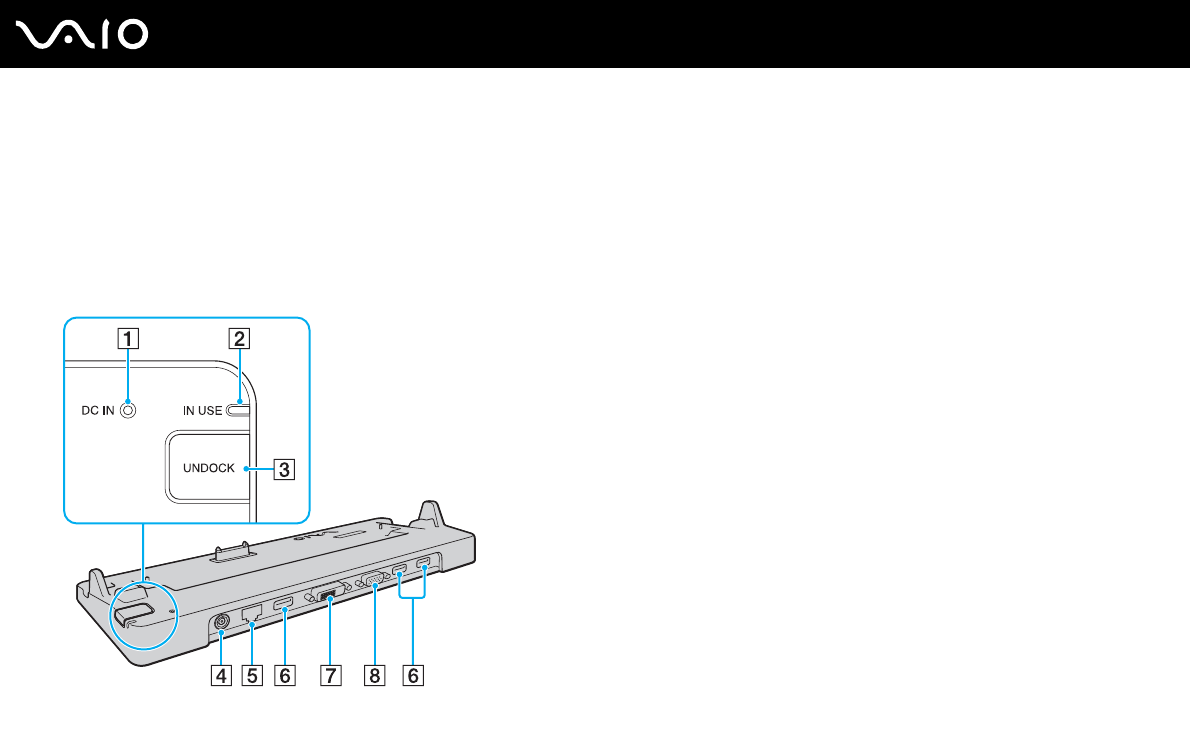
83
nN
Using Peripheral Devices
Connecting a Docking Station
Attaching a docking station enables you to connect additional peripherals to your computer, such as a printer and an external
display.
A docking station is not supplied with your computer and is available as an optional accessory.
Locating Ports on the Docking Station
!
The docking station can be powered only through the AC adapter supplied with your computer. Do not unplug the AC adapter from the docking station
and the AC outlet while using the docking station. This may cause data damage or hardware malfunctions.
ADC IN indicator
Illuminates when the docking station is powered.
BIN USE indicator (page 87)
CUNDOCK button (page 87)
DDC IN port (page 84)
ENetwork (Ethernet) port (1000BASE-T / 100BASE-TX /
10BASE-T) (page 66)
FHi-Speed USB (USB 2.0) ports* (page 106)
GDVI-D port (page 95)
HMONITOR port (page 95)
* Support high-/full-/low- speeds.
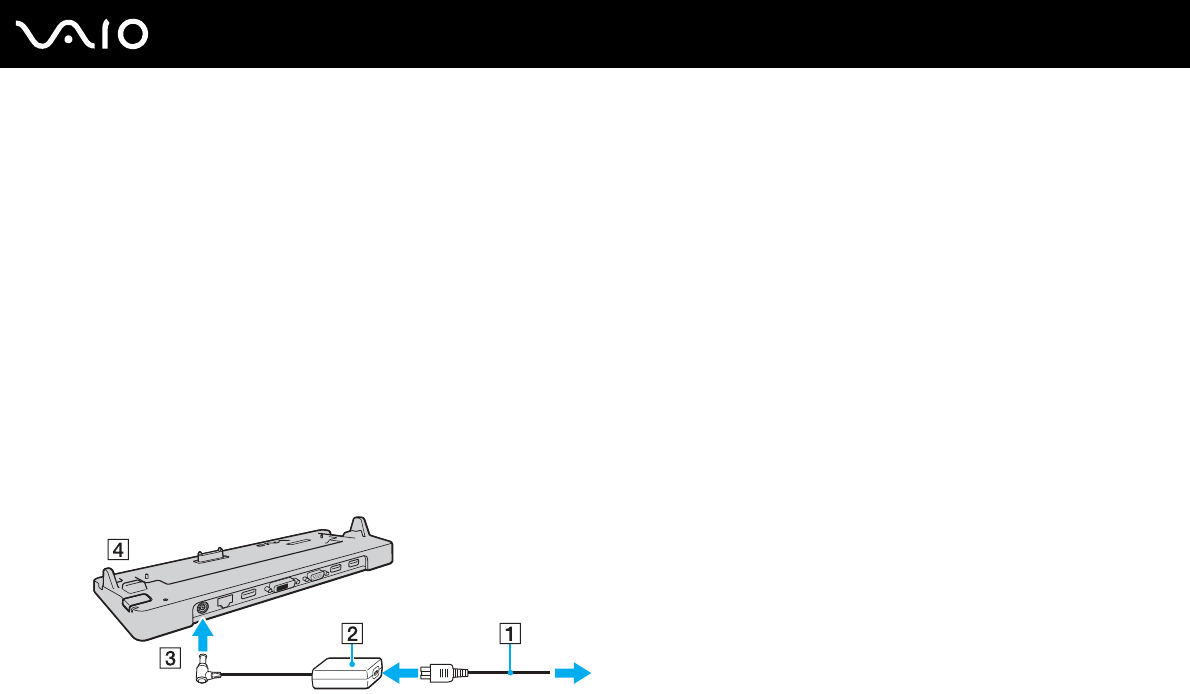
84
nN
Using Peripheral Devices
Attaching Your Computer to the Docking Station
!
Be sure to install the battery pack before attaching your computer to the docking station.
To attach your computer to the docking station
!
Use the AC adapter supplied with your computer.
Do not move your computer while it is attached to the docking station. This may detach the docking station and cause damage to both units.
The monitor port on your computer is not accessible when the computer is attached to the docking station. Use the DVI-D or MONITOR port on the
docking station for connecting an external display.
1Disconnect all peripherals from the computer.
2Plug one end of the power cord (1) into the AC adapter (2) and the other end into an AC outlet.
3Plug the cable connected to the AC adapter (2) into the DC IN port (3) on the docking station (4).
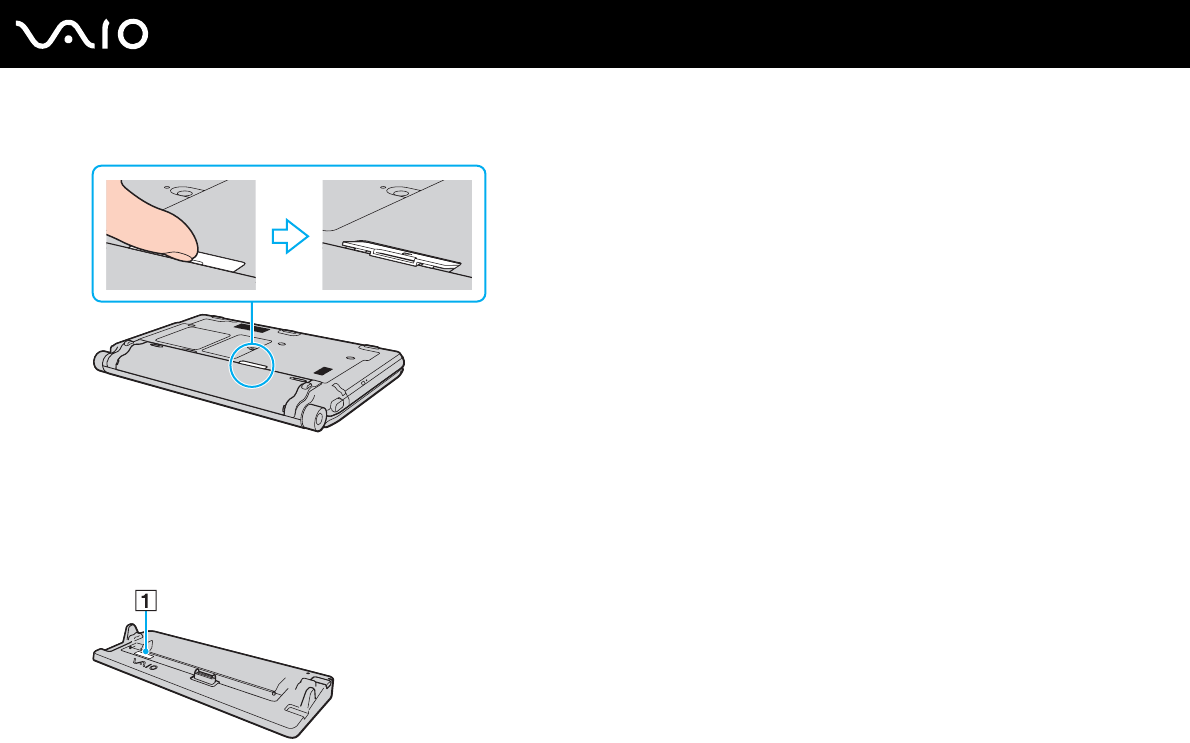
85
nN
Using Peripheral Devices
4Remove the docking station connector cover from the bottom of the computer.
!
You may find it difficult to remove the docking station connector cover, as it is tight in place on your computer. Do not exert extra pressure when
removing the cover so as not to damage the computer or the docking station connector cover.
✍
Once you have removed the docking station connector cover, keep it in the designated space (1) on the docking station.

87
nN
Using Peripheral Devices
Disconnecting Your Computer from the Docking Station
!
Make sure that no devices connected to the docking station are in use before disconnecting your computer.
Do not disconnect your computer from the docking station while the IN USE indicator light is lit. Disconnecting the computer while the IN USE indicator
is lit may result in loss of unsaved data or a failure of the computer.
When the battery pack is running out of power, disconnecting your computer from the docking station may result in loss of unsaved data.
Do not disconnect your computer from the docking station during video playback. Be sure to close video playback software before disconnection.
Once you have completed the steps in To disconnect your computer from the docking station (page 88), be sure to take your computer off the docking
station. Use of the computer while on the docking station may cause unstable operations.
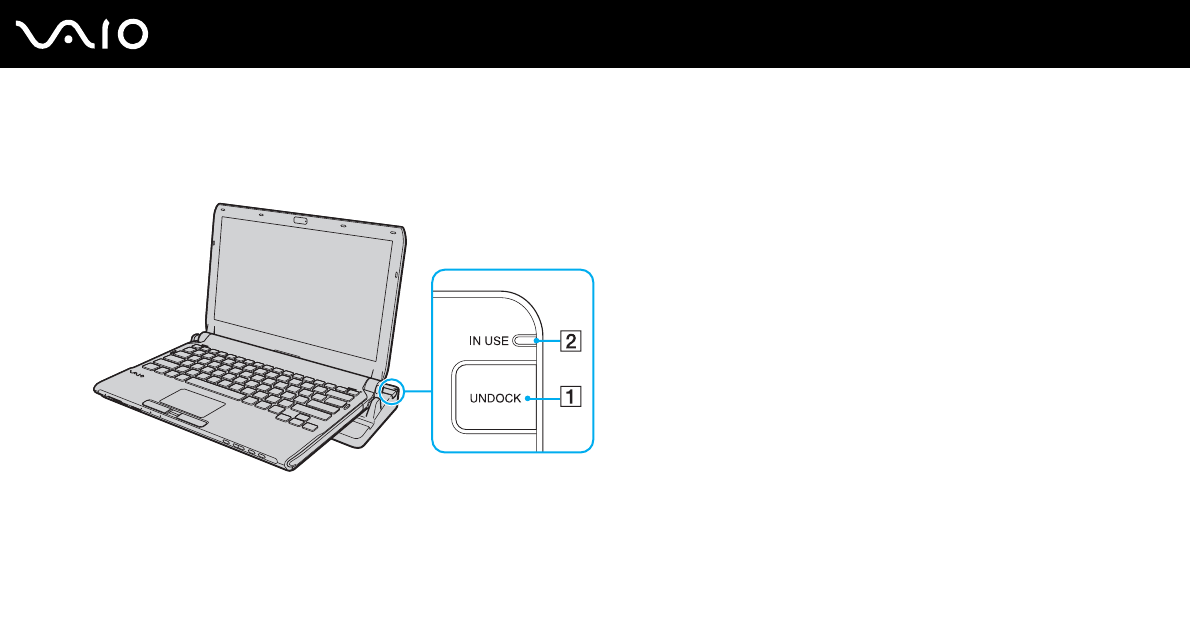
88
nN
Using Peripheral Devices
To disconnect your computer from the docking station
1Press the UNDOCK button (1) and wait until the IN USE indicator light (2) turns off.
✍
If the IN USE indicator is unlit, you do not have to press the UNDOCK button.
Pressing the UNDOCK button while your computer is in a power saving mode brings the computer to Normal mode first, and then initiates the
disconnection process.
!
Once you have placed your computer back in Normal mode, be sure to take your computer off the docking station. Use of the computer while on the
docking station may cause unstable operations.

90
nN
Using Peripheral Devices
Alternatively, you can disconnect the computer from the docking station as follows:
1Click Start, the arrow next to the Lock button, and Undock.
2Make sure that a message balloon appears and the IN USE indicator light turns off. Then lift the computer off the docking
station.
3Replace the docking station connector cover to the bottom of the computer.
!
It is extremely important that you replace the docking station connector cover after disconnecting your computer from the docking station. If the cover
is left unattached, dust may get inside and damage the computer.
✍
To disconnect the docking station completely from AC power, unplug the AC adapter.
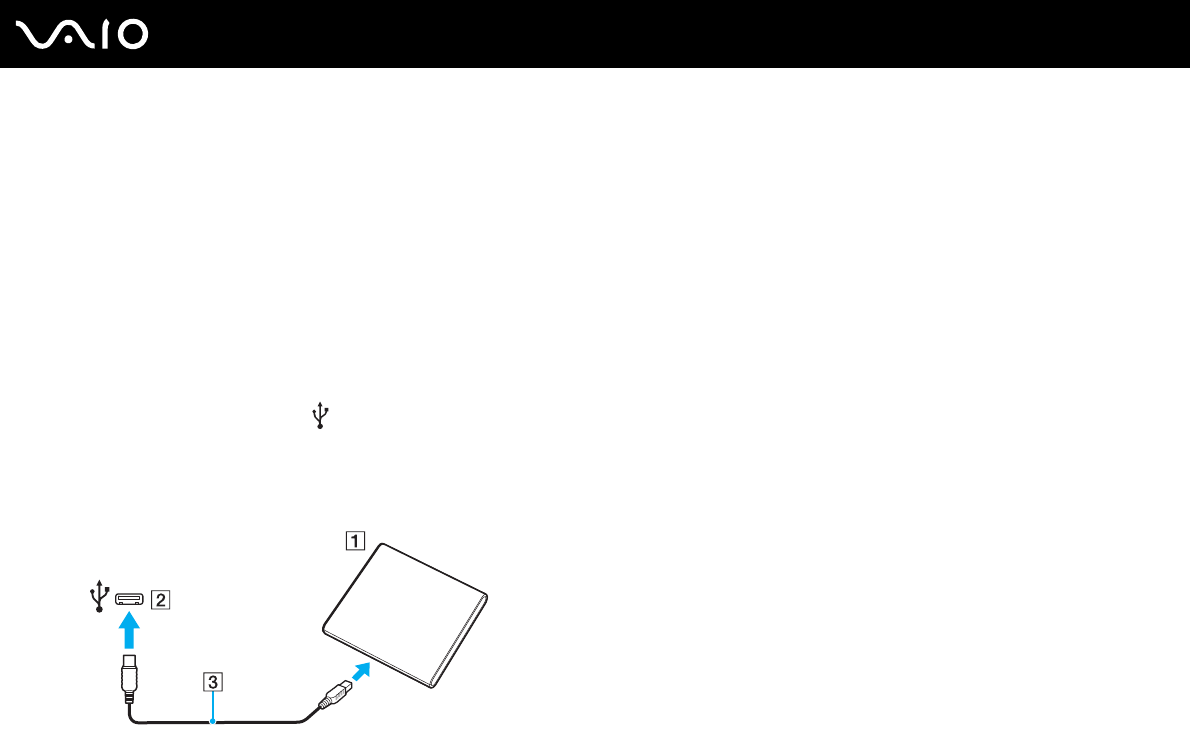
91
nN
Using Peripheral Devices
Connecting an Optical Disc Drive
If your computer is not equipped with a built-in optical disc drive, you need to connect an external optical disc drive (not
supplied) for disc operations.
Connecting an Optical Disc Drive
!
Be sure to connect an external optical disc drive before you launch any preinstalled disc operation program.
To connect an optical disc drive
1Plug the power cord (if any) of your external optical disc drive (not supplied) (1) into an AC outlet.
2Choose the USB port (2) you prefer to use.
3Plug one end of a USB cable (not supplied) (3) into the USB port, and the other end to the optical disc drive.
See the manual that came with your external optical disc drive for the detailed instructions on connecting the USB cable
to the drive.

92
nN
Using Peripheral Devices
Disconnecting an Optical Disc Drive
You can disconnect an optical disc drive when your computer is on or off. Disconnecting the drive when the computer is in a
power saving mode (Sleep or Hibernate) may cause the computer to malfunction.
To disconnect an optical disc drive
✍
To disconnect an optical disc drive when your computer is off, skip steps 1 to 5.
1Close all software applications accessing the optical disc drive.
2Double-click the Safely Remove Hardware icon on the taskbar.
3Select the optical disc drive you want to disconnect.
4Click Stop.
5Follow the on-screen instructions to disconnect the optical disc drive.
6Disconnect the optical disc drive from the computer.
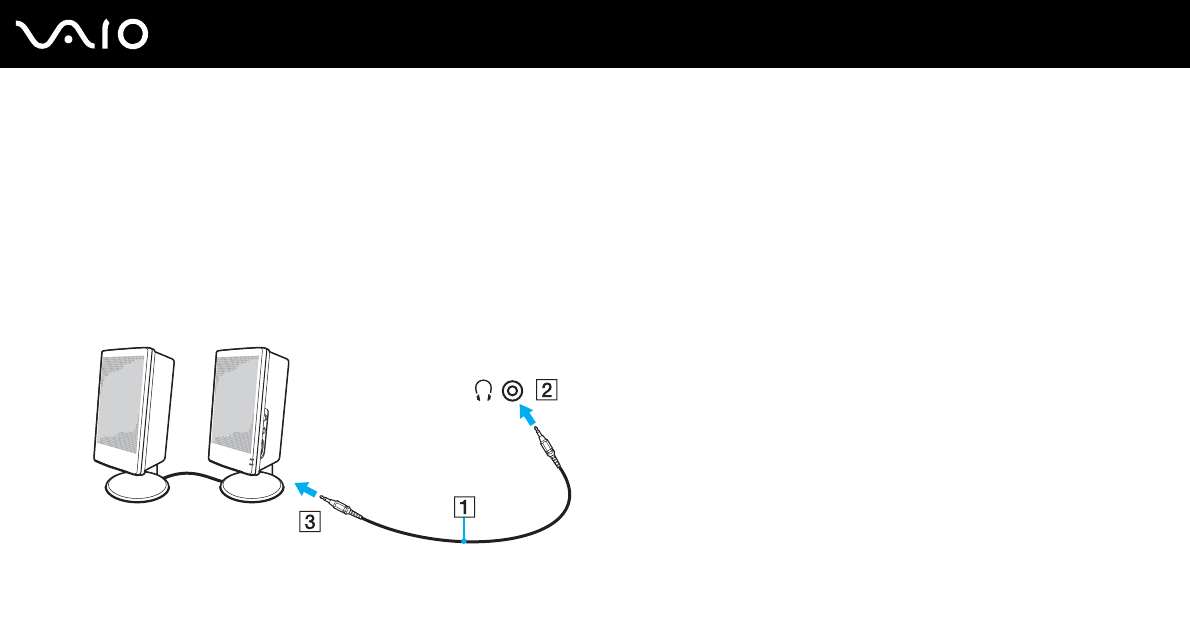
93
nN
Using Peripheral Devices
Connecting External Speakers
You can connect external sound output devices (not supplied), such as speakers or headphones, to your computer.
To connect external speakers
1Plug the speaker cable (1) (not supplied) into the headphones jack (2) i.
2Plug the other end of the speaker cable to the external speaker (3).
3Turn down the volume of the speakers before you turn them on.
✍
Make sure your speakers are designed for computer use.
!
Do not place floppy disks on the speakers. Their magnetic field may damage the data on the disks.
The noise canceling function does not work on sound output through external speakers.

94
nN
Using Peripheral Devices
Connecting an External Display
You can connect an external display (not supplied) to your computer. For example, you can use the computer with a computer
display or a projector.
!
Blu-ray Disc playback on a connected external display may be interrupted, depending on the type or bit rate of the video. You may be able to solve this
problem by lowering the screen resolution of the display. Follow the steps in Why doesn't my screen display a video? (page 205) to change the screen
resolution.
✍
If disconnecting the external display from the optional docking station does not automatically change the LCD resolution of your computer, change the
current display settings. To change the settings, see Selecting Display Modes (page 102).
Connect the power cord of your external display after connecting all other cables.
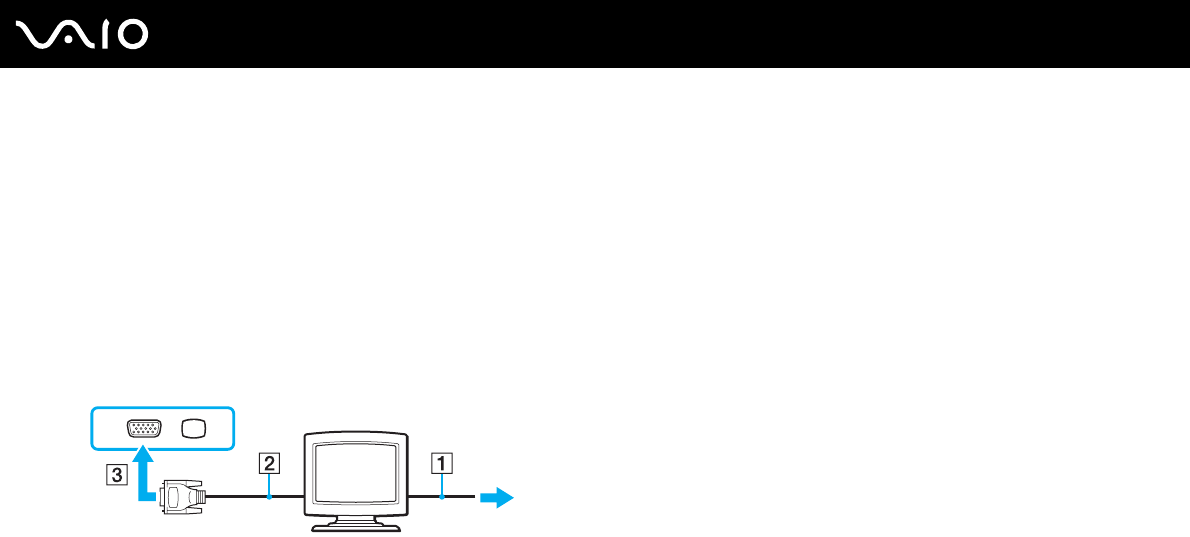
95
nN
Using Peripheral Devices
Connecting a Computer Display
You can connect a computer display (monitor) either directly to your computer or via the optional docking station.
To connect a computer display
!
The monitor port on your computer is not accessible when the computer is attached to the docking station. Use the MONITOR port on the docking
station for connecting a computer display.
1If necessary, plug one end of the display's power cord (1) into your display, and the other end into an AC outlet.
2If you want to connect an analog monitor, plug the display cable (2) (not supplied) into the monitor port (3) a on the
computer or on the docking station.
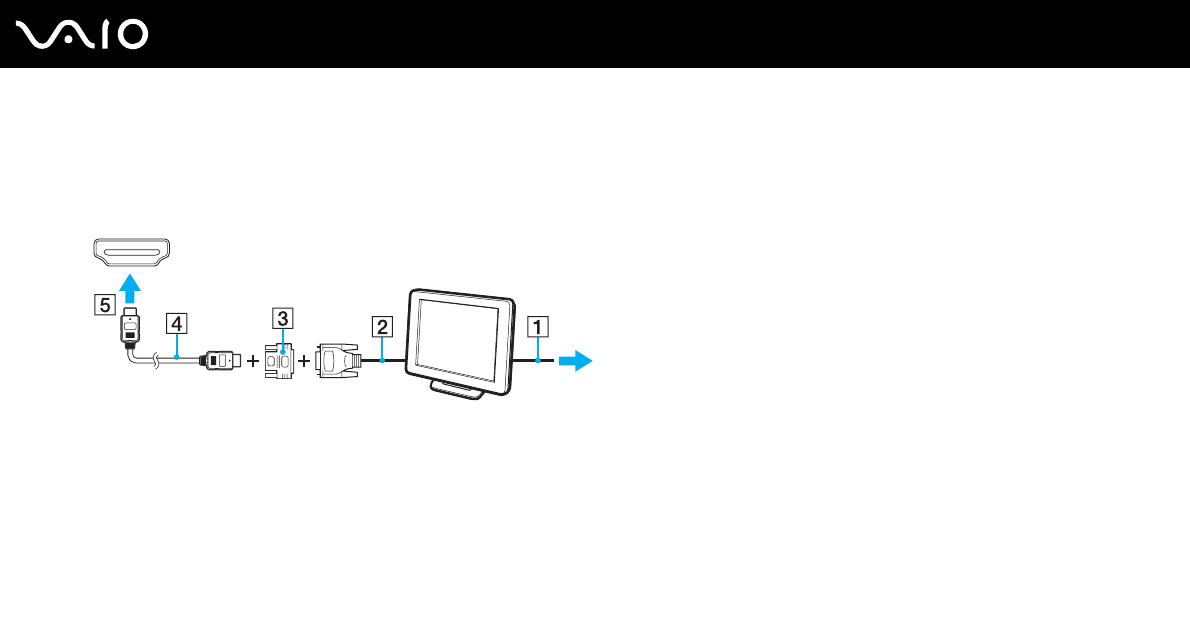
96
nN
Using Peripheral Devices
3If you want to connect a TFT/DVI monitor, plug the display cable (2) (not supplied) to an HDMI to DVI-D adapter (3) (not
supplied) and plug one end of the HDMI cable (4) (not supplied) to the HDMI to DVI-D adapter (3) and the other end to
the HDMI output port (5) on the computer, if equipped, or plug the display cable(2) (not supplied) into the DVI-D port on
the docking station.
4If the external computer display is equipped with an HDMI input port, connect one end of an HDMI cable (not supplied)
to the HDMI output port on the computer and the other to the HDMI input port on the computer display.
!
Your computer is compliant with the HDCP standard and capable of encrypting the transmission channel of digital video signals for the purpose of
copyright protection, which enables you to play and view a wide variety of copyright protected, high-quality contents. To view the copyright protected
contents, connect an HDCP-compliant monitor to the HDMI output port on your computer, if equipped, or the DVI-D port on the docking station. If your
computer has a non-compliant monitor connected, you will not be able to play or view any copyright protected contents.
✍
DVI-D stands for Digital Visual Interface - Digital. It is a type of DVI port that supports only digital video signals (no analog video signals). It has 24 pins.
A DVI-I (Digital Visual Interface - Integrated) port supports digital video and analog video signals. It has 29 pins.

97
nN
Using Peripheral Devices
Connecting a Multimedia Computer Display
You can connect a multimedia computer display that includes built-in speakers and a microphone either directly to your
computer or via the optional docking station.
To connect a multimedia computer display
!
The monitor port on your computer is not accessible when the computer is attached to the docking station. Use the MONITOR port on the docking
station for connecting a multimedia computer display.
1Plug the power cord of your multimedia computer display (1) into an AC outlet.
2Plug the display cable (2) (not supplied) into the monitor port (3) a on the computer or on the docking station.
3Plug the speaker cable (4) (not supplied) into the headphones jack (5) i on the computer.
4Plug the microphone cable (6) (not supplied) into the microphone jack (7) m on the computer.
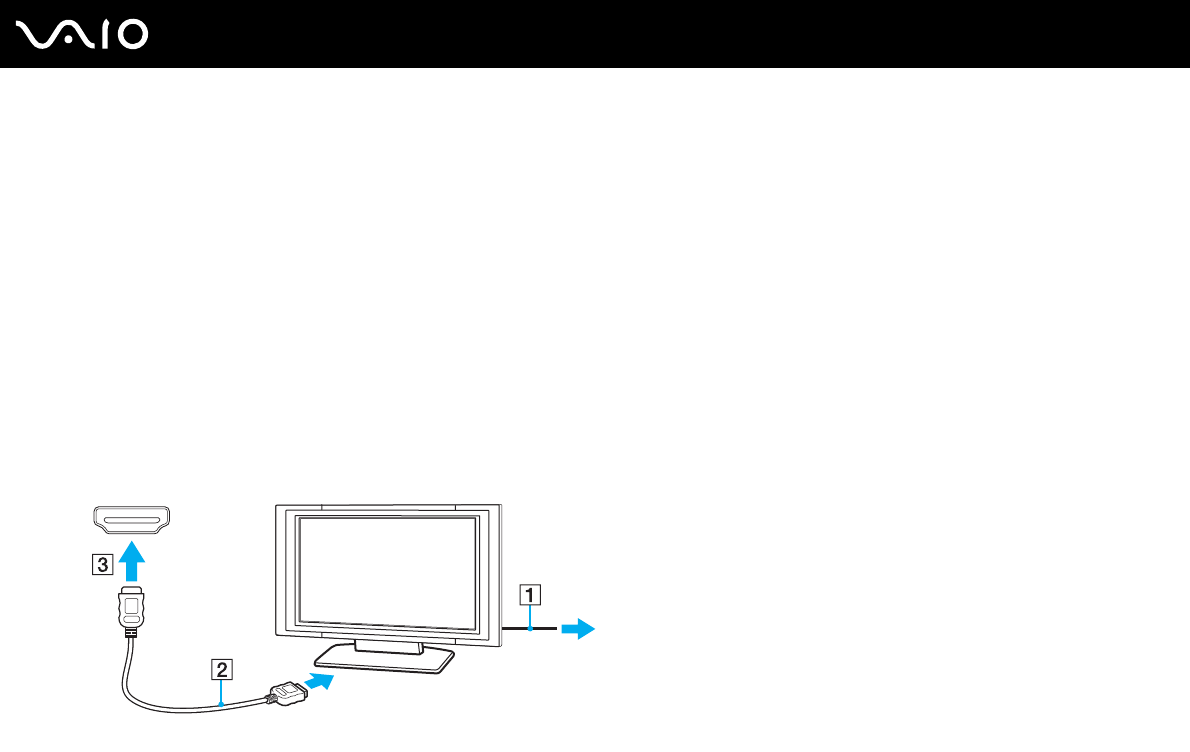
99
nN
Using Peripheral Devices
Connecting a TV
If your computer is equipped with an HDMI output port, you can connect a TV with an HDMI input port to your computer.
The HDMI output port is equipped on selected models only. See the online specifications to find out whether your computer
is equipped with the HDMI output port.
To connect a TV to your computer
!
To hear sound from the device connected to the HDMI output port, you need to change the device for sound output. For the detailed instructions, see
How do I change the sound output device? (page 217).
1Plug the power cord of your TV (1) into an AC outlet.
2Plug one end of an HDMI cable (2) (not supplied) to the HDMI output port (3) on the computer and the other end to the TV.
3Switch the input channel of the TV to external input.
4Set up the TV configuration system.
!
If a device driver other than the one provided by Sony is used, the image will not be displayed and the audio will not be heard. Always use the device
driver provided by Sony for updates.

100
nN
Using Peripheral Devices
✍
See the manual that came with your TV for more information on installation and use.
The HDMI cable carries both video and audio signals.
Additionally, you can connect a high-quality home theater receiver or other surround sound decoder devices between your
computer and TV using an HDMI connection.
To connect a high-quality digital sound output device between your computer and a TV
!
Before connecting the device to the computer, make sure the HDMI connection has been set up between the TV and the home theater receiver or
surround sound decoder device first.
To hear sound from the device connected to the HDMI output port, you need to change the device for sound output. For the detailed instructions, see
How do I change the sound output device? (page 217).
1Turn on the TV and set its input to the HDMI input.
2Turn on the home theater receiver or surround sound decoder device and set its input to the HDMI input.
3Plug one end of an HDMI cable (not supplied) to the HDMI input port on the home theater receiver or surround sound
decoder device and the other end to the HDMI output port on the computer.
4Press the Fn+F7 keys to change the display output to the connected TV.
✍
You can adjust the screen resolution of the connected TV with your computer. See Why doesn't my screen display a video? (page 205) for the detailed
procedure.
With the HDMI connection, the volume can be adjusted by the connected audio device only. Your computer has no control over the output volume of
any connected devices.
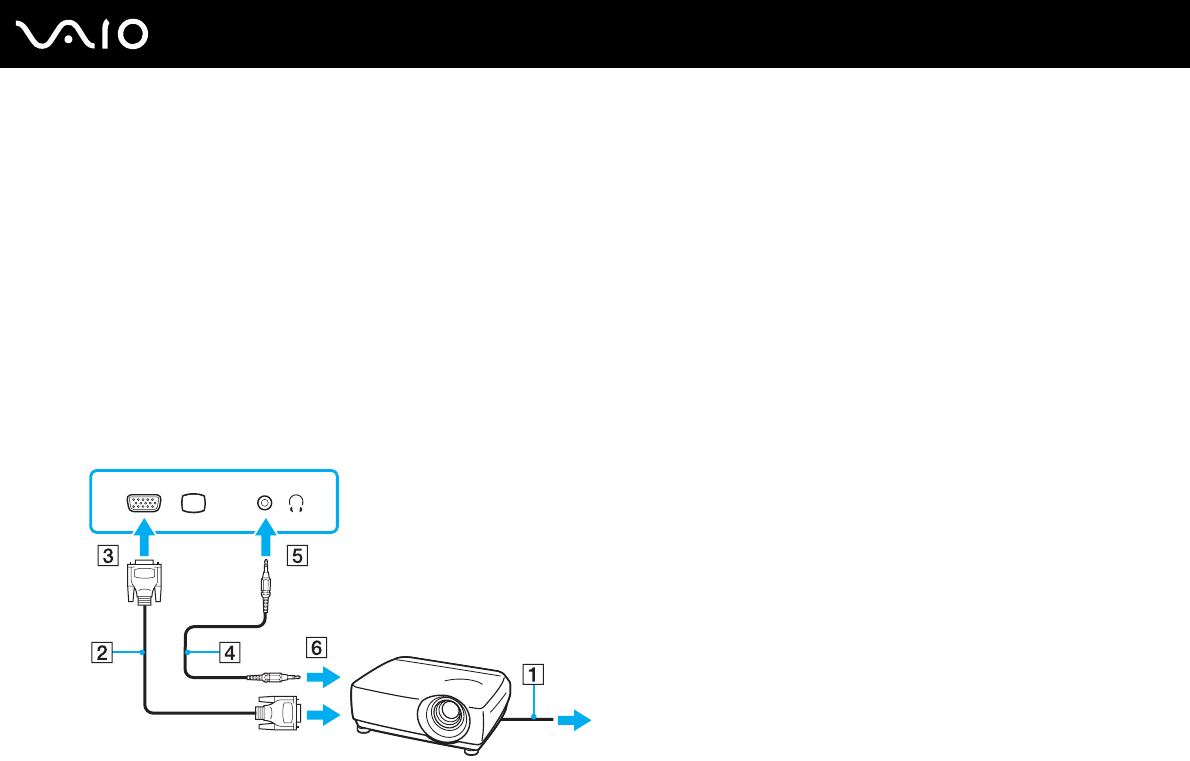
101
nN
Using Peripheral Devices
Connecting a Projector
You can connect a projector (for example, the Sony LCD projector) either directly to your computer or via the optional docking
station.
To connect a projector
!
The monitor port on your computer is not accessible when the computer is attached to the docking station. Use the MONITOR port on the docking
station for connecting a projector.
1Connect the power cord (1) of your projector into an AC outlet.
2Plug a display cable (2) (not supplied) into the monitor port (3) a on the computer or on the docking station.
3Plug an audio cable (4) (not supplied) into the headphones jack (5) i on the computer.
4Plug the display cable and the audio cable into the port and jack on the projector (6).

102
nN
Using Peripheral Devices
Selecting Display Modes
You can select which display to use as the primary monitor when an external display (desktop monitor, etc.) is connected to
your computer.
If you want to work on your computer screen and the external display at the same time, see Using the Multiple Monitors
Function (page 103) for more information.
To select a display
1Right-click on the desktop and select Personalize.
2Click Display Settings.
3Follow the on-screen instructions to change the settings.
✍
You may not be able to display the same contents on your computer screen and the external display or projector at the same time, depending on the
type of your external display or projector.
Before turning on your computer, turn on the external display.

103
nN
Using Peripheral Devices
Using the Multiple Monitors Function
The Multiple Monitors function allows you to distribute portions of your desktop across separate displays. For example, if you
have an external display connected to the monitor port, your computer screen and the external display can function as a
single desktop.
You can move the cursor from one display to the other. This allows you to drag objects, such as an open application window
or a toolbar, from one display to the other.
✍
Your external display may not support the Multiple Monitors function.
Certain software applications may not be compatible with Multiple Monitors settings.
Make sure that your computer does not enter Sleep or Hibernate mode while you are using the Multiple Monitors function. Otherwise, the computer
may not return to Normal mode.
If you set different colors on each display, do not expand a single window across two displays. Otherwise, your software may not work properly.
Set fewer colors or a lower resolution for each display.

104
nN
Using Peripheral Devices
To use the Multiple Monitors function
1Right-click on the desktop and select Personalize.
2Click Display Settings.
3Follow the on-screen instructions to change the settings.
✍
You can also change the S1/S2* button assignment to activate the Multiple Monitors function with the S1/S2 button. To change the S1/S2 button
assignment, press and hold either button to display the window for changing the assignment. For details on the S1/S2 button, see Using Special-
function Buttons (page 37).
*The S2 button is available on models without a built-in optical disc drive only.
Additionally, you can set the display colors and resolution for each display and customize the Multiple Monitors function.
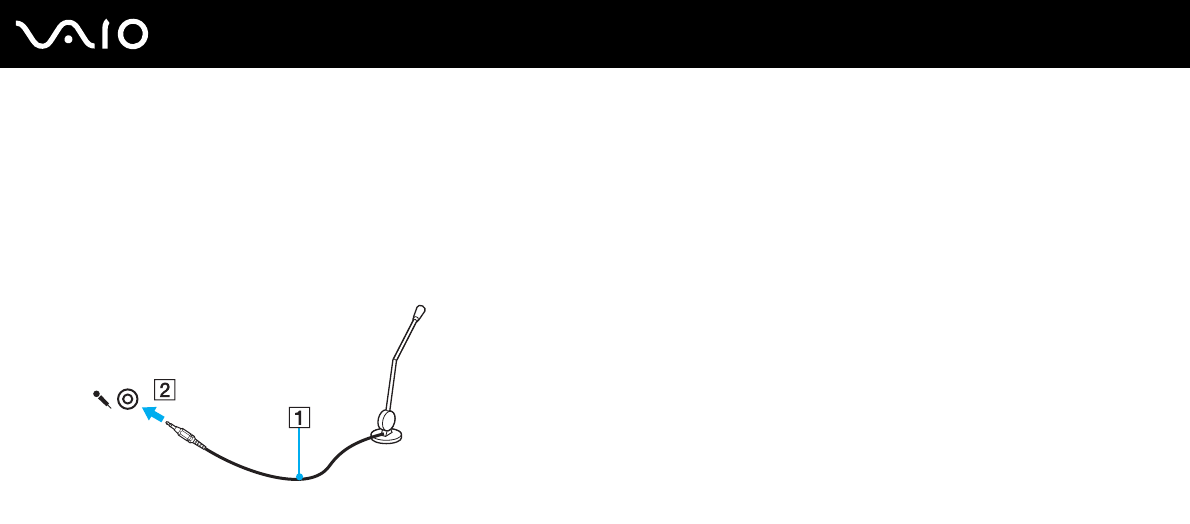
105
nN
Using Peripheral Devices
Connecting an External Microphone
If you need to use a sound input device (for example, to chat over the Internet), you need to plug in an external microphone
(not supplied).
To connect an external microphone
Plug the microphone cable (1) into the microphone jack (2) m.
✍
Make sure your microphone is designed for computer use.
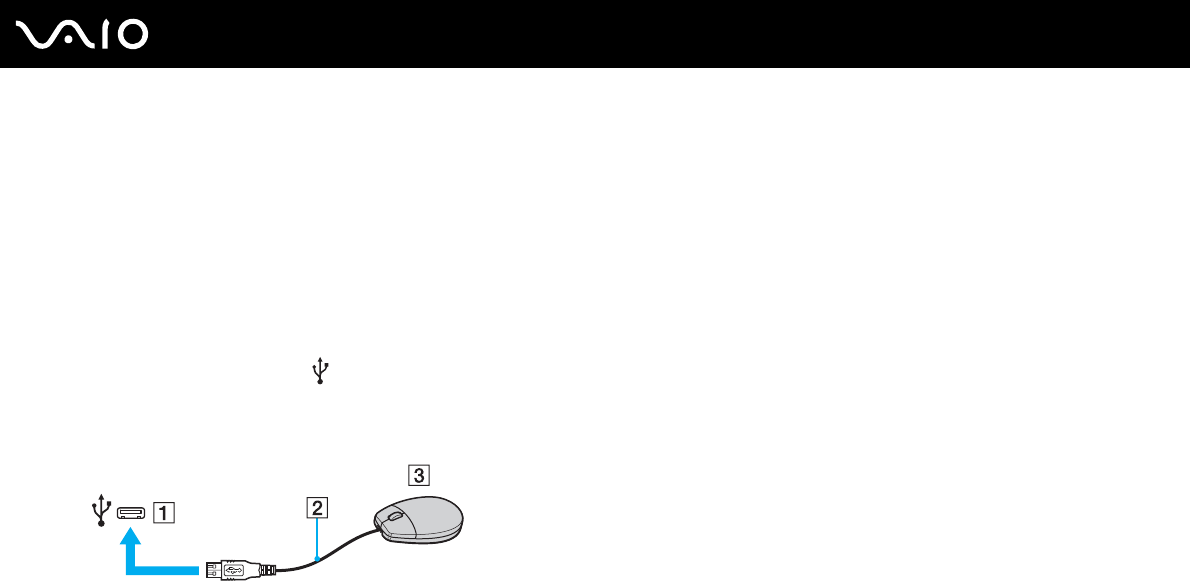
106
nN
Using Peripheral Devices
Connecting a Universal Serial Bus (USB) Device
To protect your computer and/or USB devices from damage, observe the following:
❑When moving the computer with USB devices connected, avoid exposing the USB ports to shock or impact.
❑Do not put the computer into a bag or carrying case when it has USB devices connected.
Connecting a USB Mouse
To connect a USB mouse
1Choose the USB port (1) you prefer to use.
2Plug the USB mouse cable (2) into the USB port.
You can now use your USB mouse (not supplied) (3).
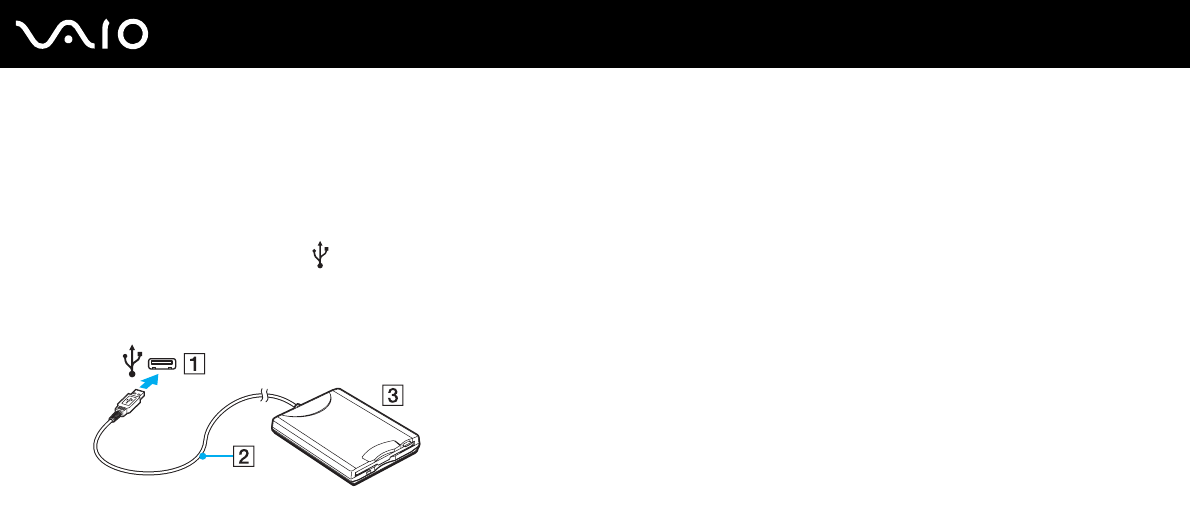
107
nN
Using Peripheral Devices
Connecting a USB Floppy Disk Drive
You can purchase a USB floppy disk drive and connect it to your computer.
To connect a USB floppy disk drive
1Choose the USB port (1) you prefer to use.
2Plug the USB floppy disk drive cable (2) into the USB port.
Your USB floppy disk drive (3) is now ready for use.
!
When using a USB floppy disk drive, do not apply force to the USB port. This may cause a malfunction.

108
nN
Using Peripheral Devices
Disconnecting a USB floppy disk drive
You can disconnect a USB floppy disk drive when your computer is on or off. Disconnecting the drive when the computer is
in a power saving mode (Sleep or Hibernate) may cause the computer to malfunction.
To disconnect a USB floppy disk drive
✍
To disconnect a USB floppy disk drive when your computer is off, skip steps 1 to 5.
1Close all programs accessing the floppy disk drive.
2Double-click the Safely Remove Hardware icon on the taskbar.
3Select the floppy disk drive you want to unplug.
4Click Stop.
5Follow the on-screen instructions to remove the floppy disk drive.
6Disconnect the floppy disk drive from the computer.
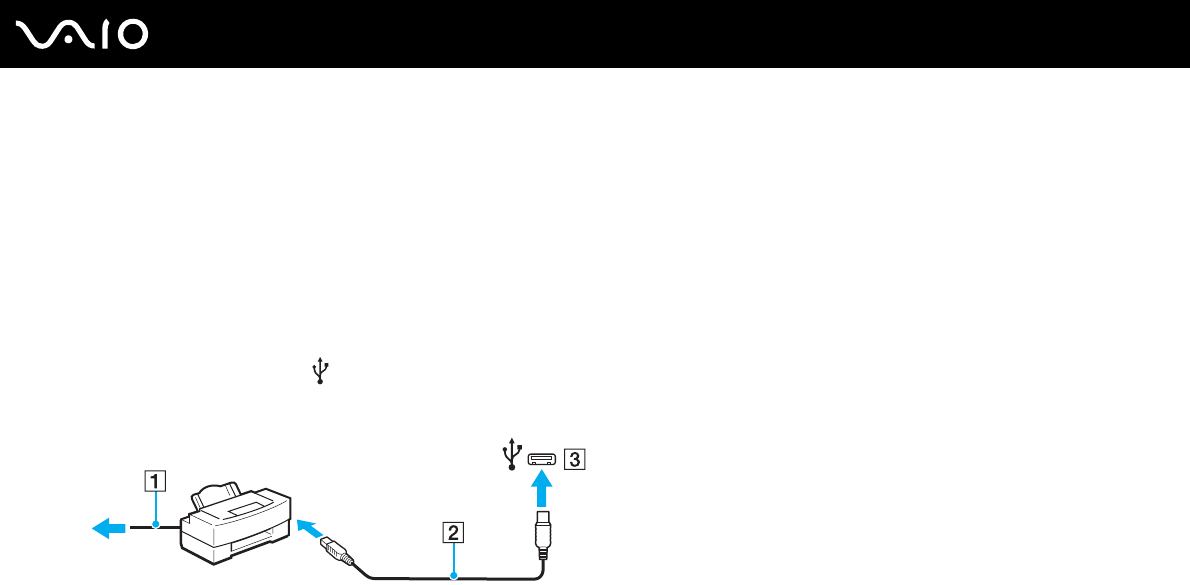
109
nN
Using Peripheral Devices
Connecting a Printer
You can connect a Windows-compatible printer to your computer to print documents.
Connecting a Printer Using the USB Port
You can connect a USB printer compatible with your version of Windows to the computer.
To connect a printer using the USB port
1Plug the power cord (1) of your printer into an AC outlet.
2Choose the USB port (3) you prefer to use.
3Plug one end of a USB printer cable (2) (not supplied) into the USB port and the other end to your printer.

110
nN
Using Peripheral Devices
Connecting an i.LINK Device
Notes on connecting i.LINK devices
❑Your computer is equipped with an i.LINK port, which you can use to connect an i.LINK device, such as a digital video
camcorder.
❑The i.LINK port on your computer does not supply power to an external device. If the external device requires external
power, be sure to connect it to a power source.
❑The i.LINK port supports transfer rates up to 400 Mbps. However, the actual transfer rate depends on the transfer rate of
the external device.
❑The optional i.LINK cables may not be available in some countries or areas.
❑An i.LINK connection with other compatible devices is not fully guaranteed.
❑The i.LINK connection may not be available depending on the software applications, operating system, and i.LINK-
compatible devices you use. See the manual that came with your software for more information.
❑Check the working conditions and operating system compatibility of i.LINK-compatible PC peripherals (for example, an
HDD or a CD-RW drive) before you connect them to your computer.
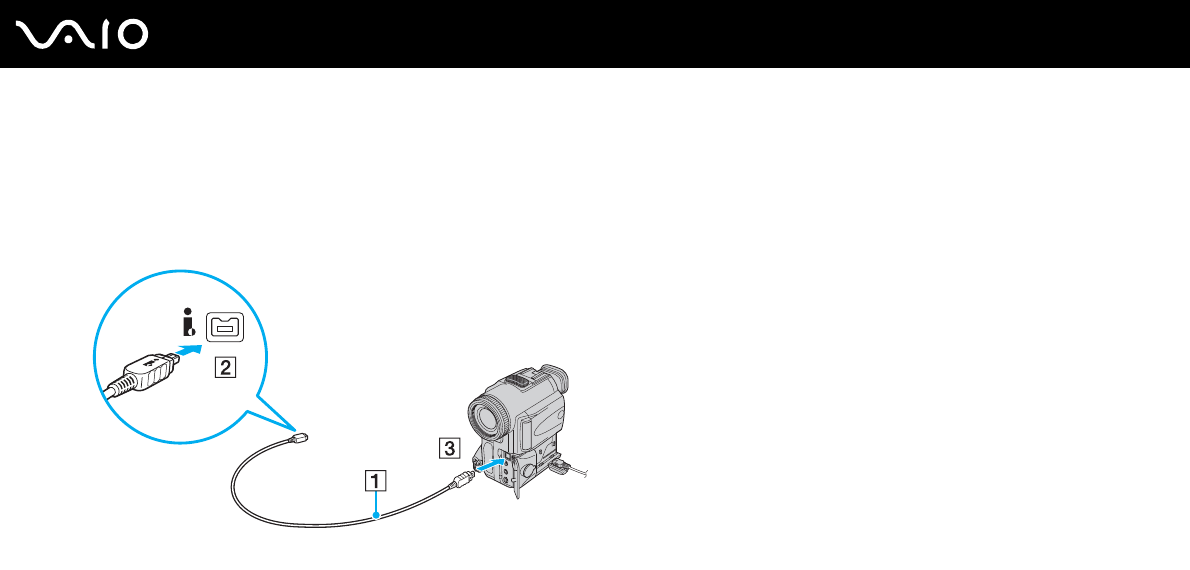
111
nN
Using Peripheral Devices
Connecting a Digital Video Camcorder
To connect a digital video camcorder
Plug one end of an i.LINK cable (1) (not supplied) into the i.LINK port (2) on the computer and the other end into the DV In/
Out port (3) on the digital video camcorder.
✍
On Sony digital video cameras, ports labeled DV Out, DV In/Out, or i.LINK are i.LINK-compatible.
The Sony digital video camcorder shown here is an example. Your digital video camcorder may need to be connected differently.
You cannot access the pictures stored on a Memory Stick when using an i.LINK connection.

112
nN
Customizing Your VAIO Computer
Customizing Your VAIO Computer
This section briefly describes how to change the main settings of your VAIO computer. Among other things, you will learn
how to use and customize the look of your Sony software and utilities.
❑Setting the Password (page 113)
❑Using Fingerprint Authentication (page 125)
❑Using the Trusted Platform Module (TPM) (page 133)
❑Setting Up Your Computer with the VAIO Control Center (page 143)
❑Using the Power Saving Modes (page 144)
❑Managing Power with the VAIO Power Management (page 149)
❑Protecting the Hard Disk (page 151)

113
nN
Customizing Your VAIO Computer
Setting the Password
In addition to the Windows password, you can use BIOS functions to set two types of passwords to protect your computer:
the power-on password and the hard disk password*.
Once you have set the power-on password, you will be prompted to enter the password after the VAIO logo appears to start
your computer. The power-on password allows you to protect your computer from unauthorized access.
The hard disk password provides additional security for the data stored on your built-in storage device. If you set the hard
disk password, other users will not be able to access the data without knowing the password, even if the password-protected
built-in storage device is removed from your computer and is installed in another computer.
* The hard disk password is not available on models with two built-in storage devices in RAID configuration. See the online specifications to find out about your storage
device configuration.

114
nN
Customizing Your VAIO Computer
Adding the Power-on Password
The power-on password is provided to protect your computer from unauthorized access.
There are two types of the power-on passwords: the machine password and the user password. The machine password is
provided for users with administrative rights on the computer to change all the setup options in the BIOS setup screen, as
well as to start the computer. The user password is provided for the standard users to allow for changing some of the BIOS
setup options, as well as starting the computer. To set the user password, you must first set the machine password.
!
Once you have set the power-on password, you cannot start your computer without entering the password. Be sure not to forget the password. Write
down your password and keep it safe and private from other people.
If you forget the power-on password and need assistance to reset it, a password reset fee will be charged, and your computer may need to be sent in
for service to reset the password.
✍
If your computer is equipped with a fingerprint sensor and you have set the power-on password in conjunction with the fingerprint authentication
function, you can substitute fingerprint authentication for password entry when turning on your computer. For more information, see Using Fingerprint
Authentication (page 125).

115
nN
Customizing Your VAIO Computer
To add the power-on password (machine password)
1Turn on the computer.
2Press the F2 key when the VAIO logo appears.
The BIOS setup screen appears. If not, restart the computer and press the F2 key several times when the VAIO logo
appears.
3Press the < or , key to select Security to display the Security tab, select Set Machine Password, and then press the
Enter key.
4On the password entry screen, enter the password twice and press the Enter key.
The password can be up to 32 alphanumeric characters (including spaces) long.
5Select Password when Power On under Security and press the Enter key.
6Change the setting from Disabled to Enabled.
7Press the < or , key to select Exit, select Exit Setup, and then press the Enter key.
At the confirmation prompt, press the Enter key.

116
nN
Customizing Your VAIO Computer
To add the power-on password (user password)
!
Make sure you set the machine password before setting the user password.
1Turn on the computer.
2Press the F2 key when the VAIO logo appears.
The BIOS setup screen appears. If not, restart the computer and press the F2 key several times when the VAIO logo
appears.
3Enter the machine password and press the Enter key.
4Press the < or , key to select Security to display the Security tab, select Set User Password, and then press the
Enter key.
5On the password entry screen, enter the password twice and press the Enter key.
The password can be up to 32 alphanumeric characters (including spaces) long.
6Press the < or , key to select Exit, select Exit Setup, and then press the Enter key.
At the confirmation prompt, press the Enter key.

117
nN
Customizing Your VAIO Computer
Changing/Removing the Power-on Password
To change or remove the power-on password (machine password)
1Turn on the computer.
2Press the F2 key when the VAIO logo appears.
The BIOS setup screen appears. If not, restart the computer and press the F2 key several times when the VAIO logo
appears.
3Enter the machine password and press the Enter key.
4Press the < or , key to select Security to display the Security tab, select Set Machine Password, and then press the
Enter key.
5On the password entry screen, enter the current password once and a new password twice, and then press the Enter key.
To remove the password, leave the Enter New Password and Confirm New Password fields blank and press the Enter
key.
6Press the < or , key to select Exit, select Exit Setup, and then press the Enter key.
At the confirmation prompt, press the Enter key.

118
nN
Customizing Your VAIO Computer
To change or remove the power-on password (user password)
1Turn on the computer.
2Press the F2 key when the VAIO logo appears.
The BIOS setup screen appears. If not, restart the computer and press the F2 key several times when the VAIO logo
appears.
3Enter the user password and press the Enter key.
4Press the < or , key to select Security to display the Security tab, select Set User Password, and then press the
Enter key.
5On the password entry screen, enter the current password once and a new password twice, and then press the Enter key.
To remove the password, leave the Enter New Password and Confirm New Password fields blank and press the Enter
key.
6Press the < or , key to select Exit, select Exit Setup, and then press the Enter key.
At the confirmation prompt, press the Enter key.

119
nN
Customizing Your VAIO Computer
Adding the Hard Disk Password
The hard disk password provides additional security for the data stored on your built-in storage device. If you enable the hard
disk password, this adds an extra level of security.
When adding the hard disk password, you must set both the master and user passwords. The master password is provided
for users with administrative rights on the computer to reset the user password in the BIOS setup screen. The user password
is provided to lock your built-in storage device. Once you set the user password, you will have to enter the password along
with the power-on password (if set), after the VAIO logo appears.
!
The hard disk password is not available on models with two built-in storage devices in RAID configuration. See the online specifications to find out
about your storage device configuration.
You cannot start your computer with the master password.
If you forget the master password or the keyboard fails, which is critical to password entry, no bypass is possible and the data stored on the built-in
storage device will not be accessible. There is NO RESET of this password. You will have to replace the built-in storage device at your own expense and
lose all the data originally stored on the device. Be sure to write down the master password and keep it safe and private from other people.
✍
If your computer is equipped with a fingerprint sensor and you have set the hard disk password in conjunction with the fingerprint authentication
function, you can substitute fingerprint authentication for password entry when turning on your computer. For more information, see Using Fingerprint
Authentication (page 125).

120
nN
Customizing Your VAIO Computer
To add the hard disk password
1Turn on the computer.
2Press the F2 key when the VAIO logo appears.
The BIOS setup screen appears. If not, restart the computer and press the F2 key several times when the VAIO logo
appears.
✍
If you have set the power-on password, enter your power-on password.
3Press the < or , key to select Security to display the Security tab, select Hard Disk Password, and then press the
Enter key.
The Hard Disk Password entry screen appears.
✍
If your computer is equipped with both the built-in flash memory storage device and the built-in hard disk drive, select Hard Disk 1 Password for the
flash memory storage device or select Hard Disk 2 Password for the hard disk drive.
4Select Enter Master and User Passwords and press the Enter key.
5Select Continue on the warning screen and press the Enter key.
6Enter the master password twice and press the Enter key.
The password should be up to 32 alphanumeric characters (including spaces) long.
7Enter the user password twice and press the Enter key.
The password should be up to 32 alphanumeric characters (including spaces) long.
8At the confirmation prompt, press the Enter key.
9Press the Esc key and then the < or , key to select the Exit tab.
10 Press the M or m key to select Exit Setup and press the Enter key.
At the confirmation prompt, press the Enter key.

121
nN
Customizing Your VAIO Computer
Changing/Removing the Hard Disk Password
To change the hard disk password
1Turn on the computer.
2Press the F2 key when the VAIO logo appears.
The BIOS setup screen appears. If not, restart the computer and press the F2 key several times when the VAIO logo
appears.
✍
If you have set the power-on password, enter your power-on password.
3Press the < or , key to select Security to display the Security tab, select Hard Disk Password, and then press the
Enter key.
The Hard Disk Password entry screen appears.
✍
If your computer is equipped with both the built-in flash memory storage device and the built-in flash hard disk drive, select Hard Disk 1 Password for
the memory storage device or select Hard Disk 2 Password for the hard disk drive.
4Select Change Master Password or Change User Password and press the Enter key.
5Enter the current password once and then a new password twice.
6Press the Enter key.
7Press the Enter key when the success message appears.
8Press the Esc key and then the < or , key to select the Exit tab.
9Press the M or m key to select Exit Setup and press the Enter key.
At the confirmation prompt, press the Enter key.

122
nN
Customizing Your VAIO Computer
To remove the hard disk password
1Turn on the computer.
2Press the F2 key when the VAIO logo appears.
The BIOS setup screen appears. If not, restart the computer and press the F2 key several times when the VAIO logo
appears.
✍
If you have set the power-on password, enter your power-on password.
3Press the < or , key to select Security to display the Security tab, select Hard Disk Password, and then press the
Enter key.
The Hard Disk Password entry screen appears.
✍
If your computer is equipped with both the built-in flash memory storage device and the built-in flash hard disk drive, select Hard Disk 1 Password for
the memory storage device or select Hard Disk 2 Password for the hard disk drive.
4Select Enter Master and User Passwords and press the Enter key.
5Enter the current password for Enter Current Hard Disk Master Password and press the Enter key.
6Press the Enter key without entering any letter for the remaining fields.
7Press the Enter key when the success message appears.
8Press the Esc key and then the < or , key to select the Exit tab.
9Press the M or m key to select Exit Setup and press the Enter key.
At the confirmation prompt, press the Enter key.

123
nN
Customizing Your VAIO Computer
Adding the Windows Password
The Windows password comes in handy when you have to share a single computer with other people. By setting the Windows
password, you can protect your user account from unauthorized access.
Entry of the Windows password will be prompted after you select your user account.
!
Be sure not to forget the password. Write down your password and keep it safe and private from other people.
✍
If your computer is equipped with a fingerprint sensor and you have set the Windows password in conjunction with the fingerprint authentication
function, you can substitute fingerprint authentication for password entry when turning on your computer. For more information, see Using Fingerprint
Authentication (page 125).
To add the Windows password
1Click Start and Control Panel.
2Click User Accounts and Family Safety or User Accounts.
3Click User Accounts.
4Click Create a password for your account under Make changes to your account.
5In the New password and Confirm new password fields, enter the password for your account.
6Click Create password.
✍
See Windows Help and Support for more information on the Windows password.

124
nN
Customizing Your VAIO Computer
Changing/Removing the Windows Password
To change the Windows password
1Click Start and Control Panel.
2Click User Accounts and Family Safety or User Accounts.
3Click User Accounts.
4Click Change your password.
5In the Current password field, enter your current password.
6In the New password and Confirm new password fields, enter a new password.
7Click Change password.
To remove the Windows password
1Click Start and Control Panel.
2Click User Accounts and Family Safety or User Accounts.
3Click User Accounts.
4Click Remove your password.
5In the Current password field, enter the current password that you want to remove.
6Click Remove password.

125
nN
Customizing Your VAIO Computer
Using Fingerprint Authentication
Your computer may be equipped with a fingerprint sensor to provide you with additional convenience. A small horizontal bar
located between the left and right touch pad buttons is the sensor of the fingerprint reader and will be referred to as the
fingerprint sensor hereinafter.
See the online specifications to find out whether your model is equipped with the fingerprint sensor.
Once you have registered your fingerprint(s), the fingerprint authentication function offers:
❑A substitute for password entry
❑Logging onto Windows (page 130)
If you have registered your fingerprints for your user account, you can substitute fingerprint authentication for
password entry when logging onto Windows.
❑Power-on Security feature (page 130)
If you have set the power-on password (page 114) and/or the hard disk password* (page 119), you can substitute
fingerprint authentication for password entry when starting your computer.
❑Password Bank for quick web site access (page 131)
You can substitute fingerprint authentication for entering information (user accounts, passwords, etc.) required to access
the password-protected web sites.
❑File Safe feature to encrypt/decrypt data (page 131)
With the File Safe feature, you can encrypt files and folder to create an encrypted archive. To decrypt or access such
encrypted archives, you can use the fingerprint authentication or enter the password you specified for encryption.
❑Application launcher function for quick application access (page 131)
Once you have assigned an application to your finger, you can then swipe the finger across the fingerprint sensor to
launch the assigned application.
* The hard disk password is not available on models with two built-in storage devices in RAID configuration. See the online specifications to find out about your storage
device configuration.

126
nN
Customizing Your VAIO Computer
Precautions on Using Fingerprint Authentication
❑The fingerprint authentication technology does not ensure complete user authentication or complete protection of your
data and hardware.
Sony assumes no liability for any problems and damages arising out of your use of or inability to use the fingerprint sensor.
❑The fingerprint recognition rate depends on your operating conditions and varies among individuals as well.
❑Be sure to make a backup copy of the data stored on the built-in storage device, especially in the encrypted archives
created with the File Safe feature, before sending your computer for repair.
Sony assumes no liability for any loss or modification of your data that might have occurred during the course of repair.
❑In case the built-in storage device has to be initialized, for example after the repair work, the fingerprint templates will be
lost. You will have to register them all over again.
❑The maintenance and management of data concerning fingerprint authentication must be carried out at your own risk.
Sony assumes no liability for any defects arising out of your data maintenance and management.
❑Before disposing of your computer or transferring it to a third person, it is strongly recommended you erase the fingerprint
data registered on the fingerprint sensor after erasing the data stored on your built-in storage device. See Erasing the
Registered Fingerprints (page 132) for the detailed procedure.
❑A fingerprint sensor may malfunction or be damaged if you scratch its surface with:
❑a solid or sharp-pointed object
❑fine objects, for example swiping a finger covered with dirt across the fingerprint sensor
❑Discharge static electricity from your finger by touching a metallic object especially during dry seasons (e.g. winter) before
scanning your fingerprint. Static electricity may cause the fingerprint sensor to malfunction.

127
nN
Customizing Your VAIO Computer
Registering a Fingerprint
To use the fingerprint authentication function, you must register your fingerprint(s) in your computer.
✍
Set the Windows password on your computer before registration. See Adding the Windows Password (page 123) for the detailed instructions.
To register a fingerprint
!
Up to 10 fingerprints can be registered for each user and up to 21 fingerprints can be registered for logging onto your system using the Power-on
Security feature. You can also select the fingerprint you want to use for the Power-on Security feature later.
1Click Start, All Programs, Protector Suite QL, and Control Center.
2Click Fingerprints and Initialize.
3Follow the on-screen instructions.
✍
For detailed information, see the help file.

129
nN
Customizing Your VAIO Computer
!
Place your fingertip flat in the center of the fingerprint sensor.
Scan your fingerprint from the top joint of the finger to the fingertip.
Keep your finger in contact with the fingerprint sensor while swiping.
Fingerprint registration may fail if you move your finger too fast or too slow. Let the fingerprint sensor take about one second to scan your fingerprint.
You may not be able to register and/or have your fingerprint(s) recognized if your finger is excessively dry or wet, wrinkled, injured, dirty, etc.
Register more than one fingerprint in case that the fingerprint sensor fails to recognize the fingerprint.
Be sure to clean your fingertip(s) and the fingerprint sensor before swiping in order to keep good recognition performance.

130
nN
Customizing Your VAIO Computer
Logging Onto Your System
To use the fingerprint authentication function in place of password entry to log onto your system, you need to set the power-
on, hard disk*, and Windows passwords and configure your computer for fingerprint authentication.
For setting the power-on, hard disk*, and Windows passwords, see Setting the Password (page 113).
* The hard disk password is not available on models with two built-in storage devices in RAID configuration. See the online specifications to find out about your storage
device configuration.
For detailed information, see the help file included with the Protector Suite QL.
Logging onto Windows
If you have registered your fingerprints for your user account, you can substitute fingerprint authentication for Windows
password entry. To log onto Windows, swipe the registered finger across the fingerprint sensor when the Windows log-on
screen appears.
Power-on Security feature
If you have set the power-on password (page 114) and/or the hard disk password (page 119), you can substitute fingerprint
authentication for password entry when starting your computer.

131
nN
Customizing Your VAIO Computer
Using the Password Bank
Once you have registered your user information (user accounts, passwords, etc.) for web sites in the Password Bank, you
can substitute fingerprint authentication for entering information required to access the password-protected web sites.
For detailed information, see the help file included with the Protector Suite QL.
!
You may not be able to use the Password Bank feature depending on the web site you access.
Using the File Safe Feature
With the File Safe feature, you can create an encrypted archive to include a file and/or folder for protection against
unauthorized access. The encrypted archive can be decrypted or unlocked for included file/folder access by swiping your
finger across the fingerprint sensor or entering the backup password you specified for encryption.
For detailed information, see the help file included with the Protector Suite QL.
Using the Application Launcher
The application launcher feature is available on your computer for launching your preferred application (executable file) that
is assigned to one of your fingers with a registered fingerprint. Once you have assigned an application to your finger, you can
launch the assigned application simply by swiping the finger across the fingerprint sensor.
For detailed information, see the help file included with the Protector Suite QL.

132
nN
Customizing Your VAIO Computer
Using Fingerprint Authentication with the TPM
With the TPM data encryption feature, using fingerprint authentication can strengthen computer security. For instructions on
how to use the TPM, see Using the Trusted Platform Module (TPM) (page 133).
To use fingerprint authentication with the TPM, your computer needs to be equipped with both a fingerprint sensor and the
TPM. See the online specifications to find out whether your model is equipped with them.
For detailed information, see the help file included with the Protector Suite QL.
Erasing the Registered Fingerprints
Before disposing of your computer or transferring it to a third person, it is strongly recommended you erase the fingerprint
data registered on the fingerprint sensor after erasing the data stored on your built-in storage device.
To erase the registered fingerprints
1Turn on the computer.
2Press the F2 key when the VAIO logo appears.
The BIOS setup screen appears. If not, restart the computer and press the F2 key several times when the VAIO logo
appears.
3Press the < or , key to select Security to display the Security tab.
4Press the m key to select Clear Fingerprint Data and press the Enter key.
5At the confirmation prompt, select Continue and press the Enter key.
The fingerprint data registered on the fingerprint sensor is erased automatically after your system restarts.

133
nN
Customizing Your VAIO Computer
Using the Trusted Platform Module (TPM)
The Trusted Platform Module (TPM) is embedded in selected models only and provides your computer with basic security
functions. In combination with the TPM, you can encrypt and decrypt your data to strengthen computer security against
inappropriate access.
TPMs are defined by Trusted Computing Group (TCG) and also called security chips.
See the online specifications to find out whether your model is equipped with the TPM.

134
nN
Customizing Your VAIO Computer
Precautions on Using the TPM
❑Although your computer is provided with the TPM security functions, these functions do not ensure complete protection
of your data and hardware. Sony assumes no liability for any problems and damages arising out of your use of the
functions.
❑After you have installed the Infineon TPM Professional Package, you need to set a few TPM passwords on your
computer. Without these passwords, you will not be able to restore any TPM-protected data. Be sure to write down the
passwords and keep them safe and private from other people.
❑Be sure to make backup copies of the latest emergency recovery archive file, emergency recovery token file, password
reset token file, and personal secret file and keep them safe and private from other people before sending your computer
for repair. The data stored in the TPM that is embedded on the motherboard may be lost or corrupted during the course
of repair.
❑During the course of repair, the TPM will also be replaced if the motherboard needs replacement. In such a case, use the
backup copies of the emergency recovery archive file, emergency recovery token file, password reset token file, and
personal secret file to restore the TPM configuration.
❑Be sure to make a backup copy of the data stored on the built-in storage device before sending your computer for repair.
The built-in storage device may be initialized and returned after the repair work and, in such a case, you will not be able
to restore the data on the device using the backup copies of the emergency recovery archive file, emergency recovery
token file, password reset token file, and personal secret file.
❑Make sure you set up the automatic backup operations after completing the TPM initialization wizard. If the window
containing the Run automatic backup now check box is displayed after the setup, select the check box and update the
backup files. The restore process using the backup files may fail if you do not set up the automatic backup operations.
❑The maintenance and management of TPM-protected data must be carried out at your own risk. Sony assumes no liability
for any defects arising out of your data maintenance and management.

135
nN
Customizing Your VAIO Computer
Important Notice
❑Do not encrypt the files containing keys to be used for encryption and the folders that include such files.
Encrypting the files in the folders containing basic user keys and others, using the Encrypting File System (EFS) will
disable you to launch your TPM software and decrypt the encrypted data in the following cases:
❑The TPM software has been installed.
❑The platform has been initialized.
❑The EFS function has been enabled in user initialization process.
With the default settings, the files in the folders below cannot be encrypted because they have system attributes.
Do not change the system attributes of the files in the folders below.
!
The following folders are invisible by default.
❑Folders containing basic user keys and others
C:\<username>\All Users\Infineon\TPM Software 2.0\BackupData
C:\<username>\All Users\Infineon\TPM Software 2.0\PlatformKeyData
C:\<username>\All Users\Infineon\TPM Software 2.0\RestoreData
(C:\<username>\All Users is a shortcut to C:\ProgramData.)
C:\<username>\<account>\AppData\Roaming\Infineon\TPM Software 2.0\UserKeyData

136
nN
Customizing Your VAIO Computer
❑Do not encrypt any one of the following archive, backup, or token files. There will be no way to restore them if you
carelessly encrypt them.
Sony assumes no liability for any troubles and damages arising out of your careless encryption of the following files and
folders including them.
❑Automatic backup file
Default file name: SPSystemBackup.xml
Default path: None (Clicking Browse displays the <userfolder>\Documents\Security Platform window.)
❑Storage folder for automatic backup data
Default folder name: SPSystemBackup
The folder is created as the subfolder for the SPSystemBackup.xml file.
❑Token file for restoring the TPM configuration
Default file name: SPEmRecToken.xml
Default path: Removable media (FD, USB memory, etc.)
❑Key and certificate backup file
Default file name: SpBackupArchive.xml
Default path: None (Clicking Browse displays the <userfolder>\Documents\Security Platform window.)
❑PSD backup file
Default file name: SpPSDBackup.fsb
Default path: None (Clicking Browse displays the <userfolder>\Documents\Security Platform window.)

137
nN
Customizing Your VAIO Computer
❑Do not encrypt any one of the following password reset token or secret files. There will be no way to reset the password
if you carelessly encrypt them.
Sony assumes no liability for any troubles and damages arising out of your careless encryption of the following files and
folders including them.
❑Password reset token file
Default file name: SPPwdResetToken.xml
Default path: Removable media (FD, USB memory, etc.)
❑Password reset secret file
Default file name: SPPwdResetSecret.xml
Default path: Removable media (FD, USB memory, etc.)

138
nN
Customizing Your VAIO Computer
Configuring the TPM
To use the embedded TPM, you need to:
1Enable the TPM in the BIOS setup screen.
2Install the Infineon TPM Professional Package.
3Initialize and configure the TPM.
To enable the TPM in the BIOS setup screen
1Turn on your computer.
2Press the F2 key when the VAIO logo appears.
The BIOS setup screen appears. If not, restart the computer and press the F2 key several times when the VAIO logo
appears.
3Press the < or , key to select the Security tab, the M or m key to select Change TPM State, and then the Enter key.
4Press the M or m key to select Enable and then the Enter key.
5Press the < or , key to select Exit, select Exit Setup, and then press the Enter key.
6After your system restarts, select Execute in the confirmation window and then press the Enter key.
✍
You can also disable the TPM and clear the TPM configuration in the BIOS setup screen.
!
Before enabling the TPM, be sure to set the power-on and hard disk* passwords to protect against unauthorized modification of the TPM configuration.
* The hard disk password is not available on models with two built-in storage devices in RAID configuration. See the online specifications to find out
about your storage device configuration.
If the TPM is enabled, it will take longer before the VAIO logo appears due to security checks at computer startup.
You will not be able to access any TPM-protected data if you clear the TPM ownership. Before clearing the TPM configuration, be sure to make backup
copies of the TPM-protected data.

139
nN
Customizing Your VAIO Computer
To install the Infineon TPM Professional Package
Read the Readme.txt in the C:\Infineon\Readme folder. Then, double-click setup.exe in the C:\Infineon folder to install the
package.
To install this package, you must have administrative rights on the computer.
!
You need to set a few passwords while installing the Infineon TPM Professional Package. Without these passwords, you will not be able to restore
any TPM-protected data or backup files. Be sure to write down the passwords and keep them safe and private from other people.
To initialize and configure the TPM
See the on-screen documentation for detailed information. To open the documentation, click Start, All Programs, Infineon
Security Platform Solution, and Help.
!
The maintenance and management of TPM-protected data must be carried out at your own risk. Sony assumes no liability for any defects arising out
of your data maintenance and management.

140
nN
Customizing Your VAIO Computer
Using BitLocker Drive Encryption with the TPM
BitLocker Drive Encryption is a data encryption feature that is available on models with Windows Vista Ultimate. Enabling
BitLocker Drive Encryption in conjunction with the TPM encrypts all data on the built-in storage device.
See the online specifications to find out whether your computer has Windows Vista Ultimate installed. For detailed information
on how to use and configure BitLocker Drive Encryption, see Windows Help and Support.
Notes on using BitLocker Drive Encryption
❑Be sure to initialize the TPM with the Infineon TPM Professional Package before enabling BitLocker Drive Encryption.
If you enable it without initializing the TPM, a TPM owner password is not generated, so you will not be able to configure
the Infineon TPM Professional Package.
❑The Infineon TPM Professional Package does not make a backup copy of a file (recovery password) for BitLocker
Drive Encryption.
❑An additional BitLocker system partition (S drive) has been pre-configured. This system partition uses 1.5 GB of your total
built-in storage device volume.
❑You must enable the TPM in the BIOS setup screen in order to turn on BitLocker Drive Encryption.
❑Do not encrypt data on a storage device (such as a USB flash memory device) on which a recovery key is stored using
BitLocker Drive Encryption.

141
nN
Customizing Your VAIO Computer
To unlock the encrypted data with a recovery key stored on a USB flash memory device
To unlock the encrypted data with a recovery key stored on a USB flash memory device, your system needs to access the
USB flash memory device when you boot the computer. Follow these steps to configure the boot order in the BIOS setup
screen:
1Turn on your computer.
2Press the F2 key when the VAIO logo appears.
The BIOS setup screen appears. If not, restart the computer and press the F2 key several times when the VAIO logo
appears.
3Press the < or , key to select the Security tab, the M or m key to select Change TPM State, and then the Enter key.
4Press the M or m key to select Enable and then the Enter key.
5Press the < or , key to select Boot and then select Enabled for External Device Boot.
6Press the M or m key to select Boot Priority and then the Enter key.
7Press the F5 or F6 key to change the boot device order so that Internal Hard Disk is listed higher than External Device.
!
You need to move Internal Optical Drive to the top of the list to recover the computer system using your recovery discs.
8Press the < or , key to select Exit, select Exit Setup, and then press the Enter key.
9After your system restarts, select Execute in the confirmation window and then press the Enter key.
10 Follow the instructions in Windows Help and Support to enable BitLocker Drive Encryption.
11 Save the recovery password to the USB flash memory device in the window for saving the recovery password.
12 Follow the on-screen instructions.
The encryption process will start.

143
nN
Customizing Your VAIO Computer
Setting Up Your Computer with the VAIO Control Center
The VAIO Control Center utility allows you to access system information and to specify preferences for system behavior.
To use the VAIO Control Center
1Click Start, All Programs, and VAIO Control Center.
2Select the desired control item and change the settings.
3Once finished, click OK.
The setting of the desired item has been changed.
✍
For more information about each option, see the help file included with the VAIO Control Center.
Some of the control items will not be visible if you open the VAIO Control Center as a standard user.

144
nN
Customizing Your VAIO Computer
Using the Power Saving Modes
You can take advantage of the power management settings to conserve battery life. In addition to the normal operating mode,
your computer has two distinct power saving modes: Sleep and Hibernate. When using battery power, you should be aware
that the computer will automatically enter Hibernate mode if the remaining battery life becomes short, regardless of the power
management setting you select.
!
If the battery charge level falls below 10%, you should either connect the AC adapter to recharge the battery pack or shut down your computer and
install a fully charged battery pack.
Using Normal Mode
This is the normal state of the computer when it is in use. The green power indicator light is lit in this mode.

145
nN
Customizing Your VAIO Computer
Using Sleep Mode
Sleep mode turns off the LCD screen and places the storage device(s) and the CPU into a low power consumption mode.
The orange power indicator light blinks slowly in this mode.
!
If you do not intend to use your computer for a long period of time while it is disconnected from AC power, place the computer into Hibernate mode or
turn it off.
To activate Sleep mode
Click Start, the arrow next to the Lock button, and Sleep.
✍
If your computer is equipped with an optical disc drive, you cannot insert a disc when the computer is in Sleep mode.
Your computer comes out of Sleep mode quicker than out of Hibernate mode.
Sleep mode uses more power than Hibernate mode.
!
If the battery runs out of power while your computer is in Sleep mode, you will lose all unsaved data. Going back to the previous work state is
impossible. To avoid loss of data, you should save your data frequently.

146
nN
Customizing Your VAIO Computer
To return to Normal mode
❑Press any key.
❑Press the power button on your computer.
!
If you press and hold the power button for more than four seconds, your computer will turn off automatically. You will lose all unsaved data.
✍
You can use the VAIO Control Center to configure your computer to return to Normal mode when you open the LCD screen lid. This power resuming
preference will be lost if you remove both the AC adapter and the battery pack. See Setting Up Your Computer with the VAIO Control Center (page 143).
If the computer is not used for a certain period of time, it will enter Sleep mode. To modify this, you can change the Sleep
mode settings.
To change the Sleep mode settings
1Right-click the power status icon on the taskbar and select Power Options.
2Click Change plan settings under the current power plan.
3Change the time to place the computer into Sleep mode and click Save Changes.

147
nN
Customizing Your VAIO Computer
Using Hibernate Mode
In Hibernate mode, the state of the system is saved on the built-in storage device and power is turned off. Even when the
battery runs out of power, no data will be lost. The power indicator light is unlit in this mode.
✍
If you do not intend to use your computer for a long period of time, place the computer into Hibernate mode.
To activate Hibernate mode
Press the Fn+F12 keys.
The computer enters Hibernate mode.
Alternatively, you can click Start, the arrow next to the Lock button, and Hibernate to place the computer into Hibernate
mode.
✍
When your computer is in Hibernate mode, you cannot insert a disc.
Hibernate mode requires more time than Sleep mode to be activated.
Hibernate mode uses less power than Sleep mode.
!
Do not move your computer before its power indicator light turns off.

148
nN
Customizing Your VAIO Computer
To return to Normal mode
Press the power button.
The computer returns to its normal state.
!
If you press and hold the power button for more than four seconds, your computer will turn off automatically.
✍
It takes more time to return to Normal mode from Hibernate mode than from Sleep mode.
You can use the VAIO Control Center to configure your computer to return to Normal mode when you open the LCD screen lid. This power resuming
preference will be lost if you remove both the AC adapter and the battery pack. See Setting Up Your Computer with the VAIO Control Center (page 143).

149
nN
Customizing Your VAIO Computer
Managing Power with the VAIO Power Management
Power management helps you set up power plans for running on AC or battery power to suit your requirements for power
consumption.
The VAIO Power Management is a software application developed exclusively for VAIO computers. With this software
application, you can enhance the Windows power management functions to ensure better operation of your computer and
longer battery life. See the help file included with the software for more information.
Selecting a Power Plan
When you start the computer, a power status icon appears on the taskbar. This icon indicates what kind of power source you
are using at that time, for example, AC power. Click this icon to display the window that shows your power status.
The VAIO Power Management function is added to the Windows Power Options.
To select a power plan
1Right-click the power status icon on the taskbar and select Power Options.
2Select your desired power plan.
To change the power plan settings
1Click Change plan settings under your desired power plan in the Power Options window.
Change the Sleep mode and display settings as needed.
2If you need to change the advanced settings, click Change advanced power settings and go to step 3.
Otherwise, click Save changes.
3Click the VAIO Power Management tab.
Change the settings for each item.
4Click OK.

150
nN
Customizing Your VAIO Computer
VAIO Power Management Viewer
You can view performance with the power plan that was modified with the VAIO Power Management.
To start the VAIO Power Management Viewer
1Click Start, All Programs, and VAIO Control Center.
2Click Power Management and VAIO Power Management Viewer.
✍
Alternatively, you can launch the VAIO Power Management Viewer by pressing the S1 button.

151
nN
Customizing Your VAIO Computer
Protecting the Hard Disk
If your computer is equipped with a built-in hard disk drive, then it has the VAIO HDD Protection utility preinstalled for
customizing your settings for protecting your hard disk drive against shock hazards. You can select the sensitivity level of the
built-in shock sensor to set the appropriate protection level.
See the online specifications to find out about your storage device configuration.
!
Be aware that the built-in flash memory storage device is not included in the scope of the VAIO HDD Protection utility.
Activating VAIO HDD Protection
To protect your hard disk drive against shock hazards, you must first activate the VAIO HDD Protection.
To activate VAIO HDD Protection
1Click Start, All Programs, and VAIO Control Center.
2Click Security and Hard Disk Drive Protection Settings.
3Select the Activate hard disk drive protection check box.
4Select one of the desired sensitivity level.
5Click OK.
For more information, see the help file included with the software.
!
The VAIO HDD Protection is designed to minimize possibilities of damage to hard disk drives and user data. It does not ensure 100% data protection
under any circumstances.
Hard disk drive protection is disabled before Windows launches, and during a shift to Hibernate or Sleep mode, system recovery, and system shutdown.

152
nN
Upgrading Your VAIO Computer
Upgrading Your VAIO Computer
Your VAIO computer and memory modules use high precision components and electronic connectors technology. To avoid
invalidation of the warranty during your product warranty period, we recommend that:
❑You should contact your dealer to install a new memory module.
❑You should not install it yourself, if you are not familiar with upgrading memory on a computer.
❑You should not touch the connectors or open the memory module compartment cover.
For the type of module and amount of memory installed on your model, see the online specifications.
For assistance, contact an authorized Sony Service Center. To find the nearest center or agent, see Sony Support
Information (page 223).

153
nN
Upgrading Your VAIO Computer
Adding and Removing Memory
If you want to expand the functionality of your computer, you can increase the amount of memory by replacing the installed
memory module. Before you upgrade your computer's memory, read the notes and procedures in the following pages.
Notes on adding memory modules
❑Be sure to place your computer on a flat surface before adding or removing memory modules.
❑Be careful when changing memory. Improper installation of memory modules may cause damage to your system. This
damage may void your manufacturer's warranty.
❑
Only use memory modules that are compatible with your computer. If a memory module is not detected by the computer
or the Windows operating system becomes unstable, contact the sales dealer or the manufacturer of your memory module.
❑Electrostatic discharge (ESD) can damage electronic components. Before touching a memory module, ensure the
following:
❑The procedures described in this document assume user familiarity with the general terminology associated with
personal computers and with the safety practice and regulatory compliance requirements for using and modifying
electronic equipment.
❑Turn off your computer and disconnect it from its power sources (battery pack and AC adapter) and from any
telecommunication links, networks, or modems (if any) before you remove any cover or panel from the computer.
Failure to do so may result in personal injury or equipment damage.
❑ESD can damage memory modules and other components. Install the memory module only at an ESD workstation.
If such a station is not available, do not work in a carpeted area, and do not handle materials that produce or hold
static electricity (cellophane wrappers, for example). Ground yourself by maintaining contact with an unpainted metal
portion of the chassis while performing the procedure.
❑Do not open the memory module package before you are ready to change the module. The package protects the
module from ESD.

154
nN
Upgrading Your VAIO Computer
❑Use the special bag supplied with the memory module or wrap the module in aluminum foil to protect it from ESD.
❑Introducing any liquids, foreign substances, or objects into the memory module slots or other internal components of your
computer will result in damage to the computer and any repair costs will not be covered by the warranty.
❑Do not place the memory module in a location subject to:
❑Heat sources such as radiators or air ducts
❑Direct sunlight
❑Excessive dust
❑Mechanical vibration or shock
❑Strong magnets or speakers that are not magnetically shielded
❑Ambient temperature of more than 95°F (35°C) or less than 41°F (5°C)
❑High humidity
❑Handle the memory module with care. To avoid injuries to your hands and fingers, do not touch the edges of the
components and circuit boards inside your computer.
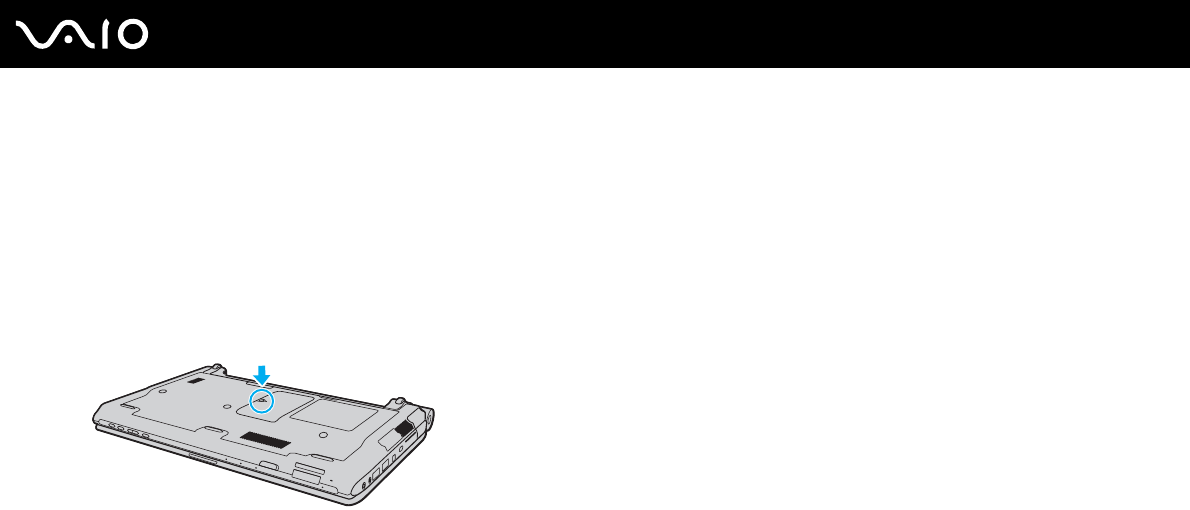
155
nN
Upgrading Your VAIO Computer
Removing and Installing a Memory Module
To change or add a memory module
1Shut down the computer and disconnect all peripheral devices.
2Unplug the computer and remove the battery pack.
3Wait about an hour until the computer cools down.
4Unscrew the screw (indicated by the arrow below) on the bottom of the computer and remove the memory module
compartment cover.
5Touch a metal object to discharge static electricity.
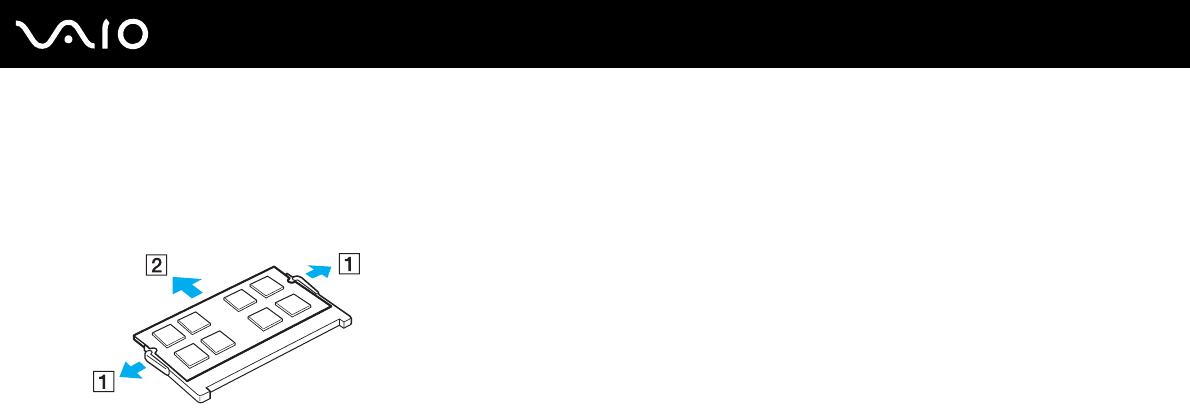
156
nN
Upgrading Your VAIO Computer
6Remove the currently installed memory module as follows:
❑Pull the latches in the direction of the arrows (1).
The memory module is released.
❑Make sure that the memory module tilts up and then pull it out in the direction of the arrow (2).
7Remove the new memory module from its packaging.
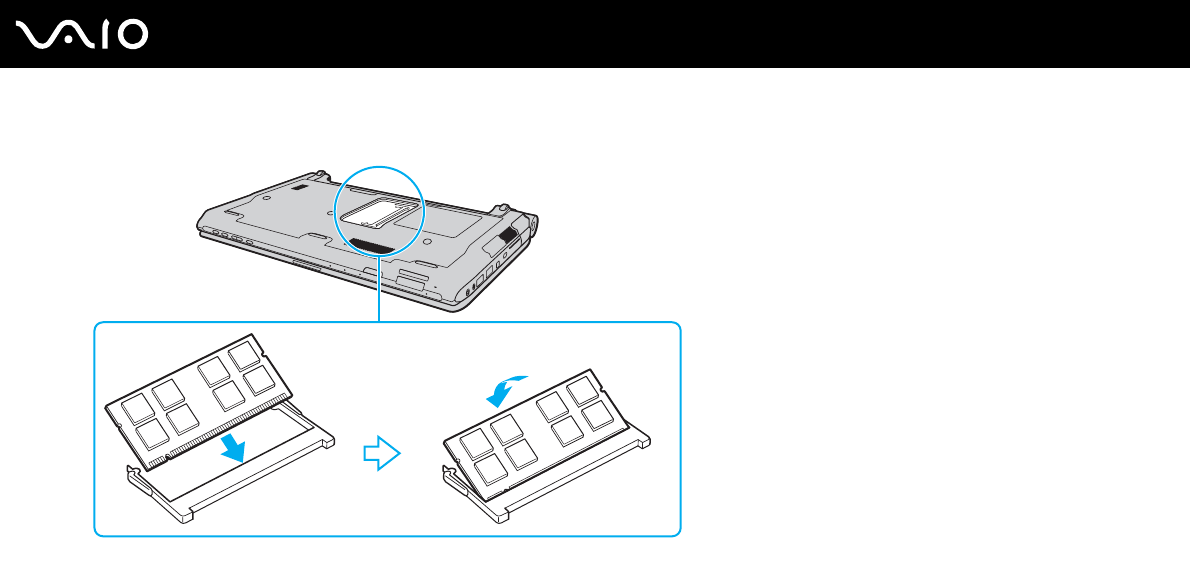
157
nN
Upgrading Your VAIO Computer
8Slide the memory module into the memory module slot and push it in until it clicks into place.
!
Do not touch any other components on the motherboard.
If you want to install only one memory module, be sure to use the lower slot.
Be sure to insert the connector edge of the memory module into the slot while aligning the notch on the module with the small projection in the open
slot. Do not force the memory module into the slot in a wrong orientation, as it may cause damage to the slot and the module.

159
nN
Upgrading Your VAIO Computer
Viewing the Amount of Memory
To view the amount of memory
1Turn on the computer.
2Click Start, All Programs, and VAIO Control Center.
3Click System Information and System Information.
You can view the amount of system memory in the right pane. If the additional memory does not appear, repeat the
installation procedure and restart the computer.

160
nN
Precautions
Precautions
This section describes safety guidelines and precautions to help you protect your VAIO computer from potential damage.
❑Handling the LCD Screen (page 161)
❑Using the Power Source (page 162)
❑Handling Your Computer (page 163)
❑Handling the Built-in MOTION EYE Camera (page 166)
❑Handling Floppy Disks (page 167)
❑Handling Discs (page 168)
❑Using the Battery Pack (page 169)
❑Using Headphones (page 171)
❑Handling the Memory Stick (page 172)
❑Handling the Hard Disk (page 173)
❑Updating Your Computer (page 174)

161
nN
Precautions
Handling the LCD Screen
❑Do not leave the LCD screen facing the sun. This could damage the LCD screen. Be careful when using your computer
near a window.
❑Do not scratch the surface of the LCD screen or exert pressure on it. This could cause a malfunction.
❑Using your computer in low temperature conditions may produce a residual image on the LCD screen. This is not a
malfunction. When the computer returns to normal temperature, the screen returns to normal.
❑A residual image may appear on the LCD screen if the same image is displayed for a long period of time. The residual
image disappears after a while. You can use a screen saver to prevent residual images.
❑The LCD screen becomes warm during operation. This is normal and does not indicate a malfunction.
❑The LCD screen is manufactured using high-precision technology. You may, however, see tiny black points and/or bright
points (red, blue, or green) that continuously appear on the LCD screen. This is a normal result of the manufacturing
process and does not indicate a malfunction.
❑Avoid rubbing the LCD screen. This could damage the screen. Use a soft, dry cloth to wipe the surface of the LCD screen.
❑Do not change the LCD screen orientation setting in the Tablet PC Settings window even when there are change options
available for selection, as this may make your computer unstable. Sony assumes no liability for any malfunctions arising
from changes to the settings.
❑Do not exert pressure on the LCD screen lid with the lid closed as it may scratch the LCD screen or soil it.

162
nN
Precautions
Using the Power Source
❑See the online specifications to check the power operation of your model.
❑Do not share the AC outlet with other power-consuming equipment, such as a photocopier or a shredder.
❑You can purchase a power strip with a surge protector. This device helps prevent damage to your computer caused by
sudden power surges, in an electrical storm, for example.
❑Do not place heavy objects on the power cord.
❑To disconnect the cord, pull it out by holding the plug. Never pull the cord itself.
❑Unplug your computer from the AC outlet if you are not planning to use the computer for a long period of time.
❑Make sure that the AC outlet is easily accessible.
❑When the AC adapter is not used, unplug it from the AC outlet.
❑Use the AC adapter supplied with your computer or genuine Sony products. Do not use any other AC adapter as it may
cause a malfunction.

163
nN
Precautions
Handling Your Computer
❑Clean the cabinet with a soft cloth, which is dry or lightly moistened with a mild detergent solution. Do not use any type
of abrasive pad, scouring powder, or solvent such as alcohol or benzine, as these may damage the finish of your
computer.
❑If you drop a solid object or any liquid onto your computer, shut down the computer, unplug it, and remove the battery
pack. You may want to have the computer checked by qualified personnel before operating it again.
❑Do not drop your computer or place any objects on top of the computer.
❑Do not place your computer in a location subject to:
❑Heat sources, such as radiators or air ducts
❑Direct sunlight
❑Excessive dust
❑Moisture or rain
❑Mechanical vibration or shock
❑Strong magnets or speakers that are not magnetically shielded
❑Ambient temperature of more than 95°F (35°C) or less than 41°F (5°C)
❑High humidity
❑Do not place electronic equipment near your computer. The electromagnetic field of the equipment may cause the
computer to malfunction.
❑Use your computer on a solid, stable surface.
❑Provide adequate air circulation to prevent internal overheating. Do not place your computer on porous surfaces such as
rugs, blankets, couches, or beds, or near materials such as curtains or draperies that may block its air vents. In case you
use the computer on your lap, make sure that the air vents are free for optimal cooling efficiency and performance.
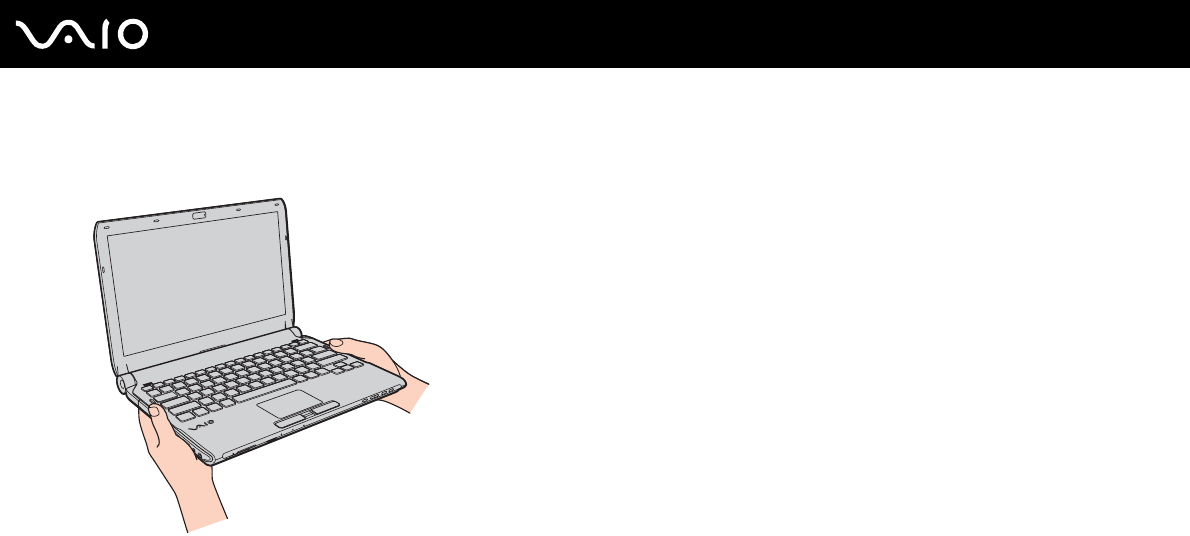
164
nN
Precautions
❑Do not grasp the port cover to lift your computer.
❑Be sure to firmly hold both sides of your computer so as not to drop the computer.
❑Your computer uses high-frequency radio signals and may cause interference to radio or TV reception. If this occurs,
relocate the computer a suitable distance away from the set.
❑Use only specified peripheral equipment and interface cables. Otherwise, problems may occur.
❑Do not use cut or damaged connection cables.
❑If your computer is brought directly from a cold location to a warm one, moisture may condense inside the computer. In
this case, allow at least one hour before turning on the computer. If any problems occur, unplug the computer and contact
an authorized Sony Service Center. To find the nearest center or agent, see Sony Support Information (page 223).
❑Make sure you disconnect the AC adapter and remove the battery pack before cleaning your computer.
❑To avoid losing data when your computer is damaged, back up your data regularly.
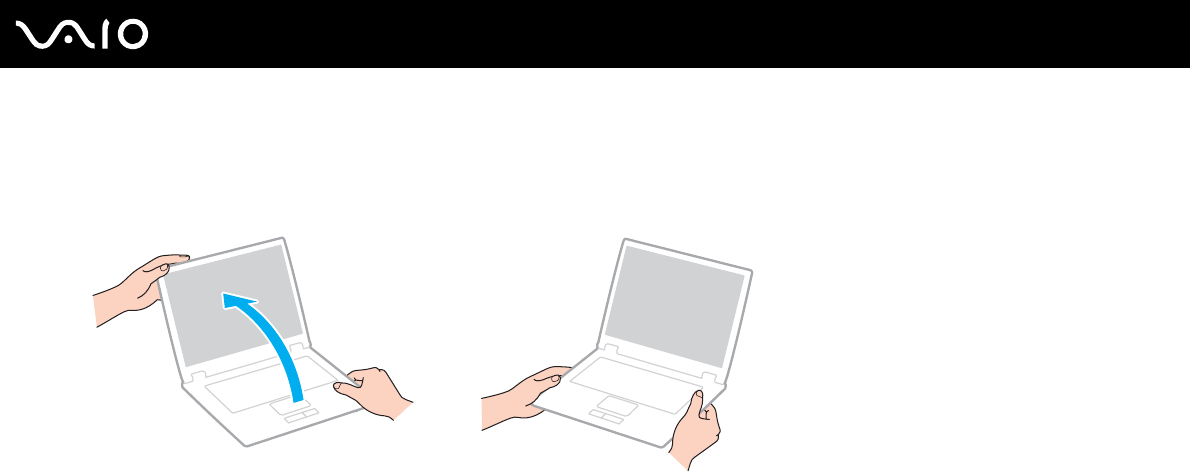
165
nN
Precautions
❑Do not exert pressure on the LCD screen or its edges when opening the LCD screen lid or lifting your computer. The LCD
screen may be sensitive to pressure or added stress, and exerting pressure may damage the screen or cause it to
malfunction. To open the computer, hold the base with one hand and gently lift the LCD screen lid with the other. To carry
the computer with the lid open, be sure to hold the computer with both hands.
❑Use a carrying case specially designed to carry your computer.

166
nN
Precautions
Handling the Built-in MOTION EYE Camera
!
The following precautions apply to the models equipped with a built-in MOTION EYE camera. See the online specifications to find out whether your
model is equipped with the camera.
❑Do not touch the lens protection cover of the built-in MOTION EYE camera, as it may cause scratches on the cover and
such scratches will appear on the captured images.
❑Do not let the direct sunlight get into the lens of the built-in MOTION EYE camera regardless of your computer's power
state, as it may cause the camera to malfunction.
❑The built-in MOTION EYE camera is disabled while videos or still images are imported from an i.LINK-compatible device
connected to the i.LINK port.
❑Clean the lens protection cover of the built-in MOTION EYE camera with a blower brush or a soft brush. If the cover is
extremely dirty, wipe it off with a soft dry cloth. Do not rub the cover, as it is sensitive to pressure.

167
nN
Precautions
Handling Floppy Disks
❑Do not open the shutter manually and touch the internal components of the floppy disk.
❑Keep floppy disks away from magnets.
❑Keep floppy disks away from direct sunlight and other sources of heat.
❑Keep floppy disks away from any liquid. Do not let them get wet. When you are not using your floppy disk, always remove
it from the floppy disk drive and put it in a storage case.
❑If the floppy disk comes with a label, make sure that the label is properly affixed. If the edge of the label is curled up, the
label may stick to the inside of the floppy disk drive and cause a malfunction or damage your floppy disk.

168
nN
Precautions
Handling Discs
❑Do not touch the surface of the disc.
❑Fingerprints and dust on the surface of a disc may cause read errors. Always hold the disc by its edges and central hole,
as shown below:
❑Proper care of the disc is essential to its continuous reliability. Do not use solvents (such as benzine, thinner, alcohol,
commercially available cleaners, or anti-static spray) which may cause damage to the disc.
❑For normal cleaning, hold the disc by its edges and use a soft cloth to wipe the surface from the center out.
❑If the disc is badly soiled, moisten a soft cloth with water, wring it out well, and use it to wipe the surface of the disc from
the center out. Wipe off any remaining moisture with a dry soft cloth.
❑Never affix an adhesive label to a disc. This will affect the use of the disc and may result in irreparable damage.

169
nN
Precautions
Using the Battery Pack
❑Do not leave battery packs in temperatures above 140°F (60°C), such as in a car parked in the sun or under direct
sunlight.
❑Battery life is shorter in a cold environment. This is due to decreased battery efficiency at low temperatures.
❑Charge battery packs at temperatures between 50°F to 86°F (10°C to 30°C). Lower temperatures require longer charging
time.
❑Do not charge the battery pack in any way other than as described in this user guide or as designated by Sony in writing.
❑For your safety, Sony recommends using the genuine Sony battery pack and AC adapter that are provided with this
product. If either of these items needs to be replaced during the life of the product, be sure to use a compatible genuine
Sony battery pack or AC adapter. Information about compatible models can be found at the following URLs:
http://www.sony.com/vaio for customers in USA and Canada.
http://www.sony.net/ for customers in Latin American countries or areas.
❑Sony disclaims and shall assume no responsibility in case of any losses or damages arising from:
❑The use of non-genuine Sony battery packs or AC adapters with your VAIO computer.
❑The disassembly, alteration of, or tampering with any Sony battery pack.
❑While the battery pack is in use or being charged, heat builds up in the battery pack. This is normal and is not cause for
concern.
❑Keep the battery pack away from all sources of heat.
❑Keep the battery pack dry.
❑Do not open or try to disassemble the battery pack.
❑Do not expose the battery pack to any mechanical shock, such as dropping it on a hard surface.
❑If you are not using your computer for a long period of time, remove the battery pack from the computer to prevent damage
to the battery pack.

170
nN
Precautions
❑If you have not used the battery pack for a considerable amount of time, the remaining battery life may become short.
However, this is normal and does not indicate a malfunction, because the battery pack will gradually discharge over time
even when not in use. Connect the AC adapter to your computer and recharge the battery pack before using the computer
again.
❑You do not need to discharge the battery pack before recharging.
❑If the battery pack quickly runs out of power after fully charged, it may be reaching the end of its life and should be
replaced.

171
nN
Precautions
Using Headphones
❑Road safety – Do not use headphones while driving, cycling, or operating any motorized vehicle. It may create a traffic
hazard and is illegal in some areas. It can also be potentially dangerous to play loud music while walking, especially at
pedestrian crossings.
❑Preventing hearing damage – Avoid using headphones at high volume. Hearing experts advise against continuous, loud
and extended play. If you experience a ringing in your ears, reduce the volume or discontinue use.

172
nN
Precautions
Handling the Memory Stick
❑Do not touch the Memory Stick connector with your finger or metallic objects.
❑Use only the adhesive label supplied with the Memory Stick as a label.
❑Do not bend, drop, or expose the Memory Stick.
❑Do not disassemble or modify the Memory Stick.
❑Do not let the Memory Stick get wet.
❑Do not use or store the Memory Stick in a location subject to:
❑Static electricity
❑Electrical noise
❑Extremely high temperatures, such as in a car parked in the sun
❑Direct sunlight
❑High humidity
❑Corrosive substances
❑Use the storage case supplied with the Memory Stick.
❑Be sure to make a backup copy of your valuable data.
❑Keep the Memory Stick and the Memory Stick adaptors out of reach of children. There is a risk of swallowing them.
❑When using the Memory Stick Duo, do not use a fine-tipped pen to write on the label adhered to the Memory Stick Duo.
Exerting pressure on the media may damage internal components.

173
nN
Precautions
Handling the Hard Disk
!
The following precautions apply to models with a built-in hard disk drive. See the online specifications to find out whether your model is equipped with
the hard disk drive.
The hard disk drive has a high storage density and reads or writes data in a short time. However, it can be easily damaged
by mechanical vibration, shock, or dust.
Although the hard disk drive has the internal safety device to prevent losing data due to mechanical vibration, shock, or dust,
you should be careful when handling your computer.
To avoid damaging your hard disk drive
❑Do not subject your computer to sudden movements.
❑Keep your computer away from magnets.
❑Do not place your computer in a location subject to mechanical vibration or in an unstable position.
❑Do not move your computer while the power is on.
❑Do not turn off the power or restart your computer while reading or writing data to the hard disk drive.
❑Do not use your computer in a place subject to extreme changes in temperature.
✍
If the hard disk drive is damaged, the data cannot be restored.

174
nN
Precautions
Updating Your Computer
Be sure to install the latest updates on your computer with the following software applications so that the computer can run
more efficiently.
❑Windows Update
Click Start, All Programs, and Windows Update and then follow the on-screen instructions.
❑VAIO Update 4
Click Start, All Programs, VAIO Update 4, and VAIO Update Options and then follow the on-screen instructions.
!
Your computer must be connected to the Internet to download the updates.

175
nN
Troubleshooting
Troubleshooting
This section describes how to solve common problems you might encounter when using your VAIO computer. Many problems
have simple solutions. Try these suggestions before visiting the Sony online support web site
at the following URLs:
http://esupport.sony.com/EN/VAIO/ for
customers in USA
http://www.sony.ca/support/ for customers in Canada
http://esupport.sony.com/LA/ for customers in Spanish-speaking Latin American countries or areas
http://esupport.sony.com/BR/ for customers in Brazil
❑Computer (page 177)
❑System Security (page 185)
❑Battery (page 186)
❑Built-in MOTION EYE Camera (page 188)
❑Internet (page 190)
❑Networking (page 192)
❑Bluetooth Technology (page 195)
❑Optical Discs (page 199)
❑Display (page 204)
❑Printing (page 208)
❑Microphone (page 209)
❑Mouse (page 210)
❑Speakers (page 211)
❑Touch Pad (page 213)

177
nN
Troubleshooting
Computer
What should I do if my computer does not start?
❑Make sure your computer is securely plugged into a power source and turned on and the power indicator light is lit.
❑Make sure the battery pack is installed properly and charged.
❑Disconnect all connected USB devices (if any), and then restart your computer.
❑Remove any extra memory modules you may have installed since purchase, and then restart your computer.
❑If your computer is plugged into a power strip or an uninterruptible power supply (UPS), make sure the power strip or UPS
is plugged into a power source and turned on.
❑If you are using an external display, make sure it is plugged into a power source and turned on. Make sure the brightness
and contrast controls are adjusted correctly. See the manual that came with your display for more information.
❑Unplug the AC adapter and remove the battery pack. Wait three to five minutes. Reinstall the battery pack, plug the AC
adapter, and then press the power button to turn on your computer.
❑Condensation may cause your computer to malfunction. If this occurs, do not use the computer for at least one hour.
❑Check that you are using the supplied Sony AC adapter. For your safety, use only the genuine Sony rechargeable battery
pack and AC adapter, which are supplied by Sony for your VAIO computer.

178
nN
Troubleshooting
What should I do if the green power indicator light turns on but my screen remains blank?
❑Press the Alt+F4 keys several times to close the application window. An application error may have occurred.
❑Press the Ctrl+Alt+Delete keys and click the arrow next to the Shut down button and Restart.
❑Press and hold the power button for more than four seconds to shut down your computer. Unplug the AC adapter and
leave the computer for about five minutes. Then plug the AC adapter and turn on the computer again.
!
Turning off your computer with the power button or the Ctrl+Alt+Delete keys may cause loss of unsaved data.
What should I do if my computer or software stops responding?
❑If your computer stops responding while a software application is running, press the Alt+F4 keys to close the application
window.
❑If the Alt+F4 keys do not work, click Start, the arrow next to the Lock button, and Shut Down to turn off your computer.
❑If your computer does not turn off, press the Ctrl+Alt+Delete keys and click the arrow next to the Shut down button
and Shut Down.
If the Windows Security window appears, click Shut Down.
❑If your computer still does not turn off, press and hold the power button until the computer turns off.
!
Turning off your computer with the Ctrl+Alt+Delete keys or the power button may cause loss of unsaved data.
❑Unplug the AC adapter and remove the battery pack. Wait three to five minutes. Reinstall the battery pack, plug the AC
adapter, and then press the power button to turn on your computer.
❑Try reinstalling the software.
❑Contact the software publisher or designated provider for technical support.

179
nN
Troubleshooting
Why doesn't my computer enter Sleep or Hibernate mode?
Your computer may become unstable if the operating mode is changed before the computer completely enters Sleep or
Hibernate mode.
To restore your computer to Normal mode
1Close all open programs.
2Click Start, the arrow next to the Lock button, and Restart.
3If your computer does not restart, press the Ctrl+Alt+Delete keys and click the arrow next to the Shut down button and
Restart.
4If this procedure does not work, press and hold the power button until the computer turns off.
!
Turning off your computer with the power button may cause loss of unsaved data.
What should I do if the charge indicator light is blinking fast and my computer does not
start?
❑This problem could be due to the battery pack not being installed properly. To resolve this problem, turn off your computer
and remove the battery pack. Then reinstall the battery pack to the computer again. For details, see Installing the
Battery Pack (page 25).
❑If the problem persists after performing the above, it means the installed battery pack is not compatible. Remove the
battery pack and contact an authorized Sony Service Center. To find the nearest center or agent, see Sony Support
Information (page 223).

180
nN
Troubleshooting
What should I do if a message appears notifying of either incompatibility or the improper
installation of the battery pack and my computer then enters Hibernate mode?
❑This problem could be due to the battery pack not being installed properly. To resolve this problem, turn off your computer
and remove the battery pack. Then reinstall the battery pack to the computer again. For details, see Installing the
Battery Pack (page 25).
❑If the problem persists after performing the above, it means the installed battery pack is not compatible. Remove the
battery pack and contact an authorized Sony Service Center. To find the nearest center or agent, see Sony Support
Information (page 223).
Why does the System Properties window display a slower CPU speed than the
maximum?
This is normal. Because your computer's CPU utilizes a type of CPU speed controlling technology for power conservation
purposes, System Properties may display the current CPU speed instead of the maximum speed.
What should I do if Windows does not accept my password and returns a message, Enter
Onetime Password?
If you enter a wrong power-on password three times consecutively, the Enter Onetime Password message appears and
Windows will not start. Press and hold the power button for more than four seconds to check that the power indicator light
turns off. Wait for 10 or 15 seconds, then restart your computer and enter the correct password. When entering the password,
check that the Num lock and Caps lock indicators are unlit. If both or either of the lights is lit, press the Num Lk (or Num Lock)
key or the Caps Lock key to turn off the indicator before entering the password.

181
nN
Troubleshooting
What should I do if my game software does not work or it keeps crashing?
❑Check the web site of the game if there are any patches or updates to download.
❑Make sure you have installed the latest video driver.
❑On some VAIO models, the graphics memory is shared with the system. The optimal graphic performance in this case is
not guaranteed.
What should I do if I cannot remember the power-on password?
If you have forgotten the power-on password, contact an authorized Sony Service Center to reset it. A reset fee will be
charged. To find the nearest center or agent, see Sony Support Information (page 223).
How can I change the boot device order?
You can use one of the BIOS functions to change the boot device order. Follow these steps:
1Turn on your computer.
2Press the F2 key when the VAIO logo appears.
The BIOS setup screen appears. If not, restart the computer and press the F2 key several times when the VAIO logo
appears.
3Press the < or , key to select Boot.
4Press the M or m key to select the drive whose boot device order you want to change.
5Press the F5 or F6 key to change the boot device order.
6Press the < or , key to select Exit, select Exit Setup, and then press the Enter key.
At the confirmation prompt, press the Enter key.

182
nN
Troubleshooting
Why doesn't my screen turn off after the automatic turn-off time has passed?
The VAIO original screen saver disables the timer setting, which you can select using the Windows power options, for your
screen to turn off.
Select a screen saver other than the VAIO original screen saver.
What should I do if I cannot boot my computer from the external device connected to the
computer?
To boot your computer from the external device, for example the USB floppy disk drive and the USB/i.LINK optical disc drive,
you need to change the boot device.
Turn on your computer and press the F11 key when the VAIO logo appears.

183
nN
Troubleshooting
How do I reduce the volume of the recovery partition?
Your built-in storage device* contains the recovery partition where data for the system recovery is stored. If your computer
includes a built-in flash memory storage drive, you might want to reduce the volume of the recovery partition by following
these steps:
* See the online specifications to find out about your storage device configuration.
1Insert the recovery disc into the optical disc drive while your computer is on, turn off the computer, and then turn it on
once again.
If you are using an external optical disc drive, press the F11 key when the VAIO logo appears during the startup process.
!
Use the recovery disc you created upon delivery of your computer.
2Select your keyboard layout from the drop-down list and click Next.
3Select your operating system and click Next.
4Click VAIO Recovery Center.
5Click Restore Complete System and Start.
6Select Skip and click Next.
You will be prompted to select whether or not to keep the VAIO Value-added contents.
7Select No and click Next.
8Follow the on-screen instructions.
!
The above procedure involves system recovery. The applications and data you added on the storage drive before reducing the volume of the recovery
partition will all be lost.
Once you have reduced the volume of the recovery partition, you need the recovery disc for later system recovery.

184
nN
Troubleshooting
How do I check the volume of the recovery partition?
Your built-in storage device contains the recovery partition where data for the system recovery is stored. To check the volume
of the recovery partition, follow these steps:
1Click Start, right-click Computer, and select Manage.
2Click Disk Management under Storage in the left pane.
The volume of the recovery partition and the total volume of the C drive are displayed in the Disk 0 row in the center pane.

185
nN
Troubleshooting
System Security
How can I protect my computer against security threats, such as viruses?
The Microsoft Windows operating system is preinstalled on your computer. The best way to protect your computer against
security threats, such as viruses, is to download and install the latest Windows updates regularly.
You can get important Windows updates by doing the following:
!
Your computer must be connected to the Internet to download the updates.
1Connect to the Internet.
2Double-click the Windows Security Alerts icon on the taskbar.
3Follow the on-screen instructions to set up automatic or scheduled updates.
How do I keep my antivirus software updated?
You can keep the Microsoft Windows Live OneCare software program current with the latest updates from Microsoft
Corporation.
To download and install the latest security updates, follow these steps:
!
Your computer must be connected to the Internet to download the updates.
1Click Start, All Programs, and Windows Live OneCare.
2Click Check for Updates in the Protection Plus section.
3The Windows Live OneCare Updates balloon appears on the taskbar.
4Follow the on-screen instructions to download updates.

186
nN
Troubleshooting
Battery
How do I find the battery charging status?
You can check the battery charging status by the charge indicator. See Charging the Battery Pack (page 28) for more
information.
When is my computer using AC power?
When your computer is directly connected to the AC adapter, it uses AC power, even if the battery pack is installed.
When should I recharge the battery pack?
❑When the battery charge level falls below 10%.
❑When both the charge and power indicator lights blink.
❑When you have not used the battery pack for a long period of time.
When should I replace the battery pack?
If the battery pack quickly runs out of power after fully charged, it may be reaching the end of its life and should be replaced.
To check the battery charge capacity, see To check the battery charge capacity (page 30).

187
nN
Troubleshooting
Should I be concerned that the installed battery pack is warm?
No, it is normal for the battery pack to be warm when it is powering your computer.
Can my computer enter Hibernate mode while using battery power?
Your computer can enter Hibernate mode while using battery power, but some software programs and peripheral devices
prevent the system from entering Hibernate mode. If you are using a program that prevents the system from entering
Hibernate mode, save your data frequently to avoid losing data. See Using Hibernate Mode (page 147) for information on
how you can manually activate Hibernate mode.

188
nN
Troubleshooting
Built-in MOTION EYE Camera
!
The following Q & A entries apply to models with a built-in MOTION EYE camera only. See the online specifications to find out whether your model is
equipped with the camera.
Why does the viewer window show no images or poor-quality images?
❑The built-in MOTION EYE camera cannot be shared by more than one software application. If another software
application is using the camera, exit the application before using the built-in MOTION EYE camera.
❑The viewer window may show some noise, for example horizontal streaks, if you view a rapid-moving object. This is
normal and does not indicate a malfunction.
❑If the problem persists, restart your computer.
Why are captured images poor in quality?
❑The images captured under the fluorescent light may show reflections of light.
❑A dark portion in captured images may appear as a noise.
❑If the lens protection cover is dirty, you cannot take a clear shot. Clean the cover. See Handling the Built-in MOTION
EYE Camera (page 166).
Why do captured images contain dropped frames and audio interruptions?
❑The effect settings on your software application may cause dropped frames. See the help file included with your software
application for more information.
❑There may be more software applications running than your computer can handle. Exit the applications that you are not
currently using.
❑The power management function of your computer may be active. Check the CPU performance.

189
nN
Troubleshooting
Why does movie playback show dropped frames when my computer is running on the
battery?
The battery pack is running out of power. Connect your computer to an AC power source.
Why do the images captured by the built-in MOTION EYE camera flicker?
This problem occurs when you use the camera under fluorescent lights due to the mismatch between lighting output
frequency and shutter speed.
To reduce flicker noise, change the direction of the camera or the brightness of camera images. In some software
applications, you can set an appropriate value to one of the camera properties (e.g. light source, flicker, etc.) to eliminate
flicker noise.
Why is the video input from the built-in MOTION EYE camera suspended for a few
seconds?
The video input may be suspended for a few seconds if:
❑a shortcut key with the Fn key is used.
❑the CPU load increases.
This is normal and does not indicate a malfunction.
What should I do if my computer becomes unstable when it enters a power saving mode
while the built-in MOTION EYE camera is in use?
❑Do not place your computer into Sleep or Hibernate mode while you are using the built-in MOTION EYE camera.
❑If your computer automatically enters Sleep or Hibernate mode, change the corresponding power saving mode setting.
To change the setting, see Using the Power Saving Modes (page 144).

190
nN
Troubleshooting
Internet
!
The following Q & A entries apply to models with a built-in modem only. See the online specifications to find out whether your model is equipped with
the modem.
What should I do if my modem does not work?
❑Make sure the telephone cable is securely plugged into the modem port on your computer and the wall jack.
❑Make sure the telephone cable is working. Plug the cable into an ordinary telephone and listen for a dial tone.
❑Make sure that the telephone number the program is dialing is correct.
❑Make sure the software you are using is compatible with your computer's modem. (All preinstalled Sony programs are
compatible.)
❑Make sure the modem is the only device connected to your telephone line.
❑Follow these steps to check the settings:
1Click Start and Control Panel.
2Click Hardware and Sound.
3Click Phone and Modem Options.
4On the Modems tab, check that your modem is listed.
5On the Dialing Rules tab, check the location information is correct.

191
nN
Troubleshooting
Why is my modem connection slow?
Your computer is equipped with a V.92/V.90 compatible modem. Many factors may influence modem connection speed,
including telephone line noise or compatibility with telephone equipment, such as fax machines or other modems. If you think
your modem is not connecting properly to other PC-based modems, fax machines, or your ISP, do any of the following:
❑Ask your telephone company to verify your telephone line is free of any line noise.
❑If your problem is fax-related, make sure there are no problems with the fax machine you are calling and that it is
compatible with fax modems.
❑If you are having a problem connecting with your ISP, make sure the ISP is not experiencing technical problems.
❑If you have a second telephone line, try connecting the modem to that line.

192
nN
Troubleshooting
Networking
What should I do if my computer cannot connect to a wireless LAN access point?
❑Connection capability is affected by distance and obstructions. You may need to move your computer away from
obstructions or closer to any access point you may be using.
❑Make sure the WIRELESS switch is on and the WIRELESS indicator light is lit on your computer.
❑Make sure power to the access point is on.
❑Follow these steps to check the settings:
1Click Start and Control Panel.
2Click View network status and tasks under Network and Internet.
3Click Connect to a network to confirm that your access point is selected.
❑Make sure the encryption key is correct.
❑Make sure Maximum Performance is selected for Wireless Adapter Settings in the Power Options window. Selecting
any other option may result in a communication failure. To change the settings, follow these steps:
1Right-click the power status icon on the taskbar and select Power Options.
2Click Change plan settings under the current power plan.
3Click Change advanced power settings.
4Select the Advanced settings tab.
5Double-click Wireless Adapter Settings and Power Saving Mode.
6Select Maximum Performance from the drop-down list both for On battery and Plugged in.

193
nN
Troubleshooting
What should I do if I cannot access the Internet?
❑Check the access point settings. See the manual that came with your access point for more information.
❑Make sure your computer and the access point are connected to one another.
❑Move your computer away from obstacles or closer to any access point you may be using.
❑Make sure your computer is properly configured for Internet access.
❑Make sure Maximum Performance is selected for Wireless Adapter Settings in the Power Options window. Selecting
any other option may result in a communication failure. Follow the steps in What should I do if my computer cannot
connect to a wireless LAN access point? (page 192) to change the settings.
Why is the data transfer speed slow?
❑The wireless LAN data transfer speed is affected by distance and obstructions between devices and access points. Other
factors include device configurations, radio conditions, and software compatibility. To maximize the data transfer speed,
move your computer away from obstacles or closer to any access point you may be using.
❑If you are using a wireless LAN access point, the device may be temporarily overloaded depending on how many other
devices are communicating via the access point.
❑If your access point interferes with other access points, change the access point channel. See the manual that came with
your access point for more information.
❑Make sure Maximum Performance is selected for Wireless Adapter Settings in the Power Options window. Selecting
any other option may result in a communication failure. Follow the steps in What should I do if my computer cannot
connect to a wireless LAN access point? (page 192) to change the settings.

194
nN
Troubleshooting
How do I avoid data transfer interruptions?
❑When your computer is connected to an access point, data transfer interruptions may occur if a large file is exchanged or
the computer is placed in close proximity to microwaves and cordless telephones.
❑Move your computer closer to the access point.
❑Make sure the access point connection is intact.
❑Change the access point channel. See the manual that came with your access point for more information.
❑Make sure Maximum Performance is selected for Wireless Adapter Settings in the Power Options window. Selecting
any other option may result in a communication failure. Follow the steps in What should I do if my computer cannot
connect to a wireless LAN access point? (page 192) to change the settings.
What are channels?
❑Wireless LAN communication uses divided frequency bands known as channels. Third-party wireless LAN access point
channels may be preset to different channels from Sony devices.
❑If you are using a wireless LAN access point, see connectivity information contained in the manual that came with your
access point.
Why does the network connection stop when I change the encryption key?
Two computers with the wireless LAN function may lose a peer-to-peer network connection if the encryption key is changed.
You can either change the encryption key back to the original profile or re-enter the key on both computers so the key
matches.

195
nN
Troubleshooting
Bluetooth Technology
What should I do if other Bluetooth devices cannot find my computer?
❑Make sure both devices have the Bluetooth function enabled.
❑If the WIRELESS indicator light is unlit, turn on the WIRELESS switch.
❑You cannot use the Bluetooth function when your computer is in a power saving mode. Bring the computer back to Normal
mode, then turn on the WIRELESS switch.
❑Your computer and the device may be too far apart. Wireless Bluetooth technology works best when the devices are within
33 feet (10 meters) of each other.
Why can't my computer find other Bluetooth devices?
If the connected device is also connected to other devices, it may not appear in the Bluetooth Devices window or you may
not be able to communicate with the device.
What should I do if I cannot find the Bluetooth device I want to communicate with?
❑Check that the Bluetooth function of the device you want to communicate with is on. See the other device's manual for
more information.
❑If the device you want to communicate with is already communicating with another Bluetooth device, it may not be found
or it may not be able to communicate with your computer.
❑To allow other Bluetooth devices to communicate with your computer, follow these steps:
1Click Start, Control Panel, Hardware and Sound, Bluetooth Devices, and Bluetooth Settings.
2Click the Options tab and select the Allow Bluetooth devices to find this computer check box.

196
nN
Troubleshooting
What should I do if other Bluetooth devices cannot connect to my computer?
❑Make sure the other devices are authenticated.
❑To allow other Bluetooth devices to communicate with your computer, follow these steps:
1Click Start, Control Panel, Hardware and Sound, Bluetooth Devices, and Bluetooth Settings.
2Click the Options tab and select the Allow Bluetooth devices to find this computer check box.
❑The data transfer distance can be shorter than 33 feet (10 meters) depending on existing obstacles between the two
devices, on radio wave quality, and on the operating system or the software in use. Move your computer and Bluetooth
devices closer to each other.
❑If the device you want to communicate with is already communicating with another Bluetooth device, it may not be found
or it may not be able to communicate with your computer.
❑Check that the Bluetooth function of the device you want to communicate with is on. See the other device's manual for
more information.

197
nN
Troubleshooting
Why is my Bluetooth connection slow?
❑The data transfer speed depends on the obstructions and/or the distance between the two devices, on the radio wave
quality, and on the operating system or the software in use. Move your computer and Bluetooth devices closer to each
other.
❑The 2.4 GHz radio frequency used by Bluetooth and wireless LAN devices is also used by other devices. Bluetooth
devices incorporate technology that minimizes interference from other devices using the same wavelength, however,
communication speed and connection range may be reduced. Interference from other devices may also stop
communications altogether.
❑Connection capability is affected by distance and obstructions. You may need to move your computer away from obstacles
or closer to the device to which it is connected.
❑Identify and remove obstacles between your computer and the device to which it is connected.
❑Large files may occasionally be corrupted during continuous transfer due to limitations of the Bluetooth standard and
electromagnetic interference in the environment.
Why can't I use the services supported by the connected Bluetooth device?
Connection is only possible for services also supported by the computer with the Bluetooth function. For more details, search
for Bluetooth information using Windows Help and Support. To open Windows Help and Support, click Start and Help
and Support.
Can I use a device with Bluetooth technology on airplanes?
With Bluetooth technology, your computer transmits a radio frequency of 2.4 GHz. Sensitive locations, such as hospitals and
airplanes, may have restrictions on use of Bluetooth devices to avoid radio interference. Check with facility staff to see if use
of the Bluetooth function on the computer is permitted.

198
nN
Troubleshooting
Why can't I use the Bluetooth function when I log onto my computer as a user with a
standard user account?
The Bluetooth function may not be available to a user with a standard user account on your computer. Log onto the computer
as a user with administrative rights.
Why can't I use the Bluetooth devices when I switch users?
If you switch users without logging off your system, the Bluetooth devices will not work. Be sure to log off before switching
users. To log off your system, click Start, the arrow next to the Lock button, and Log Off.
Why can't I exchange business card data with a mobile phone?
The business card exchange function is not supported.

199
nN
Troubleshooting
Optical Discs
!
The following Q & A entries apply to models with a built-in optical disc drive only. See the online specifications to find out whether your model is
equipped with the optical disc drive.
Why does my computer freeze when I try to read a disc?
The disc that your computer is trying to read may be dirty or damaged. Follow these steps:
1Press the Ctrl+Alt+Delete keys and click the arrow next to the Shut down button and Restart to restart the computer.
2Remove the disc from the optical disc drive.
3Check the disc for dirt or damage. If you need to clean the disc, see Handling Discs (page 168) for instructions.
What should I do if the drive tray does not open?
❑Make sure your computer is on.
❑If the power supply to the optical disc drive is disabled by the VAIO Power Management, the substitute drive eject button
on the optical disc drive will not work. Use the drive eject button located on the right front edge of the computer. It will take
a while to eject the drive tray if the optical disc drive is not powered.
❑If the drive eject button does not work, click Start and Computer, right-click the optical disc drive icon, and select Eject.
❑If none of the above options work, insert a thin, straight object (such as a paper clip) in the manual eject hole near the
substitute drive eject button.
❑Try restarting your computer.

200
nN
Troubleshooting
What should I do if I cannot play a disc properly on my computer?
❑Make sure the disc is inserted into the optical disc drive with the label facing upward.
❑Make sure the necessary program(s) is installed according to the manufacturer's instructions.
❑Blu-ray Disc playback on a connected external display may be interrupted, depending on the type or bit rate of the video.
You may be able to solve this problem by lowering the screen resolution of the display. Follow the steps in Why doesn't
my screen display a video? (page 205) to change the screen resolution.
❑If a disc is dirty or damaged, your computer will stop responding. Follow these steps:
1Press the Ctrl+Alt+Delete keys and click the arrow next to the Shut down button and Restart to restart the computer.
2Remove the disc from the optical disc drive.
3Check the disc for dirt or damage. If you need to clean the disc, see Handling Discs (page 168) for instructions.
❑If you are playing a disc and cannot hear sound, do any of the following:
❑The volume may have been turned off by the muting button. Press the button once again.
❑The volume may have been minimized by the volume down button. Press the volume up button several times or keep
pressing the button to turn up the volume loud enough to hear sound.
❑Right-click the volume icon on the taskbar and click Open Volume Mixer to check the settings.
❑Check the volume setting in the audio mixer.
❑If you are using external speakers, check the volume settings on the speakers and the connections between the
speakers and your computer.

201
nN
Troubleshooting
❑Make sure the correct driver software is installed. Follow these steps:
1Click Start and Control Panel.
2Click System and Maintenance.
3Click System.
4Click Device Manager in the left pane.
The Device Manager window appears with a listing of your computer's hardware devices.
If an "X" or an exclamation point appears on the listed device, you may need to enable the device or reinstall the
drivers.
5Double-click the optical disc drive device to open a list of the optical disc drives of your computer.
6Double-click the desired drive.
You can confirm the driver software by selecting the Driver tab, and clicking Driver Details.
7Click OK to close the window.
❑Make sure an adhesive label is not affixed to a disc. Adhesive labels can come off while the disc is in the optical disc drive
and damage the drive or cause it to malfunction.
❑If a region code warning appears, the disc may be incompatible with the optical disc drive. Check the package to make
sure the region code is compatible with the optical disc drive.
❑If you notice condensation on your computer, do not use the computer for at least one hour. Condensation can cause the
computer to malfunction.
❑Make sure your computer is running on the AC power supply and try the disc again.

202
nN
Troubleshooting
What should I do if I cannot play Blu-ray Disc media or my computer becomes unstable
during Blu-ray Disc playback?
!
This Q & A entry applies to selected models only. See the online specifications to find out the type of your optical disc drive, and then Reading and
Writing Optical Discs (page 43) to find out about the supported disc media.
You may not be able to play some Blu-ray Disc contents on your computer, or the computer may become unstable during
Blu-ray Disc playback. To play such contents normally, download and install the latest updates for the WinDVD BD using the
VAIO Update.
To download and install the updates on the computer, it must be connected to the Internet. For information on how to connect
the computer to the Internet, see Using the Internet (page 64).
What should I do if I cannot write data to CD media?
❑Make sure you neither launch any software application nor allow any to launch automatically, not even a screen saver.
❑If you are using a CD-R/RW disc with an adhesive label affixed, replace it with one with no affixed adhesive label. Using
a disc with an affixed adhesive label could cause a write error or other damage.

203
nN
Troubleshooting
What should I do if I cannot write data to DVD media?
❑Make sure you are using the correct DVD recordable media.
❑Check which DVD recordable format is compatible with your optical disc drive. Some brands of DVD recordable media do
not work.
Why can't I write data to Blu-ray Disc media?
!
This Q & A entry applies to selected models only. See the online specifications to find out the type of your optical disc drive, and then Reading and
Writing Optical Discs (page 43) to find out about the supported disc media.
❑Check if your optical disc drive supports the Blu-ray Disc writing function.
❑BD-R Disc media are not rewritable. You cannot add or erase data to or from the BD-R Disc media.

204
nN
Troubleshooting
Display
Why did my screen go blank?
❑Your computer screen may go blank if the computer loses power or enters a power saving mode (Sleep or Hibernate). If
the computer is in LCD (Video) Sleep mode, press any key to bring the computer back into Normal mode. See Using the
Power Saving Modes (page 144) for more information.
❑Make sure your computer is securely plugged into a power source and turned on and the power indicator light is lit.
❑If your computer is using battery power, make sure the battery pack is installed properly and is charged. See Using the
Battery Pack (page 25) for more information.
❑If the display output is directed to the external display, press the Fn+F7 keys. See Combinations and Functions with
the Fn Key (page 35) for more information.
What should I do if no image is displayed on my TV screen or external display connected
to the HDMI output port?
!
This Q & A entry applies to models with the HDMI output port only. See the online specifications to find out whether your computer is equipped with
the HDMI output port.
❑Make sure you are using an HDCP-compliant display. The copyright protected contents are not displayed on a non-HDCP
compliant display. See Connecting a Computer Display (page 95) for more information.
❑Another external display may be connected to the monitor port on your computer. Press the Fn+F7 keys to change the
display output. See Combinations and Functions with the Fn Key (page 35) for more information.

205
nN
Troubleshooting
Why doesn't my screen display a video?
❑If the display output is directed to the external display and the external display is disconnected, you cannot display a video
on your computer screen. Stop video playback, change the display output to the computer screen, and then restart video
playback. See Selecting Display Modes (page 102) for changing the display output. Alternatively, you can press the
Fn+F7 keys to change the display output. See Combinations and Functions with the Fn Key (page 35) for more
information.
❑The video memory of your computer may be insufficient for displaying high resolution videos. In this case, lower the
resolution of the LCD screen.
To change the screen resolution, follow these steps:
1Right-click on the desktop and select Personalize.
2Click Display Settings.
3Move the slider under Resolution to the left to reduce or to the right to increase the screen resolution.
✍
You can check the total amount of the graphics and video memory available. Right-click on the desktop, select Personalize, and click Display Settings,
Advanced Settings, and the Adaptor tab. The displayed value may be different from the actual amount of memory on your computer.
What should I do if my screen is dark?
❑Press the Fn+F6 keys to brighten your computer screen.
❑Blocking the ambient light sensor turns your screen dark. Make sure that the sensor is unblocked.

206
nN
Troubleshooting
What should I do if the LCD brightness of my screen changes?
❑The LCD brightness setting, adjusted with the Fn+F5/F6 keys, is temporary and may be restored to the original setting
when your computer returns to Normal mode from Sleep or Hibernate mode. To save your preference for the brightness,
follow these steps:
1Right-click the power status icon on the taskbar and select Power Options.
2Click Change plan settings under the current power plan.
3Click Change advanced power settings.
4Select the Advanced settings tab.
5Double-click Display.
6Adjust the LCD brightness setting in the item for brightness adjustment.
❑The Automatic Brightness Settings function does not work during the setup or recovery process. The LCD brightness
of your screen may fluctuate regardless of ambient light intensity.
What should I do if the external display remains blank?
If you cannot change the display output with the Fn+F7 keys, you need to change the settings for the external display with
the VAIO Control Center. To change the settings, launch the VAIO Control Center, select the control item for the external
display, and then click to select the check box for changing the options to detect the external display. Then, use the Fn+F7
keys to change the display output.

207
nN
Troubleshooting
How do I run Windows Aero?
!
This Q & A entry applies to selected models only.
To run Windows Aero, follow these steps:
1Click Start and Control Panel.
2Click Customize colors under Appearance and Personalization.
3Click Open classic appearance properties for more color options.
4Select Windows Aero from the Color scheme options on the Appearance tab.
5Click OK.
For information about the Windows Aero features, such as Windows Flip 3D, see Windows Help and Support.

208
nN
Troubleshooting
Printing
What should I do if I cannot print a document?
❑Make sure your printer is on, and the printer cable is securely connected to the ports on the printer and your computer.
❑Make sure your printer is compatible with the Windows operating system installed on your computer.
❑You may need to install the printer driver software before you use your printer. See the manual that came with your printer
for more information.
❑If your printer is not functioning after your computer resumes from a power saving mode (Sleep or Hibernate), then restart
the computer.
❑If the bidirectional communication functions are provided with your printer, disabling the functions on your computer may
enable printing. Follow these steps:
1Click Start and Control Panel.
2Click Printer under Hardware and Sound.
3Right-click the printer icon and select Properties.
4Click the Ports tab.
5Click to cancel the Enable bidirectional support check box.
6Click OK.
This disables the bidirectional communication functions of the printer, such as data transfer, status monitoring, and
remote panel.
When your printer is connected to the optional docking station, check to see if the docking station is connected to an AC
power source.

209
nN
Troubleshooting
Microphone
What should I do if my microphone does not work?
❑If you are using an external microphone, make sure the microphone is turned on and is properly plugged into the
microphone jack on your computer.
❑Your sound input device may have been incorrectly configured. To configure the sound input device, follow these steps:
1Close all open programs.
2Click Start and Control Panel.
3Click Hardware and Sound.
4Click Manage audio devices under Sound.
5On the Recording tab, select the desired device for sound input and click Set Default.
How can I prevent microphone feedback?
Microphone feedback occurs when the microphone receives the sound from a sound output device, such as a speaker.
To prevent this problem:
❑Keep the microphone away from a sound output device.
❑Turn down the volume of the speakers and the microphone.

210
nN
Troubleshooting
Mouse
What should I do if my computer does not recognize my mouse?
❑Make sure your mouse is securely plugged into the port.
❑Restart your computer with your mouse connected.
What should I do if the pointer does not move when I use my mouse?
❑Make sure another mouse is not connected.
❑If the pointer does not move while a software application is running, press the Alt+F4 keys to close the application window.
❑If the Alt+F4 keys do not work, press the Windows key once and then the , key several times, select Restart with the
M or m key, and press the Enter key to restart your computer.
❑If your computer does not restart, press the Ctrl+Alt+Delete keys, select the arrow next to the Shut down button with the
m and , keys and then Restart with the M or m key, and press the Enter key to restart your computer.
❑If this procedure does not work, press and hold the power button until the computer turns off.
!
Turning off your computer with the power button may cause loss of unsaved data.

211
nN
Troubleshooting
Speakers
What should I do if my external speakers do not work?
❑If you are using a program that has its own volume control, make sure the volume control is properly set. See the
program's help file for more information.
❑Make sure your speakers are properly connected and the volume is turned up loud enough to hear sound.
❑Make sure your speakers are designed for computer use.
❑If your speakers have a muting button, set the button to off.
❑The volume may have been turned off by the muting button. Press the button once again.
❑The volume may have been minimized by the volume down button. Press the volume up button several times or keep
pressing the button to turn up the volume loud enough to hear sound.
❑If your speakers require external power, make sure the speakers are connected to a power source. See the manual that
came with your speakers for more information.
❑Check the Windows volume controls by clicking the volume icon on the taskbar.
❑Your sound output device may have been incorrectly configured. To change the sound output device, see How do I
change the sound output device? (page 217).

212
nN
Troubleshooting
What should I do if I do not hear sound from the built-in speakers?
❑If you are using a program that has its own volume control, make sure the volume control is properly set. See the
program's help file for more information.
❑The volume may have been turned off by the muting button. Press the button once again.
❑The volume may have been minimized by the volume down button. Press the volume up button several times or keep
pressing the button to turn up the volume loud enough to hear sound.
❑Check the Windows volume controls by clicking the volume icon on the taskbar.
❑Your sound output device may have been incorrectly configured. To change the sound output device, see How do I
change the sound output device? (page 217).

213
nN
Troubleshooting
Touch Pad
What should I do if the touch pad does not work?
❑You may have disabled the touch pad before connecting a mouse to your computer. See Using the Touch Pad (page 36).
❑Make sure that a mouse is not connected to your computer.
❑If the pointer does not move while a software application is running, press the Alt+F4 keys to close the application window.
❑If the Alt+F4 keys do not work, press the Windows key once and then the , key several times, select Restart with the
M or m key, and press the Enter key to restart your computer.
❑If your computer does not restart, press the Ctrl+Alt+Delete keys, select the arrow next to the Shut down button with the
m and , keys and then Restart with the M or m key, and press the Enter key to restart your computer.
❑If this procedure does not work, press and hold the power button until the computer turns off.
!
Turning off your computer with the power button may cause loss of unsaved data.

214
nN
Troubleshooting
Keyboard
What should I do if the keyboard configuration is wrong?
The language layout of your computer's keyboard is labeled on the packaging box. If you choose a different regional keyboard
when you complete the Windows setup, the key configuration will be mismatched.
To change the keyboard configuration, follow these steps:
1Click Start and Control Panel.
2Click Clock, Language, and Region, and click Regional and Language Options.
3Change the settings as desired.
What should I do if I cannot enter certain characters with the keyboard?
If you cannot enter U, I, O, P, J, K, L, M, and so on, the Num Lk key may be activated. Check that the Num lock indicator
light is unlit. If the Num lock indicator is lit, press the Num Lk key to turn it off before entering these characters.

215
nN
Troubleshooting
Floppy Disks
Why doesn't the Safely Remove Hardware icon appear on the taskbar when the drive is
connected?
Your computer does not recognize the floppy disk drive. First, make sure the USB cable is properly connected to the USB
port. If you need to secure the connection, wait a few moments for the computer to recognize the drive. If the icon still does
not appear, follow these steps:
1Close all programs that are accessing the floppy disk drive.
2Wait until the indicator light on the floppy disk drive turns off.
3Push the eject button to remove the disk, and disconnect the USB floppy disk drive from your computer.
4Reconnect the floppy disk drive by plugging the USB cable into the USB port.
5Restart the computer by clicking Start, the arrow next to the Lock button, and Restart.
What should I do if I cannot write data to a floppy disk?
❑Make sure the floppy disk is properly inserted in the drive.
❑If the disk is inserted properly and you are still unable to write data to it, the disk may be full or write-protected. You can
either use a floppy disk that is not write-protected or disable the write-protect feature.

216
nN
Troubleshooting
Audio/Video
What should I do if I cannot use my DV camcorder?
If a message appears stating that the i.LINK device is disconnected or turned off, the i.LINK cable may not be securely
plugged into the port on your computer or camcorder. Unplug the cable, and plug it in once again. See Connecting an i.LINK
Device (page 110) for more information.
✍
i.LINK is a trademark of Sony Corporation used only to designate that a product contains an IEEE 1394 connection. The procedure to establish an i.LINK
connection may vary, depending on a software application, an operating system, and a compatible i.LINK device. Not all products with an i.LINK
connection can communicate with each other. See the manual that came with your compatible i.LINK device for more information on operating
conditions and proper connection. Before connecting compatible i.LINK PC peripherals to your system, such as a CD-RW or hard disk drive, confirm
their operating system compatibility and required operating conditions.
How do I turn off the Windows startup sound?
To turn off the Windows startup sound, follow these steps:
1Click Start and Control Panel.
2Click Hardware and Sound.
3Click Manage audio devices under Sound.
4On the Sounds tab, click to cancel the Play Windows Startup sound check box.
5Click OK.

217
nN
Troubleshooting
What should I do if I cannot use my i.LINK device?
If it is prompted that the i.LINK device seems to be disconnected or turned off, the i.LINK cable may not be securely plugged
into the port on your computer or camcorder. Unplug the cable, and plug it in once again. See Connecting an i.LINK Device
(page 110) for more information.
✍
i.LINK is a trademark of Sony used only to designate that a product contains an IEEE 1394 connection. The procedure to establish an i.LINK connection
may vary, depending on a software application, an operating system, and a compatible i.LINK device. Not all products with an i.LINK connection can
communicate with each other. See the manual that came with your compatible i.LINK device for more information on operating conditions and proper
connection. Before connecting compatible i.LINK PC peripherals to your system, such as a CD-RW or hard disk drive, confirm their operating system
compatibility and required operating conditions.
How do I change the sound output device?
If you do not hear sound from the device connected to a port, such as the USB port, HDMI output port, optical output port, or
headphones jack, you need to change the device for sound output.
1Close all open programs.
2Click Start and Control Panel.
3Click Hardware and Sound.
4Click Manage audio devices under Sound.
5On the Playback tab, select the desired device for sound output and click Set Default.

218
nN
Troubleshooting
What should I do if I do not hear the sound from the sound output device connected to the
HDMI output port, optical output port, or headphones jack?
❑You need to change the sound output device if you want to hear sound from the device connected to a port, such as the
HDMI output port, optical output port, or headphones jack. For the detailed procedure, see How do I change the sound
output device? (page 217).
❑If you still hear no sound from the sound output device, follow these steps:
1Follow steps 1 to 4 in How do I change the sound output device? (page 217).
2On the Playback tab, select the HDMI or S/PDIF icon and click Properties.
3Click the Advanced tab.
4Select the sample rate and bit depth (for example, 48000 Hz, 16 bit) which the device supports.
5Click OK.

219
nN
Troubleshooting
How do I output the Dolby Digital or DTS sound through an HDMI-compatible device?
!
This Q & A entry applies to models with the HDMI output port only. See the online specifications to find out whether your computer is equipped with
the HDMI output port.
To output the Dolby Digital or DTS sound from a disc through an HDMI-compatible device connected to your computer, follow
these steps:
1Click Start and Control Panel.
2Click Hardware and Sound.
3Click Manage audio devices under Sound.
4On the Playback tab, select the HDMI icon and click Properties.
5Click the Supported Formats tab.
6Click to select the DTS Audio and Dolby Digital check boxes.
7Click OK.
!
If the Dolby Digital or DTS output is connected to a device that does not support it, the device will not play any sound. In such a case, cancel the DTS
Audio and Dolby Digital check boxes.
Why do sound interruptions and/or dropped frames occur when I play high-definition
videos, such as those recorded with the AVCHD digital video camcorder?
Playing high-definition videos requires substantial hardware resources, such as CPU, GPU, or system memory performance
on your computer. During the video playback, some operations and/or functions may become unavailable, and sound
interruptions, dropped frames, and playback failure may occur depending on your hardware specifications.

220
nN
Troubleshooting
Memory Stick
What should I do if I cannot use a Memory Stick that was formatted on a VAIO computer
on other devices?
You may need to reformat your Memory Stick.
Formatting a Memory Stick erases all data, including music data previously saved on it. Before you reformat a Memory Stick,
back up important data and confirm that the Memory Stick does not contain files you want to keep.
1Copy the data from the Memory Stick onto your built-in storage device to save data or images.
2Format the Memory Stick by following the steps in To format a Memory Stick (page 58).
Why can't I save music files onto my Memory Stick?
Copyright protected music can only be checked out to the Memory Stick with the MagicGate logo.
!
Use of recorded music requires permission from the copyright holders.
Sony is not responsible for music files that cannot be recorded from a CD or downloaded from other sources.
Can I copy images from a digital camera using a Memory Stick?
Yes, and you can view video clips that you have recorded with Memory Stick-compatible digital cameras.
Why can't I write data to a Memory Stick?
Some versions of the Memory Stick are equipped with an erasure prevention switch to protect data from accidental erasure
or overwriting. Make sure the erasure prevention switch is off.

221
nN
Troubleshooting
Peripherals
What should I do if I cannot connect a USB device?
❑If applicable, check the USB device is turned on and using its own power supply. For example, if you are using a digital
camera, check if the battery is charged. If you are using a printer, check if the power cable is connected properly to the
AC outlet.
❑Try using another USB port on your computer. The driver could be installed to the specific port you used the first time you
connected the device.
❑See the manual that came with your USB device for more information. You may need to install software before you connect
the device.
❑Try connecting a simple, low-powered device such as a mouse to test if the port is working at all.
❑USB hubs may prevent a device from working because of a power distribution failure. We recommend you connect the
device directly to your computer without a hub.

222
nN
Troubleshooting
Docking Station
What should I do if an error message appears when I disconnect my computer from the
docking station?
❑When any device inserted or connected to the docking station is in use, you cannot disconnect your computer from the
docking station. Save unsaved data, exit applications that are using such devices, and then try again.
If the above does not work, shut down your computer and disconnect it from the docking station.
❑When the battery pack is running out of power, you cannot disconnect your computer from the docking station. Charge
the battery pack or shut down the computer and then try again.
❑Be sure to return to the originally logged on user before disconnecting your computer from the docking station.
Disconnecting it as any other user may cause malfunctions.
For switching users, see Windows Help and Support.

223
nN
Support Options
Support Options
This section provides support information about your VAIO computer and the preinstalled software programs.
Sony Support Information
1VAIO Computer Documentation
This on-screen User Guide (this manual) and the printed Quick Start Guide provide information on how to maximize
your computer's capabilities and solve common problems.
2Program Guides and Help Files
The preinstalled programs on your computer may be supplied with individual help guides. These guides are stored on the
built-in storage device as on-screen help files. You can find the help files from the help menu for the specific program.
3Operating System Online Support
Your computer comes preinstalled with a Microsoft Windows operating system. For operating system support, you can
visit Microsoft customer support at: http://support.microsoft.com/directory/.
4Sony Computing Support
This service provides instant access to information on commonly encountered problems. Type a description of the
problem and the Knowledge Database searches for the corresponding solutions online.
You can visit the Sony online support web site at the following URLs:
http://esupport.sony.com/EN/VAIO/ for customers in USA
http://www.sony.ca/support/ for customers in Canada
http://esupport.sony.com/LA/ for customers in Spanish-speaking Latin American countries or areas
http://esupport.sony.com/BR/ for customers in Brazil

224
nN
Support Options
5VAIO Update
When your computer is connected to the Internet, VAIO Update automatically notifies you when critical software and
security information is posted on the support web site. Click the VAIO Update notice to open the VAIO Support web site
and view the information.
6Program Support
You can view detailed information on the software products preinstalled on your computer through Help and Support.
Click Start, Help and Support, Use my VAIO, and Software Information.

225
nN
Support Options
For customers in Latin American countries or areas
Customer Information Center
If you do not find the information you are looking for at our site, you may call Sony directly. In order to receive the fastest and
most efficient services, have the following information readily available:
1Your VAIO computer model
You can find it at the lower right corner of the display on the computer.
2Your computer's serial number
You can find it on the back or bottom of the computer. The serial number is the last 7 digits of the number below the
barcode.
3The operating system on your computer
4The hardware component or the software program that is causing the problem
5A brief description of the problem
In order to contact a Sony technical support representative, call the following numbers:
❑Argentina:
(011) 6770-SONY (7669)
❑Bolivia:
800-10-0228
❑Brazil:
4003-SONY (7669) (in capital and metropolitan areas)
0800-880-SONY (7669) (in other areas)

227
nN
Trademarks
Trademarks
© 2009 Sony Electronics Inc. All rights reserved. Reproduction in whole or in part without written permission is prohibited.
Sony, the Sony logo, VAIO, the VAIO logo, Memory Stick, Memory Stick Duo, MagicGate, OpenMG, OpenMG X, Memory
Stick PRO Duo, Memory Stick PRO, Memory Stick PRO-HG, Memory Stick Micro, M2, the Memory Stick logo, Memory Stick
Export, Memory Stick Import, Micro Vault, Micro Vault EX, MOTION EYE, Sony Style, DVgate, DVgate Plus, i.LINK, VAIO
DIGITAL STUDIO, VAIO Media, VAIO Media Music Server, VAIO Media Photo Server, VAIO Media Console, VAIO Sphere,
VAIO World, VAIO Zone, Vegas, VAIO Media Video Server, Click to BD, G-Sensor, like.no.other, CLIÉ, CLIÉ Files, CLIÉ
Launcher, CLIÉ Memo, Handycam, LocationFree, LocationFree Player, SonicStage, SonicFlow, SmartWi, ATRAC,
ATRAC3plus, and Walkman are trademarks or registered trademarks of Sony Corporation.
Intel, Centrino, Core, Celeron, Xenon, and Pentium are trademarks or registered trademarks of Intel Corporation in the United
States and/or other countries.
Microsoft, Windows, Windows Media, Windows Mobile, Windows NT, Windows Vista, BitLocker, Outlook, Excel, MS-DOS,
PowerPoint, ReadyBoost, Internet Explorer, Aero, Windows Live, OneCare, and the Windows logo are trademarks or
registered trademarks of Microsoft Corporation in the United States and/or other countries.
PS/2 is a registered trademark of IBM Corporation.
Blu-ray Disc and the Blu-ray Disc logo are trademarks of the Blu-ray Disc Association.
The Bluetooth word mark and logos are registered trademarks owned by Bluetooth SIG, Inc. and any use of such marks by
Sony Corporation is under license. Other trademarks and trade names are those of their respective owners.
SD Logo is a trademark.
SDHC Logo is a trademark.
The ExpressCard word mark and logos are owned by the PCMCIA and any use of such marks by Sony Corporation is under
license.

228
nN
Trademarks
MultiMediaCard is a trademark of MultiMediaCard Association.
HDMI, the HDMI logo and High-Definition Multimedia Interface are trademarks or registered trademarks of HDMI Licensing
LLC.
ENERGY STAR and the ENERGY STAR mark are registered U.S. marks.
"AVCHD" is a trademark of Panasonic Corporation and Sony Corporation.
All other names of systems, products, and services are trademarks of their respective owners. In the manual, the ™ or ®
marks may not be specified.
Features and specifications are subject to change without notice. All other trademarks are trademarks of their respective
owners.
